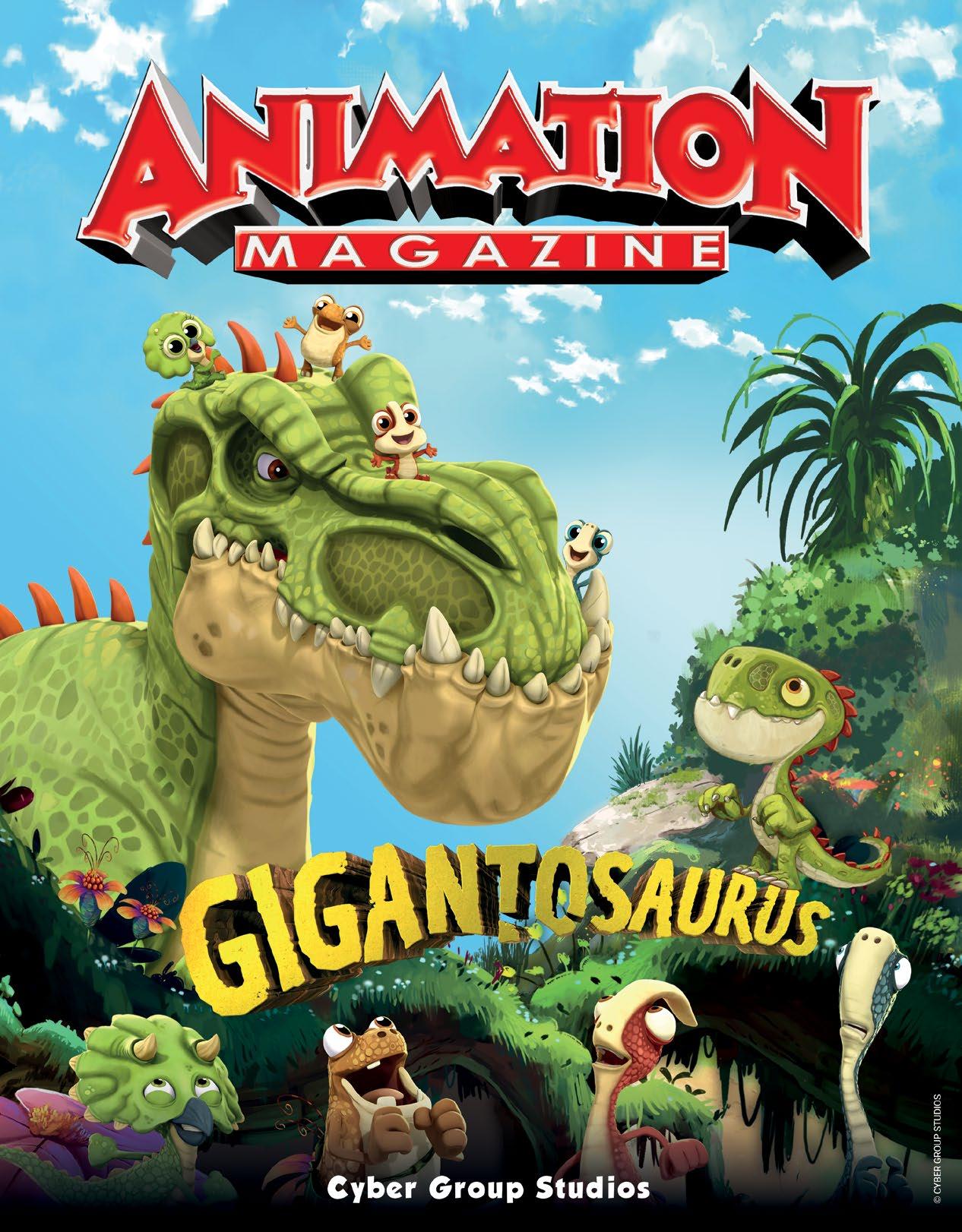
THE BUSINESS, TECHNOLOGY & ART OF ANIMATION AND VFX ™ June / July 2023 Licensing Expo
Edition

























































































































































































































ANIMATION MAGAZINE, COVER 2 FYC.NETFLIX.COM
CHARACTER VOICE-OVER PERFORMANCE Nick Kroll - Lola Maya Rudolph - Connie the Hormone Monstress
OUTSTANDING ANIMATED PROGRAM OUTSTANDING
FOR YOUR EMMY ® CONSIDERATION
®
WINNER
“EFFORTLESSLY FUNNY. Raucous and reflective without missing a beat.” COLLIDER
4-TIME EMMY
AWARD
MAYA RUDOLPH

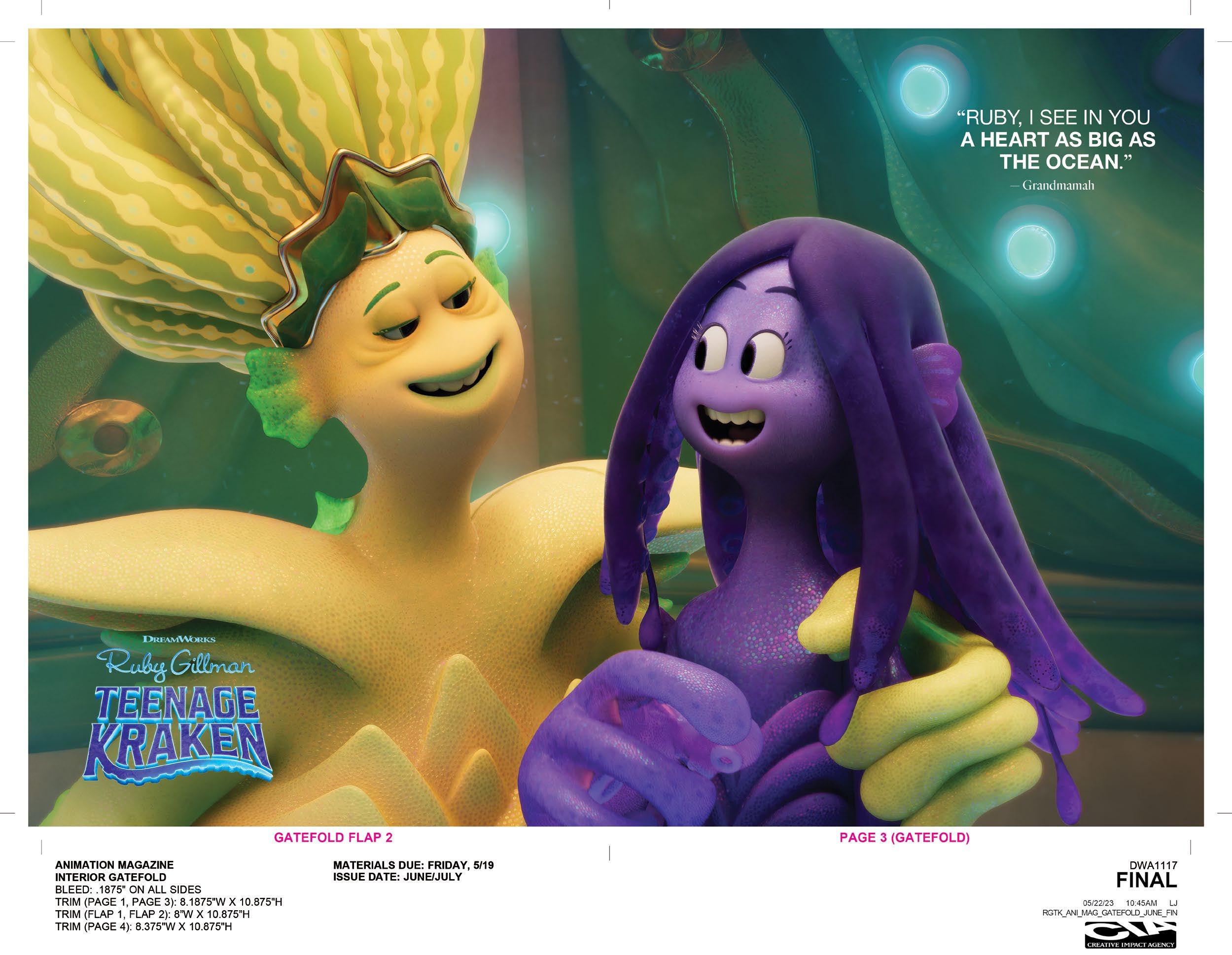
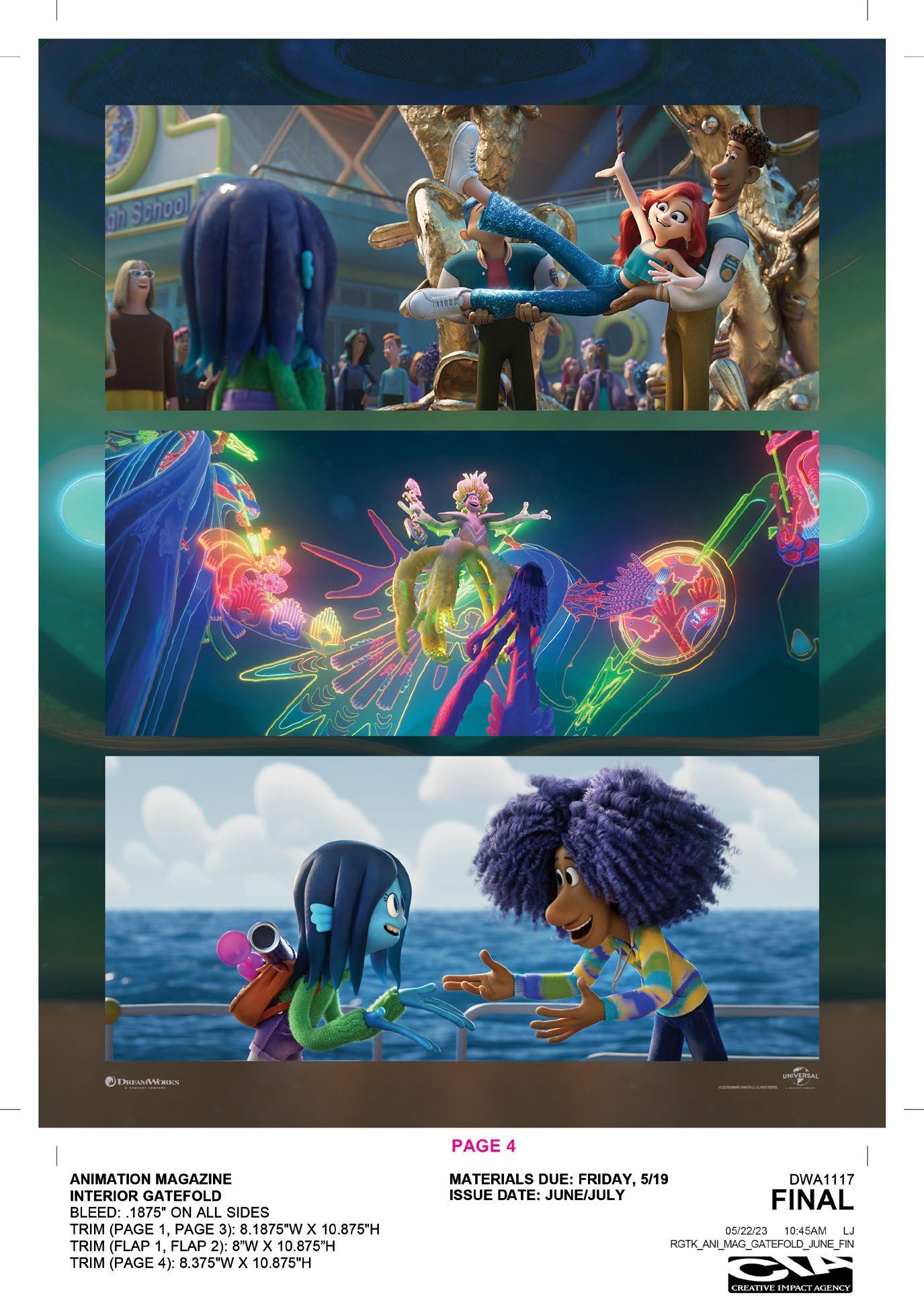



FRAME-BY-FRAME
FEATURES
SLINGING A MAGNIFICENT SEQUEL 16
How the trio of directors behind Sony’s Spider-Man: Across the Spider-Verse explored the expanding universe of Miles Morales in his second cinematic journey.

IN PRAISE OF SHAPE-SHIFTERS AND RULE-BREAKERS 20
Nimona directors Nick Bruno and Troy Quane discuss the challenges and rewards of bringing ND Stevenson’s acclaimed, LGBTQ-themed graphic novel to the screen.
FORBIDDEN LOVE AMONG THE ELEMENTS 24
Director Peter Sohn and the team behind Pixar’s summer feature Elemental offer insights into their special creative process.
A SWEET SEA MONSTER SURFACES 28
The team behind DreamWorks’ Ruby Gillman, Teenage Kraken discuss the creation of the mythical world and its memorable characters.
THROUGH THE LOOKING GLASS AGAIN 32
A young heroine finds a shelter from bullies in Keiichi Hara’s new animated feature Lonely Castle in the Mirror.
A NEW ADVENTURE TAKES FLIGHT 34
Cartoon Saloon’s Puffin Rock characters migrate to the big screen.
BEST ANIMATED MOVIES OF THE 21ST CENTURY (SO FAR) 36
A few of our favorite animation players and critics pick their favorite features of the past 23 years.
RIDING A WAVE OF SELF-ACCEPTANCE
The veteran animation team behind DreamWorks TV’s Not Quite Narwhal deliver a whale of a tale about a unicorn under the sea.
Creators Devin Bunje and Nick Stanton take us behind the scenes of their colorful new Disney show Hailey’s On It!
FEATURES
ANNECY
SECRETS OF THE FESTIVAL’S ARTISTIC DIRECTOR! 48 Marcel Jean shares Annecy Festival’s must-see highlights for 2023.
AN ABUNDANCE OF ECLECTIC MOVIES AT ANNECY 50
Annecy Festival audiences are invited to enjoy 20 amazing animated features ready for release around the world.
SHORTS THAT LEAVE LONG-LASTING IMPRESSIONS 52
We take a look at eight of the wonderful new animated shorts curated for Annecy’s Official Selection this year.
FIRST LOOK: NETFLIX ANIMATION AT ANNECY 56

The studio will present on Chicken Run: Dawn of the Nugget, The Monkey King, Leo and more.
VR SPOTLIGHT IMAGINATION IMMERSION 58
The innovative VR projects featured in this year’s Annecy program invite audiences to participate in emotional experiences.
SLINGING A MAGNIFICENT SEQUEL
How the trio of directors behind Sony’s Spider-Man: Across the SpiderVerse explored the expanding universe of Miles Morales in his second cinematic journey.
16 IN PRAISE OF SHAPE-SHIFTERS AND RULE-BREAKERS 20
Nimona directors Nick Bruno and Troy Quane discuss the challenges and rewards of bringing ND Stevenson’s acclaimed, LGBTQ-themed graphic novel to the screen.
TELEVISION/STREAMING
RIDING A WAVE OF SELFACCEPTANCE 40
The veteran animation team behind DreamWorks TV’s Not Quite Narwhal deliver a whale of a tale about a unicorn under the sea.
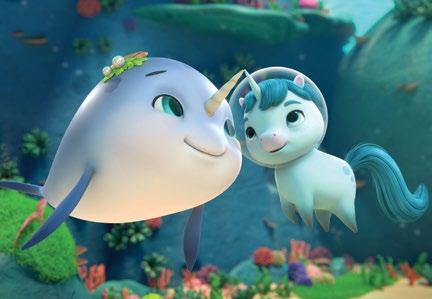
jun|jul 23 7 www.animationmagazine.net
40
42
A DOGGONE LOVABLE SHOW 44 Pupstruction
to
his
series.
IS KING 46
IT’S THE END OF THE WORLD AND SHE KNOWS IT!
creator Travis Braun tells us everything we need
know about
pawsome new Disney
COMEDY
Cyber Group studios introduces two colorful new toons at Annecy. TELEVISION/STREAMING
12
MUST-HAVE
14
ANIMATION PLANNER
June | July THE
LIST
VOLUME 37, ISSUE 6, NUMBER 331 JUNE | JULY 2023
16 40 20
SIMPLE DASHBOARDS EASY END-TO-END REVIEWS CLEAR BREAKDOWNS

INTEGRATION WITH MAIN DIGITAL CONTENT CREATION TOOLS


REACTIVE SUPPORT CLOUD OR ON-PREMISE INSTALL TAILOR-MADE OFFERS



THAN 100 STUDIOS
KITSU KITSU Collabora�on Pla�orm for Anima�on Studios
Book a demo on Bring your teams and your tools together to ship be�er content faster!
MORE
ALREADY USE
www.cg-wire.com
Pictures are from the Sprite Fright production by the Blender Studio and arelicensed under Creative Commons
MIFA visitors, please meet us at the A.11 booth!
Pixar’s beautiful new short Carl’s Date offers one final look at the bond between Up’s beloved characters.
Disney Legend Andreas Deja discusses his directorial debut, the 2D-animated fable Mushka.
A young boy copes with his father’s passing in Janice Nadeau’s lovely short, Harvey
60
Canada’s pioneering CG animation studio is ready for the future with a healthy slate of innovative shows for young viewers.
Ottawa-based studio Mercury Filmworks celebrates 25 years of beautifully crafted animated shows. A


IN
60
A GENTLE FAREWELL
Pixar’s beautiful new short Carl’s Date offers one final look at the bond between Up’s beloved characters.

LANDSCAPE
Magic Light Pictures founders Michael Rose and Martin Pope discuss the 20th anniversary of their acclaimed production company.
TERRITORY FOCUS
¡VIVA MÉXICO! 72
Innovative animated projects that reflect the culture and heritage of Mexico put the country’s talented artists studios in the spotlight.
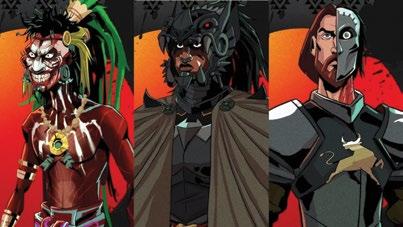
THE BELGIAN TOUCH 76
Movies such as The Inseparables and Sirocco and the Kingdom of the Winds are the latest examples of Belgium’s rich animation output.
A TIGER’S TALE 62
Disney Legend Andreas Deja discusses his directorial debut, the 2Danimated fable Mushka.
Is food in animated content as simple as green eggs and ham?
The third chapter of the Guardians of the Galaxy trilogy offers a dazzling array of state-of-the-art digital effects.
2024, Maya 2024 and Fume FX 6,0.
The popular Given anime series and movies offer a different take on high school romance.
THE BELGIAN TOUCH 76
eOne development VP Cort Lane Takes us behind the scenes of the My Little Pony: Bridlewoodstock special.
COVER A: Sony Pictures Animation’s Spider-Man: Across the Spider-Verse opens on June 2.
COVER B: Nimona, directed by Nick Bruno and Troy Quane, premieres on Netflix on June 30.
ANNECY COVER | LICENSING EXPO COVER: Cyber Group Studios’ Gigantosaurus continues its global prehistoric reign.
Movies such as The Inseparables and Sirocco and the Kingdom of the Winds are the latest examples of Belgium’s rich animation output.
jun|jul 23 9 www.animationmagazine.net
VOLUME 37, ISSUE 6, NUMBER 331 JUNE | JULY 2023
60 76
IN THE LIFE DAY IN THE LIFE OF...
DAY
112
VFX & TECH OUT OF THIS WORLD 106
TECH REVIEWS 108 3ds Max
STATE OF THE ART 102 Can animation render a more sustainable production future? ANIMATED MUSINGS 104
OPPORTUNITIES
A GENTLE FAREWELL
A TIGER’S TALE
62
SAYING GOOD-BYE TO PAPA 64
SHORTS MAINFRAME AT 30 66
SILVER ANNIVERSARY
68
A
FOR NORTHERN STARS
MILESTONES HITTING THE RIGHT NOTES 110
BRIGHT LIGHT
THE ANIMATION
70
HOME ENTERTAINMENT SHORTS 62 ¡VIVA MÉXICO! 72 TERRITORY
72
FOCUS Innovative animated projects that reflect the culture and heritage of Mexico put the country’s talented artists studios in the spotlight.
In Praise of Untraditional Heroes
If you’re a fan of Disney’s 1964 Mary Poppins, you will remember the scene in which Jane and Michael Banks are watching their mysterious nanny (Julie Andrews) produce an astonishing number of items out of her magic carpet bag. Well, this summer, we’re all a lot like the wonderstruck Banks kids as we watch a dazzling number of animated movies, TV series and shorts appear in theaters, at festivals and on our home screens.
Among the many reasons we are in toon geek heaven this month are Sony Pictures Animation’s much-anticipated sequel Spider-Man: Across the Spider-Verse. Our cover story, penned by our talented writer Devin Nealy, paints a great picture of how the film’s trio of unfairly super-gifted directors (Joaquim Dos Santos, Kemp Powers and Justin K. Thompson) managed to raise both the technical and emotional quotient for Miles Morales’ second big screen adventure. I can’t wait until everyone discovers all the mind-boggling characters, worlds, Easter eggs and glorious visuals this movie is bringing to theaters this month.

Then, of course, we have Netflix and the team at DNEG unveiling their labor of love Nimona on June 30. Directed by Nick Bruno and Troy Quane, this high-energy and very rebellious adaptation of ND Stevenson’s graphic novel is bound to have people talking with its take-no-prisoners attitude, unconventional heroine and its subtle depiction of an LGBTQ main character. You can learn all about the making of the pic in Jeff Spry’s insightful article. We’re sure Florida Gov. Ron DeSantis can’t wait to add the movie to his Netflix queue!
JUNE | JULY 2023 VOL. 37, ISSUE 6, NO. 331 info@animationmagazine.net
President & Publisher: Jean Thoren
Accounting: Jan Bayouth
EDITORIAL
edit@animationmagazine.net
Editor in Chief: Ramin Zahed
Multimedia Editor: Mercedes Milligan
Webmaster: Damaso Abrajan
Asst. Webmaster: Lucy Abrajan
Tech Reviews Editor: Todd Sheridan Perry
Contributors: Christian Bermejo, Mary Bredin, Kévin Giraud, Trevor Hogg, Karen Idelson, Tom McLean, Jessie Nagel, Devin Nealy, Charles Solomon, Jeff Spry, Ellen Wolff
ADVERTISING SALES
Sheri Shelton sales@animationmagazine.net
Sales Coordinator: Tracey Hollingsworth
EVENTS
kim@animationmagazine.net
Director: Kim Derevlany
CREATIVE
prod@animationmagazine.net
Creative Director/Production Manager: Susanne Rector

Fab Four: (Clockwise from top left) Spider-Man: Across the Spider-Verse; Nimona; Ruby Gillman, Teenage Kraken; Elemental

Any other month, we would have also put Pixar’s stunning Elemental and DreamWorks’ glorious Ruby Gillman, Teenage Kraken on the magazine cover. Sadly, there’s only so much editorial real estate to cover all these wonderful movies. Fortunately, you can read Karen Idelson and Tom McLean’s excellent stories about these two very imaginative films in this issue as well. And make sure you also check out the online versions of these pieces on our website, as they tend to be longer and feature more dazzling visuals to accompany the words. That’s just the tip of the iceberg, folks. This is also our big Annecy Festival edition, so you can find out more about all the fantastic screenings, movie and short premieres, panels and work-in-progress presentations. We also have two special territory spotlights on the exciting animation scenes in Mexico and Belgium in this issue. And don’t forget to check our website during the super busy festival week (June 11-17), because our roving reporters are planning to bring you the latest news, sneak peeks and image reveals every day.
We hope you enjoy our big summer preview issue. If you are lucky enough to be at Annecy, try and see as much as you can and enjoy all the great conversations about our favorite art form. And if someone gives you a hard time for liking a certain short or a movie that nobody else seems to find very special, remember the wise words of Mary Poppins (and author P. L. Travers), “Don’t you know that everybody’s got a Fairyland of their own?”
Ramin Zahed Editor in Chief ramin@animationmagazine.net

ACCOUNTING/CIRCULATION
circ@animationmagazine.net
Circulation Director: Jan Bayouth
SUBSCRIPTIONS
For account changes, renewals, cancellations, questions or comments: anics@magserv.com
SUBSCRIPTION CUSTOMER SERVICE
Animation Magazine | PO Box 16225 | North Hollywood, CA 91615-6625 | Phone: (818) 286-3199 anics@magserv.com
TO ADVERTISE:
Phone: 818-883-2884
Fax: 818-883-3773
Email: sales@animationmagazine.net
Website: www.animationmagazine.net
ANIMATION MAGAZINE (USPS 015-877/ISSN 1041-617X)
Published monthly except for combined issues of June/July and September/October, by Animation Magazine * 24943 Kit Carson Road Calabasas, CA 91302
Periodicals postage paid at Woodland Hills Post Office CA, and additional mailing offices.
POSTMASTER: SEND ADDRESS CHANGES TO MAILING ADDRESS: ANIMATION MAGAZINE 26500 W. Agoura Rd. Ste. 102-651 Calabasas, CA 91302
TO SUBSCRIBE: For the U.S., the rate is $60 for 1 year or $95 for 2 years. Rates for Canada and Mexico are US$75 for 1 year or US$120 for 2 years delivered by foreign airmail. Foreign rates are US$90 for 1 year or US$145 for 2 years delivered by foreign airmail. Please allow six to eight weeks for initial delivery. Also available in a digital version for $36 for 1 year or $60 for 2 years.
Animation Magazine © 2023 Animation Magazine
Prior written approval must be obtained to duplicate any and all contents. The copyrights and trademarks of images featured herein are the property of their respective owners. Animation Magazine acknowledges the creators and copyright holders of the materials mentioned herein, and does not seek to infringe on those rights.
www.animationmagazine.net 10 jun|jul 23
“ Question everything. Don’t try to emulate someone else’s path. Look at what you have, the tools you have, the place you’re in; know the rules, and break them. ”
— ND Stevenson, creator of Nimona
QUOTE OF THE MONTH
FROM
THE EDITOR

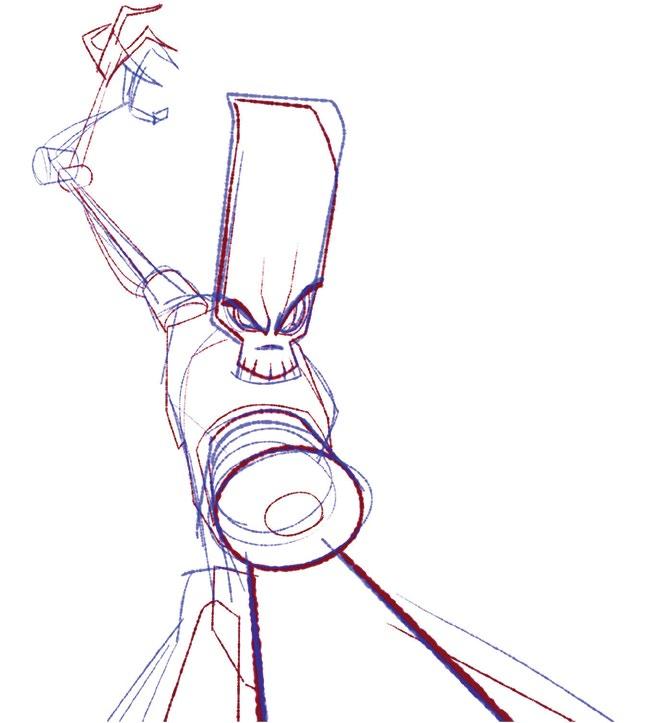
Bring your stories to life Creating award-winning software for animation and storyboarding. The world’s largest 2D animation studios choose Toon Boom to bring their TV series and feature films from ideation to screen. toonboom.com
Animation Planner
June
1 Netflix premieres its ninja-battlin’ spinoff series Ninjago: Dragons Rising today.

2 Summer blockbuster season comes out swinging with Spider-Man: Across the Spider-Verse, the sequel to Sony Pictures Animation’s groundbreaking Oscar winner.
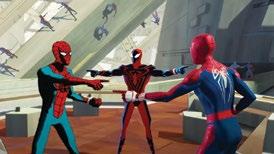
3 Head to Brooklyn to celebrate Animation Block Party’s 20th anniversary with a special event at BAM Film. [animationblock.com]


5 Animafest Zagreb presents another artistic, eclectic collection of shorts and features in Croatia. [animafest.hr]
8 Moana’s Auli’i Cravalho stars in Hailey’s On It!, the new Disney TV Animation comedyadventure.
9
This month’s Studio Ghibli Fest offerings are Nausicaä of the Valley of the Wind (July 9 & 11) and Castle in the Sky (July 10 & 12).

9 The second and final season of Human Resources drops on Netflix.
11
GKIDS and Fathom Events present Kiki’s Delivery Service on the big screen as part of Studio Ghibli Fest 2023, for three nights only (June 11, 12 & 14).

12
The world’s largest dedicated animation event, the Annecy Festival, brings the toon diaspora together in the French Alps for six glorious days! [annecyfestival.com]


13
Spot the next big merch sensation amid the colorful characters at Licensing Expo in Las Vegas this week.
16
Theaters heat up with Elemental, the latest animated tour of a wonderous, imaginative world from the alchemists at Pixar. Also out today is Wes Anderson’s Asteroid City, which promises to include some animated elements, and Disney+ doc Stan Lee.

29
Henry Cavill takes his final turn as Geralt of Rivia in The Witcher Season 3 Vol. 1 on Netflix today, with Vol. 2 dropping July 27. Adieu, sweet mutant!
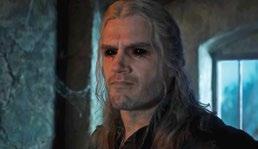
30
Another big weekend at the cinema as DreamWorks Animation unleashes Ruby Gillman, Teenage Kraken, while Harrison Ford returns in Indiana Jones and the Dial of Destiny
July
12
Cool off at the movies this month with a few VFX-enhanced spectacles. Today you can catch Mission: Impossible - Dead Reckoning Part One, but be sure to factor Barbie and Chris Nolan’s Oppenheimer (both out July 21) as well as Disney’s Haunted Mansion into your popcorn budget.
17
Anibar holds its 14th international animation festival for seven inspiring days in the scenic mountain-ringed city of Peja, Kosovo. [anibar.org]
To get your company’s events and products listed in this monthly calendar, please e-mail edit@animationmagazine.net.
www.animationmagazine.net
12 jun|jul 23
Ninjago: Dragons Rising
Spider-Man: Across the Spider-Verse
Kiki’s Delivery Service
Elemental Hailey’s On It!
Human Resources
The Witcher
Ruby Gillman, Teenage Kraken
Nausicaä of the Valley of the Wind
FRAME-BY-FRAME
Barbie
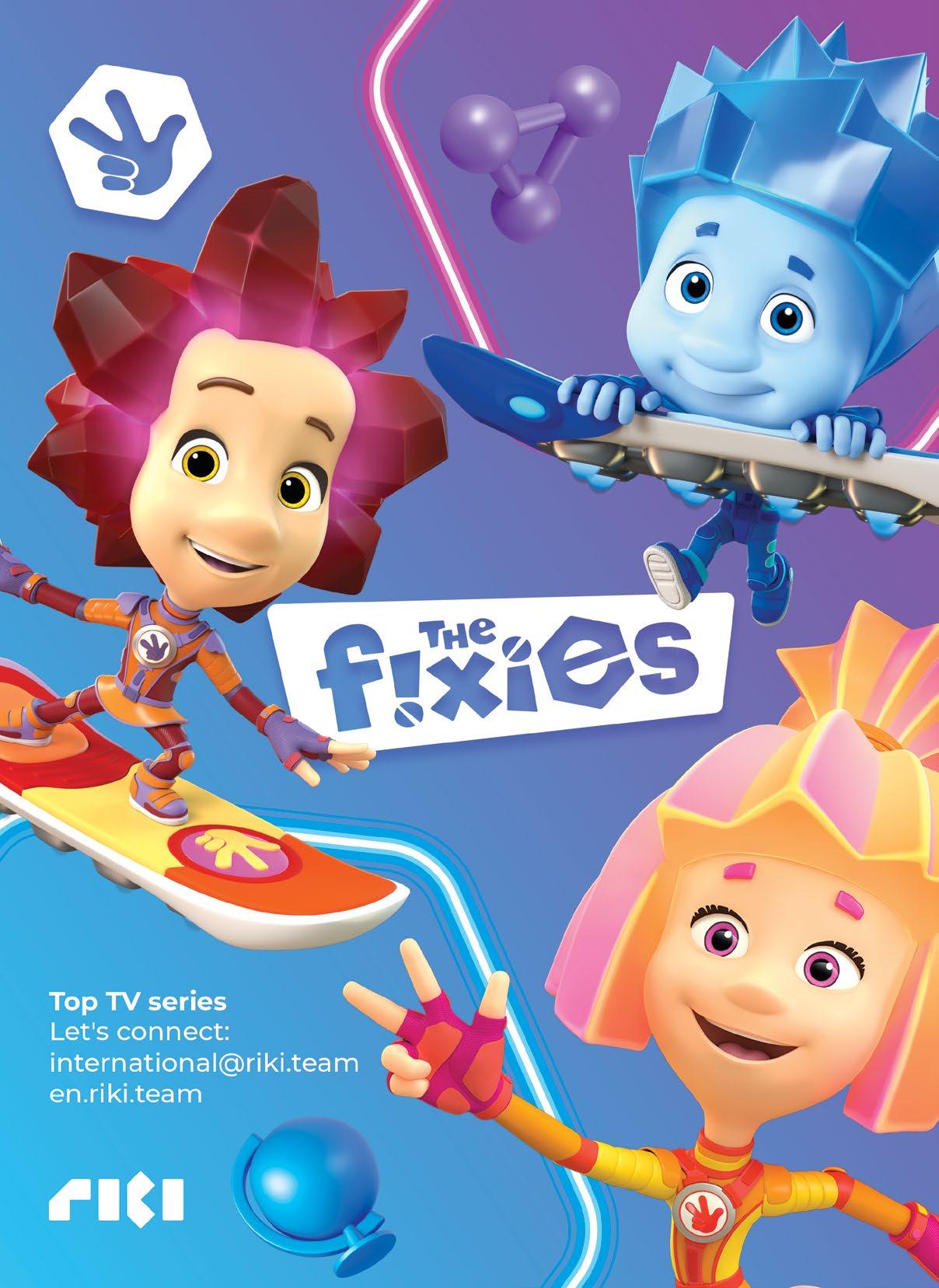
The Must-Have List
Unicorn Wars

From the brilliantly bizarre mind of celebrated Spanish comic artist and animator Alberto Vázquez comes a twisted, technicolor takedown of militarism and zealotry, told as a black comedy about a war between bellicose teddy bears and their unicorn foes. The Goya Award-winning feature comes home with a director interview, feature-length animatic and “Working in Blender” featurette. [Shout! Factory | $23 BD]
Looney Tunes Collector’s Choice Vol. 1

Celebrate hare-raising highlights of Warner Bros.’ 100-year history with this collection of animated gems. Restored, remastered and uncut, Vol. 1 features 20 golden toons from 19451959, featuring Bugs Bunny, Daffy Duck, Porky Pig, Wile E. Coyote, Foghorn Leghorn and more including some classics that have never before appeared on home video. [Warner | $22 BD]
The Art of Disney-Pixar Elemental
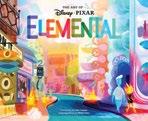
Take a virtual stroll down the fantastical streets of Element City and explore the behind-the-scenes artistry of Pixar’s newest super-ambitious animated world. Through 170-plus pages, soak up exclusive production artwork, making-of details and stories from the artists and creative leads bringing this ultimate opposites attract tale to screens. Featuring a foreword by Pixar CCO Pete Docter and introduction by director Peter Sohn. [Chronicle Books | $43]
Hidetaka Tenjin’s Artistry of Macross
Macross Frontier Films, Macross Delta & Archives
Pore over the artistic details of the high-flying “variable fighters” from the hit franchise, offering a masterclass in vehicle and mech design from the longtime Macross illustrator. The hardcover features more than 140 pages of Tenjin’s hyper-realistic work for model kits, magazines, promotional materials and other content for the anime classic, which made its television debut in 1982. [Udon Ent. | $50]

Marvel HQ
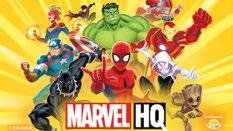
An edutainment hub has launched for true believers in training! The new app from Team17 Group’s Story Toys and Marvel Ent. offers kids 4-7 a place to connect with their favorite superheroes through fun activities, image archives and fun facts, digital comics and stories, coloring tool and drawing tutorials, plus videos related to popular Marvel toons like Spidey and His Amazing Friends and Moon Girl and Devil Dinosaur [Available from the App Store, Google Play and Amazon.]
The Venture Bros.: The Complete Series

For the first time ever, the bombastic heroes and outrageously outré super villains of Doc Hammer and Chris McCulloch’s Adult Swim fan-favorite come home in a comprehensive set, collecting all seven seasons (82 episodes) on 14 discs. From “Dia de los Dangerous” to “The Saphrax Protocol,” relive the show’s 20-year journey ahead of the new movie debut later this year, complete with all previously released special features. [Warner | $130 DVD | June 13]
Timex X Peanuts

Celebrate a timeless comic strip classic with a classic timepiece! This fresh collection offers a wide range of colors, characters and themes, from sporting hobbies to holidays and beyond, with new designs on the way. Prices range from $65 (like the charming Charlie Brown 38mm Fabric Strap Watch) to $109. [timex.com]
Draw Chibi Style

A beginner’s guide to adorable mini characters and effects drawing in 62 lessons, created by popular Vietnamese artist Piuuvy. [Quarry Books | $20]
Shonen Baby
Given the prompt “platinum-selling rapper Lil Baby and AXE body spray have a new collab,” you might not immediately guess it’s an exclusive digital manga for Walmart — but it’s true. It happened. Featuring artwork from Passion Pictures and Future Power Station, can you afford to miss out on this piece of pop culture history?
[Available with proof of AXE purchase from Walmart from March 1-June 15, 2023] ◆

www.animationmagazine.net 14 jun|jul 23
— Mercedes Milligan
FRAME-BY-FRAME
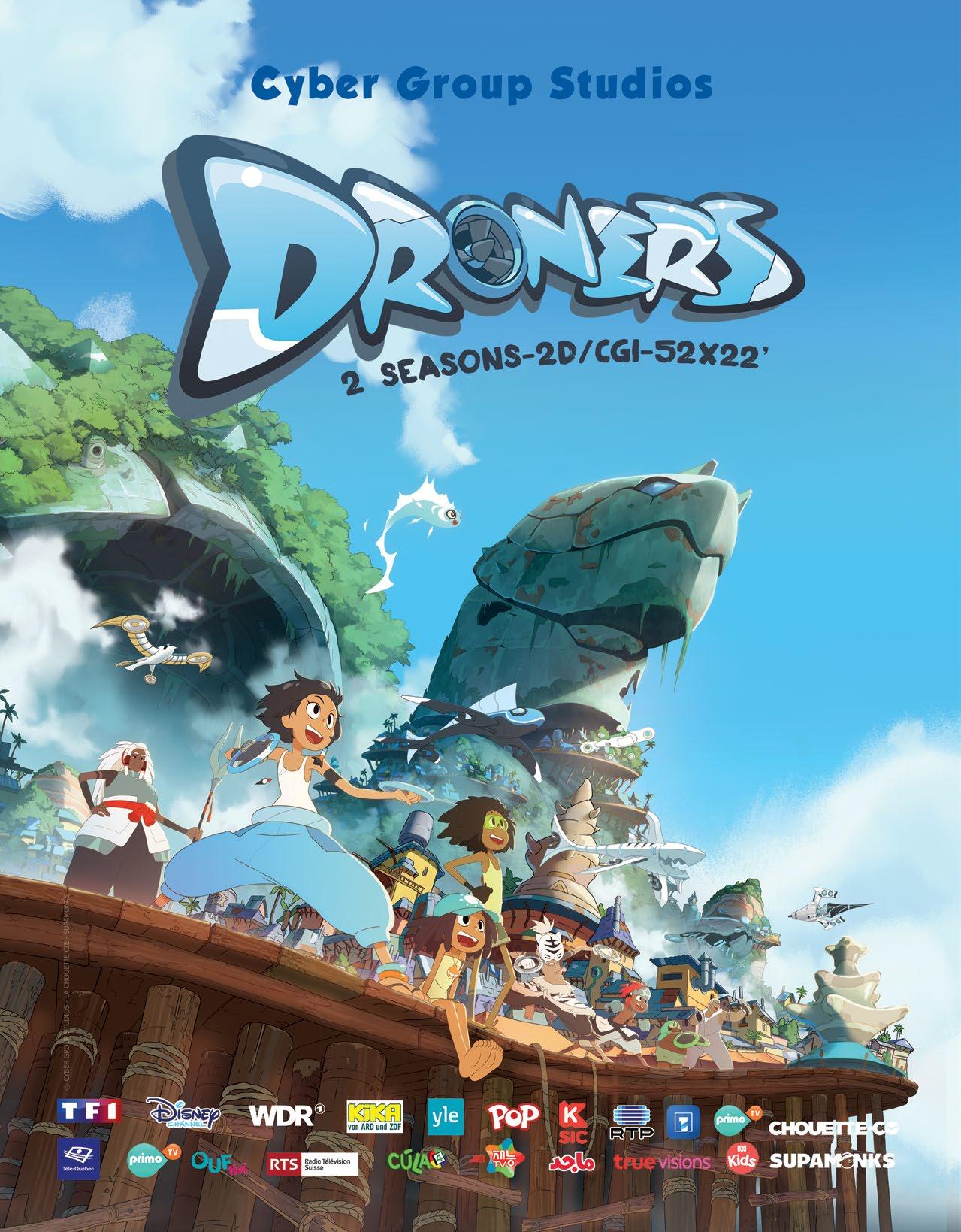
Slinging a Magnificent Sequel
How the trio of directors behind Sony’s Spider-Man: Across the Spider-Verse explored the expanding universe of Miles Morales in his second cinematic journey.
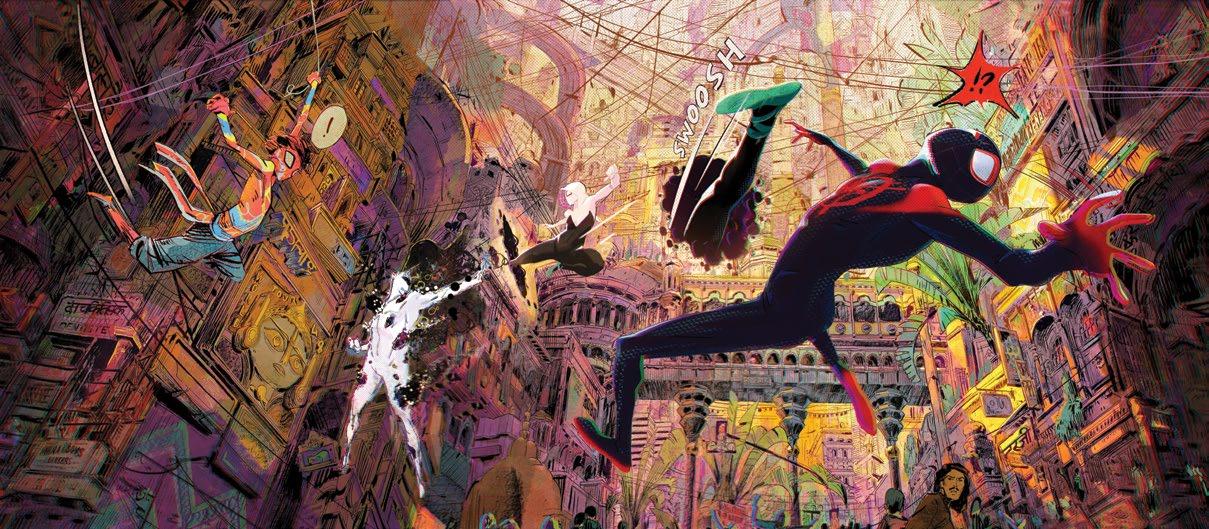 - By Devin Nealy -
- By Devin Nealy -
Throughout his legendary career, Stan Lee, Spider-Man’s iconic co-creator, frequently cited the character’s ability to transcend race and culture as the primary key to his enduring global popularity. “What I like about the costume is that anybody reading Spider-Man, in any part of the world, can imagine that they themselves are under the costume,” said Lee. “And that’s a good thing.”
With 2018’s groundbreaking feature film, Spider-Man: Into the Spider-Verse, Sony Pictures Animation and the accomplished writing team of Chris Miller and Phil Lord sought to put the quote to the test by making Miles Morales, an Afro-Latino variant of Spider-Man, the film’s protagonist and transitioning Peter Parker into the role of a mentor. For the sequel, Spider-Man: Across the Spider-Verse, co-directors Kemp Powers, Joaquim Dos Santos, and Justin K. Thompson aim to double down on Lee’s theory by enveloping even more cultures and perspectives into Spider-Man’s massive and ever-expanding web. “I think one thing this film will do is show that what it means to be a hero is

a lot of different things to a lot of different people,” says Dos Santos.
With Great Power
Spider-Man: Across the Spider-Verse follows the continuing adventures of Miles Morales (Shameik Moore) as he struggles to balance his responsibilities as a student, son and superhero. Complicating matters even further is the return of Miles’ crush, Gwen “Spider-Woman” Stacy (Hailee Steinfeld), who enlists our hero’s aid to combat The Spot (Jason Schwartzman), a villain that poses a threat to every Spider-Person in the multiverse. As the duo delves deeper into the eponymous Spider-Verse, they encounter an array of beloved and obscure characters from Spider-Man’s complex comic-book mythology that are guaranteed to delight diehard fans of the Web Head.
Among the legions of comic-book loyalists Spider-Man: Across the Spider-Verse seeks to satiate are the directors helming the film, as all three men are avid fans of the medium. Co-director Justin K. Thompson, the production designer for the first film, credits an unconventional job at a local comic shop for
stoking his youthful passion for illustration. “I was only 14, so the owner couldn’t actually hire me,” says Thompson. “So, he finally agreed to pay me under the table in free comics.”
After his “shifts,” Thompson would spend hours redrawing his comics in the pursuit of mastery. “In that very real sense, comic books taught me how to draw and tell stories,” he says. “So, to be going full circle, making films about one of my favorite comic-book characters of all time, Miles Morales, is all a little bit surreal.”
Like Thompson, it was Dos Santos’ affinity for the character of Miles Morales that initially enticed him to join the franchise. “I had met [with Sony] really, really early on, before the first film started, about if I would be interested in being a part of a Spider-Man anything,” says Dos Santos. “Of course, the answer was yes, but look, I’ll be the first to say it, there’s a lot of Spider-Man material out in the world.”
During a meeting with Phil Lord, who is one of the film’s producers and writers, Dos Santos discovered the hook that eventually drew him into the Spider-Verse. “I was midway through the meeting with Phil, and he was like, ‘What if it was Miles Morales?’” says
Dos Santos. “Now I’m interested, because this feels fresh; it feels like something different.”
Despite his desire to be on the project, timing prohibited Dos Santos from joining Spider-Man: Into the Spider-Verse, which coincidentally mirrored the experience of his co-director Kemp Powers. “I was still at Pixar working on Soul,” recounts Powers. “People would bring movies to screen at Pixar, so during one of our lunch breaks, it was the Spider-Verse crew bringing Into the Spider-Verse.”
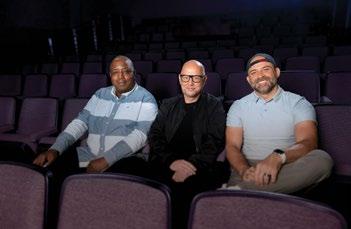
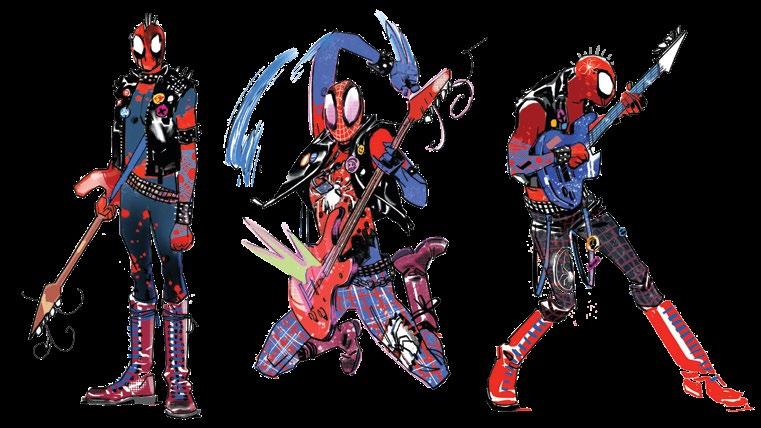



The quality of the then-unreleased footage impressed Powers so significantly that he

“You want everyone in the world to leave the movie theater and imagine that they live in a world where they have a Spider-Man in their neighborhood.”
— Kemp Powers, director
HEROES AND VILLAINS: Sony’s dazzling sequel introduces audiences to several new dimensions and a wide range of Spider-heroes and villains, including (left) SpiderGwen, The Vulture, Spider-Man 2099 and (below) the very cool Hobie Brown a.k.a. Spider-Punk.
From left, directors Kemp Powers, Joaquim Dos Santos and Justin K. Thompson.
couldn’t shake the urge to collaborate with Sony in the future. Fortunately for Powers, the unique COVID protocols imposed during his time on Soul allowed him to work remotely, return to L.A. early and eventually meet with Miller and Lord. “So, they were just like, ‘Yeah, we’re doing a sequel to Spider-Verse, and would you have any interest coming on board?’” says Powers, who jumped at the chance. “We wrapped on Soul on a Friday, and that Monday, I was on Spider-Verse. So, I was actually working on this sequel before Soul was released.”
Great Responsibility
Creating an animated feature is already a taxing endeavor, but aiming to follow up on one of the most successful Spider-Man films of all time carries a specific pressure. “I do animation and live action, and there are unique challenges to animation born of things that make animation so special, and that’s the iterative process,” says Powers. “You’re creating then recreating, you make it and then you blow it up. Then you start over again ... and


again, and again, and again.”
For Dos Santos, Across the Spider-Verse helped dispel his long-standing misperceptions about feature filmmaking. “I came from TV, where once that faucet is turned on, those episodes are going, and if you didn’t get it on episode three, you’ll make up for it on episode seven,” says Dos Santos. “The grass always seemed greener in features, where it was like, ‘Man, they get to sharpen every idea into this razor-thin thing.’ And then you get in it, and you get it pretty dang sharp, and everyone goes, ‘Wow, it’s great. Let’s destroy it and try something completely different.’”

One of the differences that Thompson implemented to help distinguish Across the Spider-Verse from its predecessor is the project’s breathtaking visual vocabulary. “While I was making the first film, I leaned on classic comic-book techniques to describe Miles Morales’ world,” says Thompson. “When he travels across the Spider-Verse, I wanted the look of each dimension he visits to emulate the comic-book origins of different characters he meets.”

When discussing Thompson’s decision to create contrasting aesthetics for each Spider-Person, Powers couldn’t suppress his enthusiasm for one character in particular. “I think Spider-Punk’s [Daniel Kaluuya] design is probably one of the most bold designs we’ve got of a character,” says Powers. “He’s basically a living punk rock poster that, even when he’s standing still, is constantly in motion.”
Does Whatever a Spider Can
As the trio ventured deeper into Across the Spider-Verse, it became clear that the film needed to be split into two halves. “Even when I came on board, it was always the idea that it was going to be a trilogy,” says Powers. “As the breaking and rebreaking of this film happened, we realized what was initially conceived as one film was actually two films.”
“It wasn’t for lack of trying to make it one film, though,” jokes Dos Santos. “We screened a version of this that had so many ideas in it that by the end, people were just sitting in their seats bewildered, like, ‘Did that all just happen
VISIONARY DESIGNS: The movie’s artists were inspired by the futuristic designs of Syd Mead, the colorful streets of Mumbai and Brutalist architecture as they set out to build its different worlds. Left, cute baby Mayday Parker is the youngest member of the Spidey family. Next page: Spider-Woman bursts onto the screen on a fiery motorcycle.
Some Spidey Fun Facts
• The work of futurist designer Syd Mead, who contributed to the designs of Star Trek the Movie, Blade Runner and TRON, was a big inspiration for the look of Miguel O’Hara’s city of Nueva York on Earth-928.
• Director Justin K. Thompson first worked with producers Phil Lord and Chris Miller on their directorial debut, Sony Pictures Animation’s Cloudy with a Chance of Meatballs
• The worlds of the haves and have-nots in Earth-928 are separated visually and physically. The above-ground population live in an idealized world of blues and clean lines, while the underground world is darker and brutalist in nature.

• The visual artists behind the hybridized world of Mumbattan had to empty out the East River in order to create a giant chasm where the city is built, level upon level — which creates a visually stunning backdrop for the Spider-folks to move through.
• The filmmakers pay homage to some of the movies that have inspired them visually throughout the sequel. Fans of great cinema will be able to find subtle homages to classics from Blade Runner and TRON to Akira and Heat in this visit to the Spider-Verse.

• You’re never too young to know your Spidey villains! Look for cute plush versions of Doc Ock and Green Goblin in baby Mayday’s crib.
• The look of the Vulture was inspired by Leonardo da Vinci’s insightful illustrations of winged flying machines from the late 15th century.
• The visuals for Ben Reilly (Scarlet Spider, voiced by Andy Samberg) were inspired by comic books from the 1990s.
in front of our eyeballs right now?’”
To wrangle all the concepts tucked in the film, Thompson and a crew of over 900 animators worked tirelessly to create several new literal and figurative dimensions for Across the Spider-Verse. “The team at Imageworks created hundreds of new tools to bring the different worlds and characters to life,” says Thompson. “They developed a way to make it seem like an artist was painting the picture in real time, moving their brushes and dripping paint across the screen behind the characters.”
Through innovative animation techniques, Thompson paid tribute to the comic artists who helped create the inspiration for the film’s characters. “My favorite tools they developed were the ones that were based on the work of individual comic-book artists, like Rick Leonardi for Miguel’s [Spider-Man 2099, voiced by Oscar Isaac] look, or Brian Stelfreeze for Jessica Drew’s [Spider-Woman, Issa Rae] look,” says Thompson. “We worked closely with those artists to develop tools that could translate the way they did their linework and their textures so that it could be applied to the 3D look of the characters.”
Beyond emulating the style of comic artists, the directors aimed for authenticity regarding cultural nuance. “We had an early version of the first scene with Pavitr (Spider-Man from India) [Karan Soni], and it just didn’t land, and we assembled a special room of various Indian voices — writers, comedians, artists — to rebreak the whole scene,” says Powers. “And what was once one of the scenes that didn’t work, in my opinion, turned into one of the most awesome moments and characters in the movie.”
The team’s dedication to Pavitr’s scene serves as a microcosm for the franchise’s working thesis that anyone can be Spider-Man. “I know this is like an arrogant, hopeful, boastful thing, but you want everyone in the world to leave the movie theater and imagine that they live in a world where they have a Spider-Man in their neighborhood,” says Powers. “Whether they’re in a city or the country, America or India … I want people to feel like this is a world where they’re all a part of it.”
Sony Pictures Animation’s new epic Spider-Man: Across the Spider-Verse opens in theaters nationwide on June 2.
◆
In Praise of Shape-Shifters and Rule-Breakers

Nimona directors Nick Bruno and Troy Quane discuss the challenges and rewards of bringing ND Stevenson’s acclaimed, LGBTQ-themed graphic novel to the screen.
- By Jeff Spry -
Rescued from the perilous halls of abandoned animation projects by those shining knights at Netflix, the queer-coded fantasy-adventure feature Nimona will ride onto the streaming service this summer after a world premiere (June 14) at the Annecy International Animation Film Festival.
Nimona has followed a boldly circuitous and slightly controversial path to finally becoming a completed animated movie on the Netflix platform. Let’s dial the Wayback Machine to 2012, when writer ND Stevenson created a popular webcomic series about a gay knight named Lord Ballister Blackheart in a techno-medieval society, who teams up with a quirky shape-shifting teen called Nimona to help prove his innocence after being framed for murdering the walled kingdom’s noble queen.
Rights to the award-winning graphic novel collection were first picked up by 20th Century Fox’s Blue Sky Studios, the makers of the Ice Age movies. Oscar-winning director Patrick Osborne (Feast, Pearl) was attached to direct
the project at the time. However, when Disney officially acquired the Connecticut-based shop in 2019, Blue Sky became one of the unfortunate casualties of the merger and the 75 percent finished Nimona project had its plug swiftly pulled in 2021.
Nick and Troy Take the Reins
Plucked from turnaround hell by Netflix and Annapurna Pictures and helmed by Spies in Disguise directors Nick Bruno and Troy Quane, Nimona is primed to premiere as the first main-


stream animated movie to prominently tackle LGBTQ themes and main characters.
The movie features the voices of Chloë Grace Moretz, Riz Ahmed and Eugene Lee Yang. Karen Ryan, Julie Zackary and Roy Lee are the CG-animated film’s producers alongside executive producers Megan Ellison, Robert L. Baird, Andrew Millstein and John Powers Middleton.
ND Stevenson, whose collaboration was mostly on the writing side, praises the involvement of directors Bruno and Quane in sticking with this extremely personal adapta-
tion to its finish.
“I did several passes on the script, and I was consistently given the most recent cut of the animatic,” he tells Animation Magazine. “They were always receptive to my notes, but also voiced their own opinions in a way that I really respected. The version that Nick and Troy visualized was getting back to the heart of the story, cutting away a lot of the needlessly complicated stuff and presenting the simplest version of it, which is so emotional and powerful.”
In today’s divisive world where anything and everything is debated, dissected and decidedly set aflame, the veteran directors’ focus was staying totally true to the edgy original material.
“This is a story about acceptance,” Quane
explains. “It’s a love letter to all those who’ve ever felt different and misunderstood. They just want to be seen for who they truly are, and that’s a universal thing. I know we’ve all felt and experienced that, but there are groups of people out there who feel that more than the average person. Our whole journey has been to do that story with dignity, with authenticity and in a way that is just fun, funny and very relatable.”
Nimona’s sci-fi/fantasy hybrid kingdom is beautifully rendered by the folks at DNEG, with a distinct design aesthetic, shape language and color palette infused into the production.

“The world that Aidan Sugano and his production design team on the film pulled from
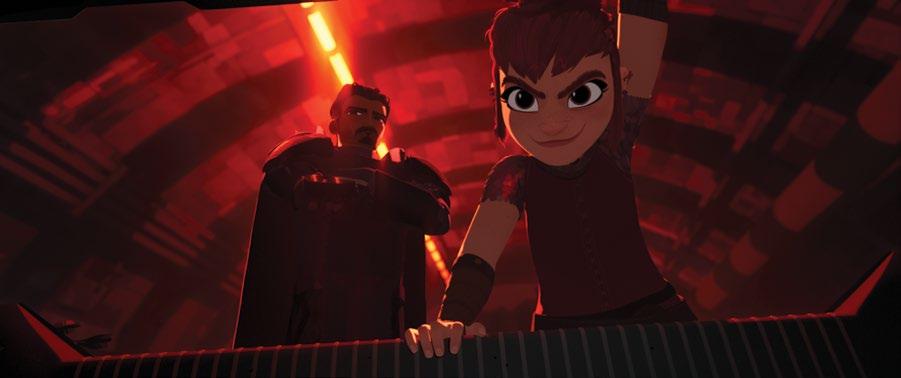


the graphic novel was gorgeous,” notes Quane. “As soon as we saw it, we were blown away. It was something very different. It was irreverent. It was fun and surprising. But I think as importantly, it was kept on theme. All those choices support the journey that the characters are going through. And that makes it feel right as you’re watching it.”
The pink-hued animal transformations of the titular character can take the form of everything from a rhino to a flamingo to a whale, and represent the core of the feature’s broad humor.
“The colors are such an important thing. Nimona is this very specific pink,” he adds. “She can be anything she wants. But she chooses to represent herself with that. She wants to be
“ND is one of the best to have worked with. He’s done a great job of telling us what’s important to him and it’s really the story of Nimona It’s like he’s given us these action figures from his own sandbox and told us to play, to bring something new to it.”
- Director Nick Bruno
REBEL YELL: Nimona is described by creator ND Stevenson as a love letter to anyone who has ever felt different and misunderstood. The film centers on the adventures of a spunky shapeshifter (voiced by Chloë Grace Moretz) and a gay knight named Ballister Blackheart (Riz Ahmed).
noticed, and that color pink, as you watch the film and depending on what her emotional state is, will become more and more included in the color of the film. Or conversely, the more desperate and lost she starts feeling, the more color actually starts to drain from the world, and she becomes this barometer for that feeling of the thematics of the story.”
He notes, “This chromatic aberration happens when she’s at her happiest. Around all the blooms of light you get into the prismat-
ic colors of the rainbow that start to drive through. We really worked with Aidan to find those areas where the color set the tone for whatever was happening in the story. Same with light and dark. All these choices, while beautiful and aesthetic, support where the journey of the story is going.”
A New Production Hub
Acclaimed international VFX and animation studio DNEG Animation (Ron’s Gone Wrong, En-




tergalactic) came on board after the project’s resurrection by Netflix and Annapurna.
“Originally, we were at Blue Sky, and with the merger with Disney they were no longer together. We had to find a great partner to actually finish the film for us, and that was DNEG,” Bruno notes. “The major reason why we decided to work with them is that they weren’t trying to sell us on, ‘We can do anything you want.’ They sold us on loving the movie, believing in the heart and believing in that mes-

“The world that Aidan Sugano and his production design team on the film pulled from the graphic novel was gorgeous. As soon as we saw it, we were blown away. It was something very different, irreverent, fun and surprising.”
- Director Troy Quane
PINK POWER: After the closing of Blue Sky Studios, Nimona faced an uncertain future until it was rescued by Netflix and DNEG, which created a distinct design aesthetic, shape language and color palette inspired by Stevenson’s comic.
sage of acceptance. And they nailed it. In every scene, everything has a purpose and meaning and, particularly when it came to animating it, you feel those characters alive in a way that brings people to tears.”
It’s hard not to notice that the aesthetics of Nimona do have their feet straddled between a classical 2D Disney sheen and a more modern 3D appeal in its depiction of environments that artfully blend 21st century technology with a traditional medieval city.
“Yeah, how crazy is a medieval future?” asks Quane. “You couldn’t get further apart on a timeline. People have cell phones and peasants are still wearing hand-woven clothes. It was such a dichotomy and so much fun to play with. But everything comes back to what you’re trying to say on screen. It’s this idea of a kingdom that’s moved forward in time, that has the advances of science and technology, but whose thinking is still rooted in that feudal past and still locked in a space. They’ve created this giant wall that goes around this entire kingdom to protect them and keep the
perceived monsters outside.
“They believe that stories have been passed down generation after generation without ever really looking to see how much truth lies behind that,” Quane continues. “What it ended up doing was imprisoning them, both physically and mentally, within this little contained biosphere. So those elements all take place, and our design crew was so great with taking a lot of that medieval shape language and applying ceiling and glass so that it feels very forward thinking.”
Bridging the Past and Future

Bruno compares Nimona’s intriguing fusion of disparate worlds to the odd societal juxtapositions that we actually live in today.
“I go into New York City and there aren’t flying cars, but there are cars that drive themselves, and there are still horses,” he says. “That’s something we approached to the style of the movie itself as well. The look is sort of 2.5D. It has a look and an animation style of films we grew up loving — like The Sword
The movie’s unique setting is a wild blend of 21st century technologies with classic medieval architecture and fashions.
in the Stone. We used the modern technology to really get the cinematography, some of the effects and depth we have today. It’s all very purposeful in that way.”
Collaborating with ND Stevenson was a rewarding experience for the directors, and they feel confident that this animated adaptation respects and preserves the integrity of the source comic.


“We’ve been fortunate to be animators for many years and we’ve worked on lots of adaptations in the past,” Bruno concludes. “ND is one of the best to have worked with. He’s done a great job of telling us what’s important to him and it’s really that story of Nimona. It’s like he’s given us these action figures from his own sandbox and told us to play, to bring something new to it. But it’s evolved and there are things to tell and glean from that. So, that was important for us, to be truthful to the story that was told, but also how do we deliver that story to where we live today.” ◆
Nimona premieres on Netflix on June 30.
KNIGHT VISION:
Forbidden Love Among the Elements
Director Peter Sohn and the team behind Pixar’s summer feature Elemental offer insights into their special creative process.
- By Karen Idelson -
Elemental, Pixar’s eagerly anticipated summer feature, brings together bold new landscapes, cutting-edge production design, visual effects and technological advances while embracing classic romantic comedy/opposites attract storyline. And there’s even more to discover under the surface.

When we see Ember, a young member of the fire community, and Wade, who is part of the water community, fall for each other in Element City, we’re watching part of director Peter Sohn’s life as he grew up in the Bronx as the child of Korean immigrants. Sohn says he felt different and set apart from other groups in the city, and he eventually fell in love and married someone outside of his Korean community. This was a very big deal.
“My grandmother’s dying words were liter-
ally ‘marry Korean,’” recalls Sohn. “My mother had a hard time at first with my wife not being Korean, too, because she wanted to relate to her on a cultural level and they were from different cultures. My North Star when I was developing this movie was telling the story of these two characters who fall in love even though they’re different and opposites and they must deal with the reactions of their families and their communities. Yet, the love they have for each other is very strong.”
Personal Connections
For Sohn, who has worked on many Pixar movies (including Finding Nemo, The Incredibles movies and Brave) and directed The Good Dinosaur and the short Partly Cloudy, the film took on deep meaning as it took seven years to finish. Sadly, both of his parents passed away while he was making it, but that only
made him more determined to share his family’s story.
As the director played with ideas of how the characters should look and behave, he realized that he would be asking for things that had never been done. While that sort of thing happens at Pixar all the time, the complicated nature of fire and water brought up challenges almost immediately.
“It was hard to even get images of Ember and Wade that looked good for posters or stills because both of them — fire and water — look best when they’re moving,” says Sohn. “We were also faced with trying to capture emotion while at the same time being true to these elements. You’re trying to make water move like water and if you have it moving too slowly or too quickly then it becomes like gravy or Jell-O. Color is also difficult, because if you start to make it more blue, and then it
www.animationmagazine.net 24 jun|jul 23 FEATURES
turns into an alien or a ghost-like thing. If it’s not transparent enough, then he doesn’t look like he’s water at all. You have to decide how this character made of water will reflect a sunset or the lights inside a house.”
He adds, “With Ember, we had to find a way for her to be fire, but to move and for her shape to constantly be adjusting to the things around her that might make her burn brighter or smaller.”
As directors of animation Gwendelyn Enderoglu and Allison Rutland set about devising ways to make these characters come to life, they realized they would have to come up with entirely new approaches to their process.

“We knew our typical rig wasn’t going solve the problem of how these characters move,” says Enderoglu. “So, we had to build on top of what we had. What we added for this film really was about creating ways for animators

to make shape change within our rigs. We had to learn by doing. We were two sequences in when we finally started to really see work on the big screen. That was where it hit us that there might be too much going on with movement, and it was a critical turning point for our team and for Pete. Around that time, we made changes to both characters’ hair rigs, which I think was unique to this film. We had to go through those first few sequences to even learn what we were trying to create.”
Visual effects also became central to the story as Sohn looked for ways to show the elements reacting to one another and the difficulties they must overcome if they want to be together. From the start, VFX supervisor Sanjay Bakshi knew it wouldn’t be like anything he’d done in the past.
“Challenges were apparent from the very first storyboards of this film and there was

nothing hidden,” says Bakshi. “This was a big swing. It was like being one of the technical folks who first saw the Toy Story reel and had to build a team and figure it out. It’s exciting to be working with a bunch of people who all have this common goal and are all terrified together. Sometimes great work comes out of that. We had to build a technology for Ember and all the fire characters so that when animation finished their shot, they could check it in, and the fire simulation would happen automatically and track the performance of the character. That was a big investment in technology that we did just for this film.”
Since the film production spanned over seven years, Sohn and his crew had to work remotely during several parts of making Elemental. While they developed ways of getting things done and even socializing over Zoom, the director was not a fan of making the mov-

jun|jul 23 25 www.animationmagazine.net FEATURES
“My North Star when I was developing this movie was telling the story of these two characters who fall in love even though they’re opposites and they must deal with the reactions of their families and their communities.”
- Director Peter Sohn
INTRODUCING EMBER AND WADE: Directed by Peter Sohn, Pixar’s 27th feature film centers on the love story between two characters who cannot physically touch each other because they come from separate worlds.
ie that way. As an animator and artist, Sohn loves collaborating with a group and believes many of the best ideas are found while they’re simply working together, looking over each other’s shoulders as the create and develop each part of a film.


Along with the talented crew, the film attracted a stellar voice cast that includes Catherine O’Hara as Brook Ripple (Wade’s mother); Leah Lewis (Ember Lumen) of The Half of It; Mamoudou Athie (Wade), who appeared in Jurassic World: Dominion; and Wendi McLendon-Covey (Wade’s boss, Gale), whose credits include Bridesmaids and What Men Want
Pushing the Limits
As Sohn looks back on the new advances that had to be made to create the visuals for Elemental, he’s hungry to go back and see what else could be accomplished. Now that Wade looks like the water character he was meant to be with his flowing rock-star hair, the director wonders how much further they could have pushed things if there
were just a little more time.
“There’s fear all the time when you start to imagine something that hasn’t been done and you try to do it,” says Sohn. “Honestly, walking away from it, I get greedy about what could have been done. I think we could do so much more. We have more time and now with that textbook technology we developed, we know what we know now and that opens more possibilities. For the next project, we can push it even further and see where we could go. So, I got a little greedy, even in the making of the movie. There were water elements that we discovered how to make better near the end and that made me want to try other things, to go back and imagine other moments we could create. I ask myself if we should have pushed even further in some ways because that’s part of the fun of what we do. And it will inspire me in the next project I do.” ◆
Disney and Pixar’s Elemental will open in U.S. theaters on June 16.


Color Coding Four Different Districts
When production designer Don Shank began work on Elemental, he was handed a formidable challenge by director Pete Sohn: Bring together the differing elements of fire, water, earth and air into one unified city made up of unique districts. Shank was immediately inspired by the colors associated with those elements and many of the world’s great cities.
“The director did not want a dark movie,” says Shank. “He wanted a bright movie, one that was happy. So, the challenge was that a character like fire looks best on a dark environment. We had to bring that vibrancy and that joyful look and make it all work. Pete loves saturation and was always wanting to kind of keep pushing on it. Another challenge was all the different cultures that we’re trying to support. And each culture or element has its own color so then we’ve got all these other colors to work with.”
Shank points out that since they were working with four different elements, the instinct was to use color coding for each one. “Typically, for a production designer, a color is also a great tool for emotion, and it was another challenge for us to find a way to color code for these elements and use color for emotion,” he explains. “We wanted to have our cake and eat it, too. It was extremely difficult, but I feel like we met that challenge.”
For example, the Firetown district where the character Ember and her family live is generally shaded in warm reds and related tones. Since Element City was founded by watery characters, there’s a canal system inspired by Venice, Italy. “We didn’t really want a melting pot,” says Shank. “You want to experience each culture, each area of the city and the beings who live there, so we focused on giving each part of Element City its own look.”
www.animationmagazine.net 26 jun|jul 23 FEATURES
“We knew our typical rig wasn’t going solve the problem of how these characters move. What we added for this film really was about creating ways for animators to make shape change within our rigs.”
- Director of animation Gwendelyn Enderoglu
HOT LEAD: The film’s design and VFX teams faced many challenges coming up with visuals that fit the elements while being practical enough to pull off as animated CG beings.
Don Shank

A Sweet Sea Monster Surfaces
The team behind DreamWorks’ Ruby Gillman, Teenage Kraken discuss the creation of the mythical world and its memorable characters.
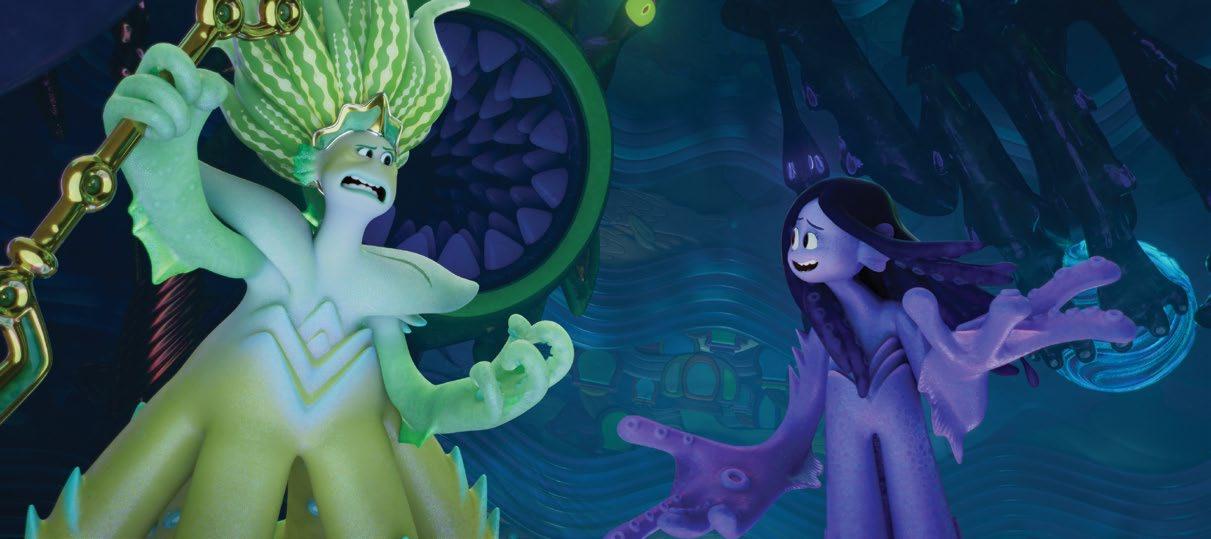 - By Tom McLean -
- By Tom McLean -
Being a teenager is a time of normal change and growth. But there’s not much normal for atypical teen Ruby Gillman, who changes and grows large enough to unintentionally wipe out the school library and face down a giant evil mermaid in battle to decide the fate of the world.
Ruby Gillman, Teenage Kraken is this summer’s big release from DreamWorks Animation, and the first to feature a titular female hero. Directed by Kirk DeMicco (The Croods, Vivo) and co-directed by Faryn Pearl (Trolls Worlds Tour), the movie introduces the world to Ruby Gillman (Lana Condor), who is trying to live a normal teenage life in the town of Oceanside while staying away from the water on orders from her mom, Agatha (Toni Collette).
But such rules are meant to be broken and, when they are, Ruby finds out she and her family are actually krakens — and that she has a weighty family history to live up to. Throw into this the normal anxieties about getting a date for prom night; the arrival of a mysterious, super-cool, red-haired student named Chelsea (Annie Murphy), who’s really a mermaid; and meeting her grandma (Jane Fonda) for the first
time; and well, what happened to the school library is at least understandable.
Beautiful Creatures
Produced by Kelly Cooney Cilella, with a screenplay by DeMicco and Pam Brady, based on a story by Brady, Ruby Gillman, Teenage Kraken is set for a world premiere at Annecy before a wide release in theaters on June 30.
Cooney Cilella brought more than 20 years of experience at DreamWorks Animation to her first role as full producer on a feature. She was hooked by the way the script flipped the hero and villain roles for mermaids and sea monsters — and that it all culminated on prom night. “That just feels like a playground I really want to play in,” she says.
DeMicco returned to DreamWorks to direct Ruby Gillman, at least in part to do a mother-and-daughter coming of age story to complement the father-daughter tale he told as co-director on The Croods. In addition to being a generational story about women, it was also an opportunity to tell an adventure story on epic scale — and mash it up with a John Hughes-style 1980s high school comedy. “That was very ap-
pealing to both sides of who I am,” he says.
The movie had been in development under the title Meet the Gillmans, with an ensemble approach to the story. But over time, it became clear that this was Ruby’s story, and the script changed to reflect that.
“She’s the hub of the wheel; every story comes off of her,” DiMicco says. “Her superpower is something that’s inside of her, that the real power is just not to hide it, you know? And that I think it’s such a strong message for kids.”
While there’s no easy part of making a movie, getting right the emotional side of Ruby’s story was only half the battle. Getting right the adventure part, and the scale that was required to challenge a kraken on a physical scale required some deep diving.
“In typical movies, krakens are slate-wipers,” he says. “They end films.” But making a kraken like Ruby the center of the story meant they had to start with something big — and then go bigger.
“Everything that she had to go through had to be larger than life, because she’s larger than life,” he says. That took some time for the team to figure out. “I just wanted to make sure that the final battle … that it felt earned. That she put in the effort,
www.animationmagazine.net 28 jun|jul 23 FEATURES
she put in her time and she earned that,” he says. Even in the storyboarding stage, the story seemed to call for everything to get bigger with each iteration.
Pearl started her career as a storyboard artist at DreamWorks Animation Television, which was mostly a board-driven writing environment. Ruby Gillman, Teenage Kraken appealed to her as a chance to work on an original story idea. As the movie morphed from the family perspective to Ruby’s point of view, Pearl says she saw the potential in Ruby and put in for the co-director job.
“The thing that makes her different is that what’s at first something that she should hide, is actually something that makes you powerful,” Pearl says.
“We always knew we wanted Ruby to be kind of goofy, someone who is sweet but doesn’t realize the power of who she was.”
One of the keys was Condor’s voice performance, which influenced how the story and character developed. “Lana had this great quality to be very anxious and awkward and charming,” Pearl says. The animators, in particular, enjoyed that interpretation and really leaned into that version of the character. “How could they not have an absolute blast with doing a character like that? Who stumbles over her words, but is so earnest and sweet?”
The film’s acclaimed production designer, Pierre-Olivier Vincent, has more than a quarter century of experience at DreamWorks Animation, and is best known for his work on the How to Train Your Dragon trilogy.

Having the story go between a version of the real world and the fantasy undersea world of the kraken and mermaids was irresistible to Vincent. “I love knowing that, yes, there is the real world, but then there is a whole new world that we
don’t know about,” he says. “It’s a real pleasure to just wonder, you know, what would it look like?”
Vincent found the character designs for Ruby and the krakens used a rounded line that could be softer and more playful. “Playfulness was something that I try to follow through the design process, like having everything a little bit curvy, a little bit round,” he says.
He also played with saturated colors, taking inspiration from the bright colors people paint their homes in places like Maine and the northern parts of Canada, as well as the iconic designs of the 1970s, which were popular and made an impact on him when he was a child. “I remember the joyfulness of that era,” he says.
The filmmakers had a free hand to design the look of the mythical Kraken, which were based on octopuses and have no bones. “[We] wanted to make sure the Gillmans essentially didn’t have joints, that the whole arm would be able to move in one wavelike motion,” Pearl says. “We really leaned into that rubber hose, kind of tentacle feel with their bodies.”

The animation team, led by Carlos Puertolas, focused on the cartoony nature of the kraken to make them stand out from the mermaids and the humans of Oceanside, Pearl says.



jun|jul 23 29 www.animationmagazine.net FEATURES
“In typical movies, krakens are slate-wipers … I wanted to make sure that the final battle felt earned. That Ruby put in the effort, she put in her time and she earned that.”
- Director Kirk DeMicco
A DEEPER DIVE: Ruby Gillman ’s creative team is proud of the pic’s magical underwater scenes, the breathtaking finale and its timely message of acceptance.
For the ocean sequences, the story goes deep. This isn’t a coral reef or something happening near the surface — and it’s dark down there. “”We’re gonna go to the abyss, and we know that in the abyss, it’s pretty dark,” Vincent says.
The kraken castle looks ominous from the outside, but once Ruby enters, it’s a much brighter and more colorful place with lots of light, glass and gold. Vincent says this reflects that the kraken empire has been around for generations, and their palace reflects their sophistication and their aspirations for the future.
“It’s very easy to go monster-y,” he says. “It’s a lot more difficult to do aspirational kind of characters. That’s what we’re kind of trying to do.”
Much of the final battle sequence benefits from the use of previz, DeMicco says, which he differentiates from the layout process that

DreamWorks has been using since the days of Shrek. “I don’t want to call it layout,” says DeMicco. “Now there’s animation in there. There’s acting. There’s timing. So having that in the toolbox for those sequences, I think, was invaluable.”

With a giant sea creature battle, there was no way to escape the influence or feel of a kaiju movie, DeMicco says. What sets it apart is that it’s a beautiful one. “Glowing, strong women battling it out in this massive scale … That was something that we had always hoped for,” he says.

The Perfect Prom
But like many teenagers, all Ruby really wants is to go to the prom. And designing a modern one was a lot of fun for Vincent. Art Deco was the original inspiration, partly because it’s such a global design statement, he says. “It’s a
good-looking prom, I think,” he says.
Vincent says knowing most everyone who works at the studio made it easy to come on Ruby Gillman, Teenage Kraken, which started production the week he started on the movie. It also made communicating with everyone easier and more enjoyable — even with everyone working from home during the COVID-19 pandemic.
“I’m very proud of the look we achieved, but at the end, I’m proud of how the crew reacted,” Vincent says. “And the way we worked together, it was flawless, and specifically during the pandemic quarantine time. I still can’t believe that we have managed to do it.” ◆
Universal will release DreamWorks Animation’s Ruby Gillman, Teenage Kraken in theaters nationwide on June 30.

www.animationmagazine.net 30 jun|jul 23 FEATURES
A TALE OF SCALES: Director Kirk DeMicco and his team set out to deliver an unusual blend of high school comedy meets adventure epic, with sea monsters and mermaids!
“Playfulness was something that I try to follow through the design process, like having everything a little bit curvy, a little bit round.”
- Production designer Pierre-Olivier Vincent

Through the Looking Glass Again
A young heroine finds a shelter from bullies in Keiichi Hara’s new animated feature Lonely Castle in the Mirror.
 - By Charles Solomon -
- By Charles Solomon -
Bullying is a serious problem children face, especially in Japanese schools. According to the Mainichi newspaper, more than 600,000 incidents of bullying were reported to the education ministry in 2021. The number of “serious incidents” that produced long absences and even suicides rose to 705.
Kokoro, the heroine of Mizuki Tsujimura’s best-selling novel Lonely Castle in the Mirror and Keiichi Hara’s new animated adaptation, is the victim of one of those “serious incidents.” After being terrorized by her classmates, she refuses to return to Yukushina #5 Junior High School — or leave her house. Kokoro spends long, dreary days watching TV, napping and eating the lunches her mother prepares — until one day, the mirror in her room begins to glow mysteriously.
Echoes of Alice
Kokoro passes through the mirror, like Alice through the Looking Glass, and finds herself in a mysterious castle where six other children with similar problems have been summoned. A masked girl who calls herself the Wolf Queen makes two crucial announcements: 1) The castle will exist for only a finite time and 2) whoever finds the key hidden within it will have a

single wish granted — any wish.
Hara discussed the film in a recent interview conducted via email. He discovered the novel when he was approached by Shochiku Studio: “I received a request from the producer there saying, ‘We want to make this novel into an animated movie.’ I accepted, so I read the book for the first time.“
Tsujimura’s novel is arguable too long — more than 350 pages in the English translation — and somewhat repetitious. Condensing
and shaping the story required major efforts by Hara and screenwriter Miho Maruo. “The length was the most difficult part when I visualized the novel,” Hara explains. “If we were to depict all the material about all seven children, it would not have been possible to fit it into the two-hour film, so we focused on the episodes involving Kokoro, the protagonist of the original book. I pared down the episodes of the other children and their home environments as much as possible for the movie.”
Like Makoto Kobayashi, the junior high school suicide victim in Hara’s highly praised Colorful (2010), Kokoro begins as a rather unlikable character: bored, diffident and bitter. Her wish would be to make the girl who led the bullies suffer. Transforming her into a heroine who could win audience’s sympathy and hold their interest for two hours posed additional challenges.
“I think this is where a film director can demonstrate his or her power most effectively,” Hara says. “It was a test for me as a director, to convincingly portray the transformation of an initially unsympathetic child into a credible main character. I think we were successful.”
But if Kokoro seems unlikable initially, it’s partially a reflection of the trauma she’s experienced. Hara realized that while he need-
www.animationmagazine.net 32 jun|jul 23 FEATURES
ed to make Kokoro more sympathetic, it had to be clear she wasn’t merely a petulant adolescent. The audience had to understand the pain she suffered from her classmates’ attacks — because it reflected a very real problem.
“I’m aware that bullying is a very serious problem,” he states. “I think it’s really unfortunate that children who have only lived for 10 years or so are desperate about their future. Bullying existed when we were kids, too, but there are differences between then and now. Today, on top of in-person bullying, I think bullying using social media is increasing. We hope that through this film, we can help dissuade kids from making the worst decisions.”
Tsujimura describes the Lonely Castle as “a castle from a Western fairy tale with a magnificent gate.” Kokoro and the other kids never see it from the outside, and the author doesn’t give the reader much of a sense of
the architecture. Creating a look for the castle was left to Hara and designer Ilya Kuvshinov (The Wonderland).
“I asked Ms. Tsujimura if she had a visual image of the castle — for example, an old castle in Germany,” Hara explains. “She told me she didn’t have a concrete image, so I came up with my own. It shouldn’t be a luxurious castle since it’s for kids with problems. I thought the exterior should be a rugged medieval-style castle built for battle. On the other hand, I imagined the interior to be gorgeous and spacious with European furniture. That’s how I asked Ilya-san to make it. In terms of where the castle should be, I thought it would be interesting to build it in a real place called ‘Ball’s Pyramid,’ which is a rock 572 meters tall sticking up in the Australian sea that I happened to see on TV.”
The forbidding towers were built in CG and the drawn characters had to be integrated into the backgrounds. “I don’t have a very detailed knowledge of CG, so I sometimes end up making requests of the CG team that are impossible,” Hara admits. “I get involved in making an animated film roughly once every
three years, and each time I’m amazed by the dramatic progress of the technology. At the same time, I learned that some of my requests take a very long time and a lot of work.”
As the small group of outcasts spends time together, they discover they have more in common than they initially realized. How could they all have attended Yukushina #5 Junior High School yet never encountered each other in the real world? For the first time, Kokoro and the others learn to trust and care about their fellow students. Their shared bond gradually replaces their individual wishes. Can they find a way to thwart the Wolf Queen’s rules and preserve their friendships, even after the castle ceases to exist?
A Labor of Love
Looking back over the unusually long production time Lonely Castle required, Hara reflects, “This film took a long time to make — five and a half years — and many things happened during that time. Takashi Nakamura, who was originally supposed to oversee art direction, passed away suddenly. One of the producers gave birth to a child. I felt the changes in the lives of the people who were involved in the making of this film. I was also surprised to turn 60 years old myself!”
“I’ve been very lucky to be able to live my life only working on films,” he concludes. “Lonely Castle in the Mirror has grossed more than ¥848 million (about $6.3 million in U.S. dollars) at the box office worldwide. It’s become an important work for me in that respect. I may have disappointed my investors and myself with my past films, but I’m grateful to have been able to make this one. The theme of this film is relevant not only in Japan, but also in the rest of the world. I’m looking forward to seeing how people perceive it overseas and how they respond to it. I have no worries, just excitement.” ◆

Lonely Castle in the Mirror is one of the features in the competition lineup at the Annecy Festival in June. GKIDS will release the movie on June 22 and 23 in select U.S. theaters.

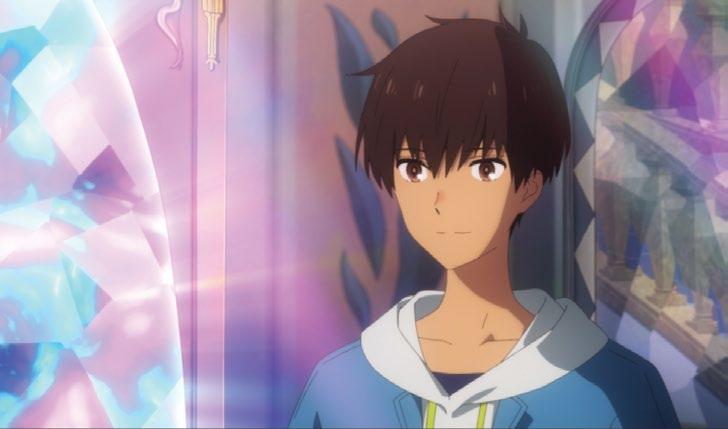
jun|jul 23 33 www.animationmagazine.net FEATURES
“Bullying existed when we were kids, too, but there are differences between then and now. Today, on top of in-person bullying, I think bullying using social media is increasing. We hope we can help dissuade kids from making the worst decisions.”
- Director Keiichi Hara
INTO THE WOLF’S DEN: Produced by A-1 Pictures and distributed in the U.S. by GKIDS, Keiichi Hara’s adaptation of Lonely Castle in the Mirror premiered in Japan in December of last year.
A New Adventure Takes Flight
Cartoon Saloon’s Puffin Rock characters migrate to the big screen.


It’s hard to believe, but it has been eight years since Irish animation powerhouse Cartoon Saloon introduced the world to Puffin Rock, a charming series about the adventures of a lovable young puffin named Oona and her little brother Baba. This month, the property spreads its wings for a big-screen adventure titled Puffin Rock and the New Friends, directed by Jeremy Purcell and co-produced by Northern Ireland’s Dog Ears. In the new adventure, the show’s birds pair up with some new island arrivals to crack the mysterious disappearance of the last little egg of the season!
“It was back in December of 2017 when I first heard that the studio might be making a Puffin Rock movie,” recalls Purcell. “But it wasn’t until July 2019 when I officially started on the production. I had a couple of months of just myself and our line producer, Caoimhe Ní Bhrádaigh, before our core team — assistant
Revisiting the Coastal Characters
Purcell, who worked on the series as well as the studio’s features Song of the Sea and The Secret of Kells, says he and his team loved the series. “It has a special place in our professional hearts, but we knew starting out that we would have to make some changes — particularly to
the story. We didn’t want to make just a 75-minute series episode. If we were going to keep the whole audience engaged, parents and children alike, we would have to age up the story a little.”
He says there were a lot of discussions about what makes Puffin Rock, Puffin Rock. “It really helped keep the essence of the show by having some returning crew members — both Lorraine (assist. dir.), our location designer Stefano Scapolan and composer Einar Tönsberg (Eberg) had all worked on the series. It was a little bit like getting the team back together for one last mission, with a bunch of new team members, of course.”
The director adds, “What I love about this adaptation is that we made a film that is true to the Puffin Rock world. It has everything you would expect — beautiful artwork, wonderful music, a great cast and, of course, Chris
www.animationmagazine.net 34 jun|jul 23 FEATURES
director Lorraine Lordan, art director Fran Bravo, storyboard supervisor Aidan McAteer and editor Sophie Borlée — all started.”
- Director Jeremy Purcell

O’Dowd back as our narrator! But it’s also an engaging story about what makes a home. It’s worth 75 minutes of time and watching it on the cinema screen.”
Of course, the movie ran into all the usual challenges most productions faced during the COVID lockdowns. “It took longer for us to make than we intended,” notes Purcell. “We were a few months into pre-production when China went into lockdown, and the crew of the studio that we were working with were suddenly working from home. So, we started feeling the repercussions a little sooner than some other studios in Europe. But it wasn’t long before our team here in Kilkenny were in lockdown, too.”
Purcell considers his team fortunate, as they had a few months together beforehand, and they were able to keep working on the storyboard and animatic for the most part. “However, recruiting a production crew was very difficult since everyone was hiring animators at the time,” he recalls. “So, we worked as best we could with a reduced crew, and in February of this year we finished the sound mix. I’m not sure how many people in total from the different studios ended up working on the film, they were spread across five countries, but I was on it for just over three and half years.”
By the end of the second season of the show, the team had a good production rhythm in place, and they took advantage of that experience. “We didn’t want to waste all that knowledge and shorthand, and we had spent two
seasons learning and refining,” says Purcell. “So, we basically replicated the TV series pipeline for the feature. We used Moho (although it was a newer version) for the animation, with Photoshop for the beautiful backgrounds and After Effects once again for the compositing. We are very experienced in the studio with these three programs working together, and new tools like meshes and automatic wind in the new Moho really helped a lot when animating a massive storm hitting the island in the movie.”
In addition to the pandemic, the team also had to deal with refining and re-working the story once they transitioned from the script to animatic stage. “Tomm Moore gave me a great piece of advice when working on the animatic: ‘Find what’s personal to you in the story.’ It made me realize that I knew Isabelle. Growing up, my family fostered children and we had many children who came to stay with us. Those who had to leave their old lives and start somewhere new, trying to make it a home. It really helped me to understand that character, and what she was going through and feeling about her situation.”
A Gentle World
So, why does the beautifully drawn world of Puffin Rock have such a universal appeal? “During the production of the movie, I would go on social media and search Puffin Rock just to remind myself what is important to the audience and what they love about it,” says Purcell.

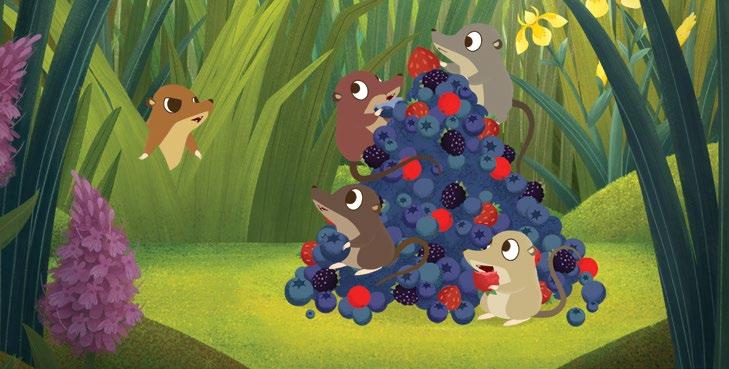
“I wanted to make sure we didn’t lose sight of it when making the movie. It might be obvious, but they loved the artwork, the lush, colorful backgrounds, the Irish accents of the characters, especially Chris as the narrator, and of course the music! That fact that the theme song is such an ear worm also gets a lot of mentions. The surprising thing I found was that audiences love that Puffin Rock was such a gentle show. It provided a sweet world they could retreat, and it’s a show that parents didn’t mind watching with their children — or even by themselves when they needed a little down time.”
He adds, “When it comes to the movie, we had the artwork, the Irish accents, Chris was back and the music is as catchy as ever, but we worked really hard on the less obvious, and wanted to create a movie the family could enjoy together as I think we have.”
Lastly, Purcell hopes the audience connects with the new character, Isabelle. “We had such a great new cast with new characters, but we also had to recast most of the series’ characters since our TV actors had grown up on us. But it also meant that we got to have Eva Whittaker, who played Mebh in Wolfwalkers, as our Isabelle, and she did a fantastic job. It’s such an emotional performance and I hope the audience connects with Isabelle. I hope they realize it will be OK when moving somewhere new — to be the new puffin, to make mistakes, to say you’re sorry and to make new friends. I think having empathy for others is the key take away of our movie.” ◆
Wild Card will open Puffin Rock and the New Friends theatrically in R.O.I. and N. Ireland on July 7. WestEnd Films is the film’s sales agent.
jun|jul 23 35 www.animationmagazine.net FEATURES
“We made a film that is true to the Puffin Rock world. It has everything you would expect — beautiful artwork, wonderful music, a great cast and of course Chris O’Dowd back as our narrator! But it’s also an engaging story about what makes a home.”
BIRDS OF A FEATHER: tirected by Cartoon Saloon veteran Jeremy Purcell, Puffin Rock and the New Friends follows the disappearance of the final Little Egg of the season in strange circumstances.
Best Animated Movies of the 21st Century (so far)
A few of our favorite animation players and critics pick their favorite features of the past 23 years.
Selecting the best movies of a year, a decade or a century is not for the faint of heart. However, since everyone and their dogs were coming up with “top 10” lists this year, we thought our readers deserved a similar one devoted to animated movies. The past 23 years have been quite a rich and diverse period for animated features. A passing glance at the lists proves that the animation art form is alive and thriving. We love it when our favorite directors take bold chances and tell original, rewarding stories and push the medium, whether they work in 2D, CG or stop motion.
How did we compile this very unscientific and totally subjective list? We asked some of our favorite directors, producers and critics to give us their best animated titles of the 21st century. Then, we threw all of them in a blender and came up with an overall list. We also included everyone’s personal lists, so you can see who picked which movies (and who cheated by giving us more than 10 or picking movies that didn’t belong to our specified time period (January 2000-May 2023)! (None of this summer’s big features are included, because nobody had seen them by our print deadline.) Anyway, like all lists, you should definitely take ours with a grain of salt. Everyone has their own personal tastes and guidelines. But we thought this compilation will help you put together a decent must-see list in case you have missed any of these great movies. So, please don’t get angry if your personal favorites didn’t make it this time. We’ll put together a “Best Animated Movies of All Time, EVER!” list in an upcoming issue!
The Main List
1. Spirited Away (Directed by Hayao Miyazaki) 2001

2. Spider-Man: Into the Spider-Verse (Bob Persichetti, Peter Ramsey, Rodney Rothman) 2018
3. The Incredibles (Brad Bird) 2004
4. How to Train Your Dragon (Dean DeBlois, Chris Sanders) 2010
5. Coraline (Henry Selick) 2009
6. I Lost My Body (Jérémy Clapin) 2019
7. The Fantastic Mr. Fox (Wes Anderson) 2009
8. Your Name (Makoto Shinkai) 2016
9. Chicken Run (Peter Lord, Nick Park) 2000
10. The Secret of Kells (Tomm Moore) 2009
Individual Lists
Bonnie Arnold
Producer, How to Train Your Dragon trilogy
How to Train Your Dragon Trilogy
Over the Hedge Isle of Dogs
Coraline
My Life as a Zucchini
The Incredibles
Ralph Breaks the Internet
Kung Fu Panda
Despicable Me
Finding Nemo
Jerry Beck
Animation historian, author, teacher
1. Spider-Man: Into The Spider-
Verse
2. The Fantastic Mr. Fox
3. The Incredibles
4. A Shaun the Sheep Movie: Farmageddon
5. Toy Story 3
6. Kung Fu Panda
7. The LEGO Movie
8. Coraline
9. How To Train Your Dragon
10. Frozen
Eric Beckman
Founder, President of GKIDS
1. The Tale of the Princess Kaguya
2. Spirited Away
3. WALL•E/The Incredibles/ Finding Nemo
4. Paprika
5. Song of the Sea
6. Your Name
7. Summer Wars/Wolf Children
8. Spider-Man: Into the Spider-Verse
9. Mind Game
10. The Boy and the World
11. Ernest & Celestine
Peter DeBruge
Film Critic, Variety
1. WALL•E
2. Spirited Away
3. Inside Out
4. The Illusionist
5. Your Name
6. I Lost My Body
7. How to Train Your Dragon
8. Waking Life
9. Zootopia
10. Fantastic Mr. Fox
36 jun|jul 23 FEATURES
www.animationmagazine.net
Spirited Away
Sam Fell
Director, Chicken Run: Dawn of the Nugget, ParaNorman
1. Chicken Run
2. The Incredibles
3. Wallace & Gromit: The Curse of the WereRabbit
4. Monsters, Inc.
5. Paprika
6. Coraline

7. Spirited Away
8. Cloudy with a Chance of Meatballs
9. I Lost My Body
10. Kung Fu Panda
Ray Laguna
Journalist, Animacion por Adultos
1. Spirited Away
2. The Triplets of Belleville
3. Paprika
4. Persepolis
5. WALL•E
6. The Tale of the Princess Kaguya
7. The Boy and the World
8. The Red Turtle
9. Wolfwalkers
10. No Dogs or Italians Allowed
Peter Ramsey
Ellen Goldsmith Vein
Producer, Wendell & Wild Coraline
Wendell & Wild Triplets of Belleville
Fantastic Mr. Fox
Iron Giant
The Incredibles
Madagascar
Spider-Man: Into the Spider-Verse
Spirited Away
Finding Nemo
Sheri Linden
Film Critic, The Hollywood Reporter
1. Spirited Away
2. Fantastic Mr. Fox
3. The Secret of Kells
4. Anomalisa
5. It’s Such a Beautiful Day
6. The Red Turtle
7. The Breadwinner
8. My Life as a Zucchini
9. Toy Story 4
10. Waltz With Bashir
Henry Selick
Chris Nee
Creator, Doc McStuffins, Vampirina, Ridley Jones Zootopia
The Triplets of Belleville Up
Spirited Away
Surf’s Up
Toy Story 3
FEATURES
Director, Spider-Man: Into the Spider-Verse
The Incredibles
Ratatouille
The Red Turtle
Fantastic Mr. Fox
How to Train Your Dragon
Toy Story 3
Spirited Away
Your Name
Spider-Man: Into the Spider-Verse
Wolfwalkers
Jorge R. Gutierrez
Director, The Book of Life, Maya and the Three
My 21st century favorite films, going by how many times I have re-watched them, and in no particular order::
Spirited Away
The Mitchells vs. the Machines
Mind Game
Spider-Man: Into the Spider-Verse
Coraline
The LEGO Movie
Kung Fu Panda
Guillermo del Toro’s Pinocchio
Vampire Hunter D: Bloodlust
The Book of Life (because one must love oneself before they can love others)
Simon Otto
Director, That Christmas
Chicken Run
How to Train Your Dragon
Ratatouille
Spirited Away
Zootopia
The Incredibles
How to Train Your Dragon
I Lost My Body
Spider-Man: Into the Spider-Verse
The Book of Life
Director, Coraline, Wendell & Wild
Spirited Away
Ratatouille
The Incredibles
The Secret of Kells
Spider-Man: Into the Spider-Verse
The Illusionist
The Book of Life
Isle of Dogs
Coraline
Wendell & Wild
Tom Sito
Spider-Man: Into the SpiderVerse
I Lost My Body
Shrek 2
Director, storyboard artist, author, teacher
1.Lilo & Stitch
2. Finding Nemo
3.The Incredibles

4. Persepolis
5. The Secret of Kells
6. Ernest & Celestine

7. How to Train your Dragon

8. Frozen
9. Kubo and the Two Strings
10. Spider-Man: Into the Spider-Verse

jun|jul 23 37 www.animationmagazine.net
Spider-Man: Into the Spider-Verse The Incredibles
Coraline
I Lost My Body
How to Train Your Dragon
1. Coco. When audiences and artists are calling for greater inclusion, Coco offers not only a heart-warming story, but a model of how to research and respectfully present the traditions of another culture.
2. Corpse Bride. Mackinnon & Saunders breakthroughs in puppet construction, Carlos Grangel’s inspired designs and Tim Burton’s singular sensibility meld in a colorful tale of the afterlife.
3. Millennium Actress. A brilliant account of a determined woman who overcomes all obstacles to live the life she chooses. Satoshi Kon’s premature death was a terrible loss to the art of animation.
4. Ratatouille. Great storytelling, excellent direction and amazing animation: Who could ask for more?
5. The Secret of Kells. Medieval illuminations and mid-century graphics blend in a strikingly original story that marked the feature debut of Tomm Moore and Cartoon Saloon.
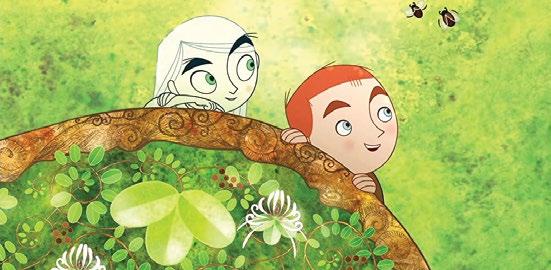
6. Spider-Man: Into the Spider-Verse. Crackling with energy, SpiderVerse proved animation can still outdo live action when telling stories about comic-book superheroes.
7. Spirited Away. Miyazaki’s masterpiece to date: The only anime
ND
Creator, Nimona
Nimona
The Prince of Egypt (cheating since it came out in 1998, but I can’t not include it)
Lilo & Stitch
The Emperor’s New Groove
Tokyo Godfathers
Spider-Man: Into the Spider-Verse
Spirited Away
Treasure Planet
Moana
ParaNorman
The Pirates! Band of Misfits
Arianne Sutner
feature to win both the Oscar for Animated Feature and the Golden Bear at the Berlin Festival.
8. Summer Wars. Neither Ready Player One nor Ralph Breaks the Internet can compare with Mamoru Hosoda’s visually imaginative storytelling about the interlocking bonds between the real world and the web.
9. Toy Story 3. In the touching conclusion to a groundbreaking animated trilogy, Woody, Buzz and the gang learn, like parents, to accept that a child no longer needs them.
10. Up. The “Married Life” montage, which could reduce a stone to tears, is a masterpiece of animated storytelling — and cinematic storytelling.
11. Wallace & Gromit: The Curse of the Were-Rabbit. Innovative stopmotion animation and witty writing create the galloping absurdity only Nick Park can envision.

12. Your Name. One of most thought-provoking anime features in many years: A teen romcom that subtly morphs into a meditation on the continuing trauma of the Great East Japan Earthquake (a.k.a. Fukushima). Honorable mentions: How to Train Your Dragon 2, Howl’s Moving Castle, The Incredibles, Mirai, Soul, The Tale of the Princess Kaguya, Wolfwalkers
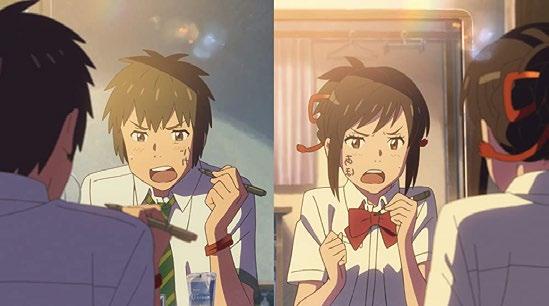
Jennifer
President of Production, Producer, LAIKA
LAIKA movies (Coraline, ParaNorman, The Boxtrolls, Kubo and the Two Strings, Missing Link)
Spirited Away
Ponyo
The Incredibles
Spider-Man: Into the Spider-Verse
Song of the Sea
How to Train Your Dragon
Chicken Run

The LEGO Movie
I Lost My Body
Director, Kung Fu Panda 2 & 3; Love, Death + Robots
Spirited Away
The Incredibles
Spider-Man: Into the Spider-Verse
Shrek
Isle of Dogs
Final Fantasy VII: Advent Children
I Lost My Body
Coraline
Your Name
How to Train Your Dragon
www.animationmagazine.net 38 jun|jul 23 FEATURES
Charles Solomon
Film critic, author, journalist
Stevenson
Yuh Nelson
Your Name
Chicken Run The Secret of Kells
Fantastic Mr. Fox
KINDRED SPIRITS ’23
FOR THE EARTHQUAKE-DISPLACED CHILDREN OF SYRIA AND TURKEY
JUNE 1 ST – 30 TH
• Online fundraiser
• Auction of original “Mandalorian” artwork by renowned artists

• Live gatherings in LA, NYC, Mexico City, and Wellington, NZ
For more information go to: WWW.KEPYR.ORG
This event is being organized, hosted, and produced by KEPYR in support of UNICEF USA.
Star Wars, The Mandalorian, and Grogu are registered copyrights and trademarks of Lucasfilm. Lucasfilm is not affiliated or associated with KEPYR and does not endorse their products, services, or activities.
KEPYR Presents
Riding a Wave of Self-Acceptance
The veteran animation team behind DreamWorks TV’s Not Quite Narwhal deliver a whale of a tale about a unicorn under the sea.
 - By Karen Idelson -
- By Karen Idelson -
Childhood is often full of questions about identity, belonging and self-acceptance. Many kids also have a sense of being part of two (or more) cultures or identities, which is probably why the 2017 children’s book Not Quite Narwhal, a book about a unicorn who lives with a group of narwhals and later discovers his identity, was such a hit.
Written by Jessie Sima, the book was immediately praised for the way it showed a character discovering and accepting the ways he was different from others. This summer, a new Netflix animated series based on the book will explore the same ideas. In the series, which is produced by DreamWorks Animation Television, we follow the same main character, Kelp, as he learns to embrace and accept himself just as he is. Kelp loves his narwhal family, but it’s not exactly a perfect fit. Not Quite Nawhal brings together an
experienced writing/producing team that includes co-executive producers Sarah Katin (writer on Fancy Nancy and The Boss Baby: Back in Business), Nakia Trower Shuman (Pretzel and the Puppies, The Boss Baby: Back in Business) and Brian K. Roberts (The Best of the Tracey Ullman Show, 10 Truths About Love). The producers of the series are all fans of Kelp and the original book.
Everybody Loves Kelp!
“I locked eyes with Kelp and never looked back,” says Katin. “Aside from the obvious adorableness of a unicorn who lives in the sea, it was the simple, beautiful message that really hooked me. Who’s never felt a little different? This book embraces and celebrates Kelp’s uniqueness. He doesn’t have to choose to be anyone other than exactly who he is.”
Co-executive producer Trower Shuman adds, “Sarah and I were working on Boss
Baby with the super showrunner and genius Brandon Sawyer when the awesome Vanessa Taylor Sands (development executive at DreamWorks) introduced us to the book. We instantly fell in love with Kelp and the fantastical nature of his two worlds. But it was the book’s theme of embracing and owning your unique differences that spoke to us the most.”
Co-executive producer Roberts was then brought onto the project and felt the same pull to the material. The themes touched him right away.
“I was wrapping up the production of Dragons: Rescue Riders and Vanessa Taylor Sands met with me about producing an animation test to help pitch a new series she was developing with Nakia and Sarah,” says Roberts. “When selling a show that’s not based on an existing film or franchise it’s common to do a little sample of animation to
www.animationmagazine.net 40 jun|jul 23 TV/STREAMING
show buyers what the series might look like. As soon as she said, ‘unicorns and narwhals’ I was already interested, but when I read Jessie Sima’s book, I was thrilled at the opportunity to help bring such a meaningful story to life as a series.”
The illustrations in the original book take on a magical, playful tone as they imitate the look of an underwater ocean world. Known for ethereal blue tones and spots of coral and lavender, the color tones of the book have been carried over to the series. Also, as in the book, Kelp wears a diving helmet shaped like a clear orb. The producers were inspired by this look.
“The book is inherently about being unique, so we wanted to make sure that our cast of characters both above and below water showcased a lot of diversity,” says Roberts. “This led to lots of interesting conversations about how things such as eye color and hairstyle can affect representation when you’re creating fantasy creatures like unicorns. Within this epic story about Kelp being literally swept away to a new world Jessie creates adorable little moments of humor and charm. Lots of little visual gags in the book found their way into the series, like Unicorns eating sno-cones and making each other into sand-narwhals on the beach.”
For Trower Shuman, the feeling of the book
overall in the story that was told was top of mind as the show was developed.
“The book’s artwork and dialogue are right in line with stories we love to write,” says Trower Shuman. “It’s heartfelt, comedic and set in adventurous worlds that you can get lost in.”
Katin says she was as interested in what was shown in the book as what was left up to the imagination of readers. It gave the producers an opportunity to develop the many aspects of the series from scratch.
“Kelp is the only character referred to by name in the book,” says Katin. “I’d say the biggest challenge was creating the entire animated world of Narwhal. What does the ocean look like? Does Kelp live in a house? What does Unicorn Land look like? Where do unicorns sleep? Who are all the characters that embody both worlds? What do they bring to the show and Kelp’s journey?”
The show features a seasoned group of voice actors including Nevin Kar (Mira, Royal Detective) as Kelp, Scarlett Kate Ferguson (I’m Dying Up Here, Pupstruction) as Pixie, Sasha Knight (Cowboys) as Ollie, Ryan Anderson Lopez (Undone) as Cruz and Mixie Chen (Princess Power) as Juniper. Guest actors on various episodes include Matthew Yang King (Riverdale) as Dad Tuskington and Crabby, James Monroe Iglehart (who also worked on SuperKitties) as Chef Jinglehooves, Kevin

Dunn (Law & Order) as Mr. Pearly and Sally Struthers (All in the Family, Gilmore Girls) as Mrs. Polydopoulos.
The series was animated by Lemon Sky Studios in Malaysia. “[Lemon Sky] worked with DreamWorks’ internal HUB team and our CG animation producer, Joe Alessandra, following the HUB’s own pipeline and technical specifications,” says Roberts. “This includes doing asset creation and animation in Autodesk Maya and effects and compositing in The Foundry’s Nuke software.”
After being swept up in Kelp’s story of discovery, the producers hope the viewers find the same things in the story that made them want to make the show. The simple, powerful message of embracing your own story is always timely.
“We hope audiences will have a totally spark time celebrating who they are as they join Kelp and his friends on their adventures filled with laughs, heart and of course lots of spark,” says Trower Shuman.
Roberts believes self-acceptance can also lead to acceptance of others: “Understanding and loving ourselves helps us understand and love others, and life is most richly lived in harmony with one another,” he points out. ◆
Not Quite Narwhal premieres on Netflix on June 19.


jun|jul 23 41 www.animationmagazine.net TV/STREAMING
HORN OF PLENTY: Based on the best-selling book by Jessie Sima, Not Quite Narwhal centers on a curious and fun-loving character named Kelp who discovers that he is actually a unicorn.
“I locked eyes with Kelp and never looked back … Aside from the obvious adorableness of a unicorn who lives in the sea, it was the simple, beautiful message that really hooked me. Who’s never felt a little different? This book embraces and celebrates Kelp’s uniqueness.”
— Co-exec producer Sarah Katin
It’s the End of the World and She Knows It!
Creators Devin Bunje and Nick Stanton take us behind the scenes of their colorful new Disney show Hailey’s On It!
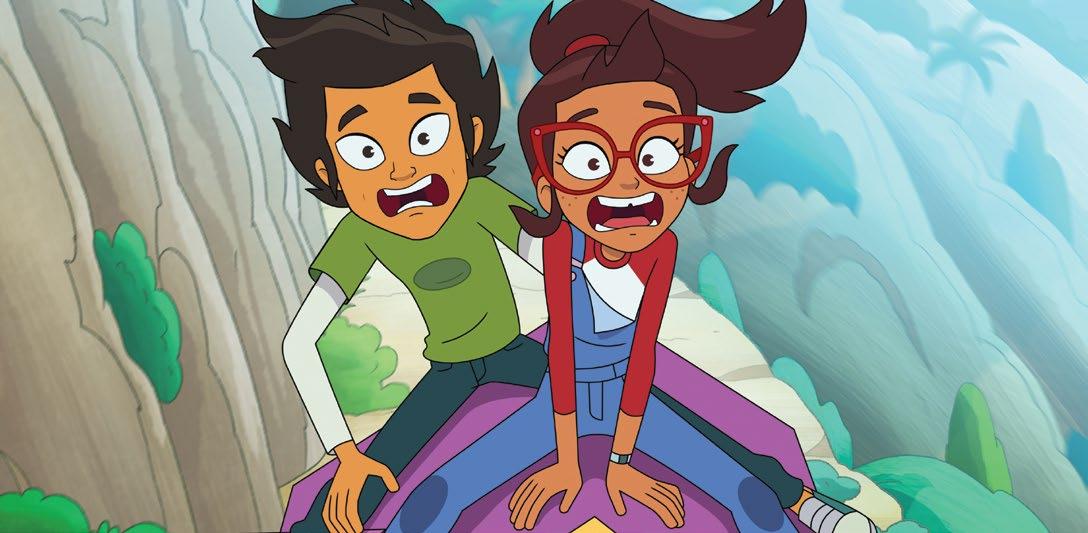 - By Ramin Zahed -
- By Ramin Zahed -
Aresourceful, but very cautious teenage girl has to save the world from destruction after she meets a time-traveling messenger from the future Earth. That was the initial idea conceived by longtime writing and producing partners Devin Bunje and Nick Stanton (Gamer’s Guide to Pretty Much Everything, Turbo FAST, The Replacements) about four years ago for their new animated show. The result is Hailey’s On It!, a highly imaginative and addictive new show premiering on Disney+ and Disney Channel in June.
Bunje and Stanton, who have written for shows as diverse as Packages from Planet X, Phineas and Ferb and Zeke and Luther, took the idea to Disney Television Animation, the studio where they first began their careers. “We were attracted to the initial idea, which was to have a professor from the future visit this regular girl who has this list of to-do things in an almost Seinfeld-ian level. That’s how her life gets complicated by this huge responsibility of saving the world,” says Stanton. “We both
loved the Bill & Ted movies growing up, where two average guys face huge ramifications for their little actions. We thought we could have a lot of fun exploring this idea.”
Ready for Great Things!
“Hailey’s character is the perfect fit as she puts off everything from trying a new toothpaste to bungee-jumping, because in her mind they’re big deals,” adds Bunje. “So, the show offers character dynamics and growth for her. One of the things we wanted to do was send this message out that anyone can make a big difference and accomplish great things. Where she starts off in the series, Hailey would never imagine that she’s capable of so many of these things.”
Picking the lead actress for the show proved to be quite an easy task for the duo. “Early on, we got a bunch of auditions, but we quickly fell in love with our lead voice actress Auli’i Cravalho (Moana),” recalls Stanton. “Then, everything shut down because of COVID and we ended up doing a scratch version of the pilot with people who happened to have
the equipment at their homes. A wonderful benefit of that was Gary Anthony Williams (The Boondocks) was one of the people we brought in, to play Beta (an A.I. operating system from the future). We just knew he had to be Beta.”
Manny Jacinto (Nine Perfect Strangers, The Good Place) who voices Scott, Hailey’s best friend, rounds out the cast. Howy Parkins (The Lion Guard) is co-executive producer and supervising director, Wade Wisinski (The Owl House) is producer, Karen Graci (Tuca & Bertie) is story editor and Lee Ann Dufour (The Breadwinner) is art director. Korea-based Rough Draft Studios and Saerom Animation handle the production of the show’s 2D animation overseas.
One of the big selling points of the show are its beautiful designs, appealing color palette and its San Diego backdrop. Stanton and Bunje praise the talents of art director Dufour, who is responsible for the eye-pleasing visuals.
“We wanted to present a beautiful world worth fighting for,” says Stanton. “Aesthetically, we loved the idea to present the world as a positive, vibrant place. We are both from
www.animationmagazine.net 42 jun|jul 23 TV/STREAMING
colder climates. I am from a small town in Minnesota and Devin grew up in the Northern California foothills (between Lake Tahoe and Sacramento). So for us, stuff that was set near the beach always seemed really fun and attractive. Those were the places we gravitated towards as kids, and so we built Hailey’s world around that.”
“If you’re going to spend half an hour watching something, don’t you want it to be full of eye candy?” asks Bunje. “We would always be amazed at what Lee Ann Dufour, our art director, would come up with. Hailey would be staring at the ocean out of her window, and I’d be like ‘Wow, I could just watch that!’”
Stanton and Bunje met as undergrad students in USC’s screenwriting program. “It was a very small program, and we immediately became good friends,” says Bunje. “We were the ones who goofed around in the back during our first class, so for the next three years every teacher made sure we were in separate classes.” Adds Stanton, “And here we are … we made a career out of
goofing around.”
When asked about the animated shows that made a big impact on them, Stanton mentions the classic Disney Afternoon shows. “We’re not just saying this because Disney signs our paychecks,” Stanton asserts. “The original DuckTales was a go-to afterschool show for both of us. We also liked a lot of the Nickelodeon shows like Doug and Rugrats.”
The duo, which has an equal number of liveaction and animated show credits are happy to be back in cartoon land. “You can do a lot of things in animation that are simply not possible in live action. It’s fun to go to a town in the Old West and the switch to the beach in animation,” says Bunje. “Our last two shows were both multi-cam sitcoms, where we had two main sets and then one swing set. You’re limited by the cost of construction. We can have so much visual and aesthetic fun in animation that you can’t do with anything else.”
They also appreciate the diversity of their new show’s crew and key characters “We’ve always been a big proponent of diversity. Everyone on
the team is a storyteller,” says Stanton. “At the end of the day, we’re all building this world together. Our art director Lee Ann Doufour, and directors Leslie Park and Cat Harman just hit it out of the park every time.”
“The stories we like to tell are very universal,” Bunje points out. “They are very relatable to our very diverse audience Our kids both go to schools that are very diverse. We’re not making a show for any one demographic. In a way, it’s representative of what we consider Southern California’s greatest asset, which is its diversity.”
Positive Role Models
Stanton mentions that as a father of five- and seven-year-old Asian American boys, he takes great pride in the Asian representation on the show. “You know, there has been this history of Asians not being depictured as romantic leads, so it was very important that my sons could see a character on the screen that looked like them,” he mentions. “I love the fact that they are dialed into the character of Scott. They are big fans of the show and think Scott is very cool.”

He concludes, “The world that we build in the series is a feel-good place. It’s really important to us that the show has a positive message. With so much cynicism in our world today, we just wanted to create a safe space. I love watching the show with my kids and seeing their faces light up.”

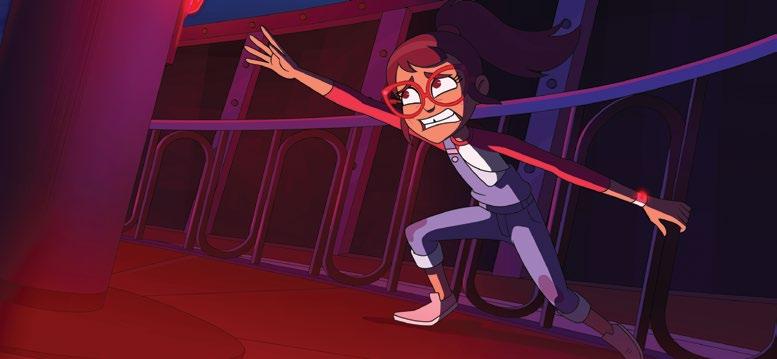

“The ultimate message is that you can be the change you want to see in the world,” Bunje chimes in. “That’s something that is very important to us, and hope our audience is inspired by Hailey going forward.” ◆
Hailey’s On It! premieres June 8 on the Disney Channel and June 9 on Disney+.
jun|jul 23 43 www.animationmagazine.net TV/STREAMING
“The world that we build in the series is a feel-good place. It’s really important to us that the show has a positive message. With so much cynicism in our world today, we just wanted to create a safe space.”
—Show creator and exec producer Nick Stanton
APOCALYPSE LATER: A risk-averse teenager has to save the world from destruction in the brightly colored and hilarious new Disney Channel show Hailey’s On It!
Series creators Nick Stanton and Devin Bunje
A Doggone Lovable Show
Pupstruction creator Travis Braun tells us everything we need to know about his pawsome new Disney series.
- By Ramin Zahed -
The popular pooches of PAW Patrol are getting some tail-wagging competition this month thanks to Disney TV’s new animated series Pupstruction. Created and execproduced by Travis Braun (T.O.T.S.), the new music-filled show follows the adventures of a “doggone hard-working construction crew, ranging from some of the brawniest breeds to cute and playful puppies!”

Aimed at kids ages two to seven, each episode includes two 11-minute stories with an original song. The show centers on the adventures of crew leader, a smart young corgi named Phinny (voiced by Yonas Kibreab), who dreams up some wild ideas to help his town of Petsburg. He is aided by Luna (Mica Zeltzer), a spontaneous sheepdog; Roxy (Scarlett Kate Ferguson), a can-do rottweiler; and Tank (Carson Minniear), a lovable, snack-obsessed mastiff. The supporting animals are voiced by Olga Merediz, Todrick Hall, Gabriel Iglesias, Nate Torrence, Yvette Nicole Brown, Bobby Moynihan, Grey DeLisle, Kari Wahlgren, Eric Bauza and Alessandra Perez.
Braun tells Animation Magazine that he used his own idyllic childhood as the inspiration for the show. “I grew up in an auto racing family in
a town about 45 minutes outside of Abilene, Texas,” he says. “I always had tools in my face and we were always building stuff, so it all felt like the show was baked into the DNA of my childhood. It was an activity that brought all the members of my family together.”
Creative Corgi
According to the creator, the show’s main character Phinny is a very sweet corgi who is also the smallest member of the crew. “But, he has the biggest ideas and the biggest imagination!” he says. “I guess he’s the closest to me because I also grew up building things. I nearly made my family go bankrupt asking for LEGO toys every birthday and Christmas. I’d get the LEGOs and would never follow the instructions, like I’d build a red spaceship out of a fire station set! So Phinny’s special skill is thinking outside the box.”
“Kids are going to love how Phinny comes up with these outlandish solutions to the challenges the crew faces in each episode,” he adds. “I wanted to put in this show for kids who want to go outside the box. We try to come up with realistic ideas, but we want to have this space to really capture wish fulfillment scenarios.
The show’s CG animation is produced by Titmouse and Italy’s Rainbow S.p.A. (Winx Club,
46 Cats). “We did a lot of visual development for the town of Petsburg since we wanted to make it feel inclusive of everyone, so it’s not like a Zootopia world where there are different areas for different types of pets,” Braun points out. “We wanted all our pets to live shoulder to shoulder. We have buses that carry not only cats and dogs, but also fish and birds and hamsters. It was a challenge, but it gave us a lot of story possibilities since you have a where were a fish needs to live next to a bunny condo. Our team has to face different challenges since they need to make sure everything they build works for everyone!”
The show’s writers’ room is based in the Titmouse offices in Burbank, overseen by story editor Robyn Brown (Muppet Babies), while the show’s supervising director Abigail Nesbitt and her team are based in New York City. “It’s this crazy triad of writing in L.A., directing in New York and production in Rome, but fortunately many on the team also worked on our show T.O.T.S., so we already had developed a great work shorthand,” says Braun. “Rob Cantor is doing the music for the series, and we really wanted the show’s music to be the centerpiece of it. Rob is a superstar, and he was able to make it really heartfelt.”
www.animationmagazine.net 44 jun|jul 23 TV/STREAMING
A Real Disney Fan
When asked about the animated shows or movies that played a big part on his childhood, Braun quickly mentions Pixar’s Monsters, Inc “I think that was the first movie I figured how
to rip the DVD and put it on my Palm Trio, so I could watch it at secretly at night since my parents had this rule about how much screen time we could have each day!” he confesses.
“Toy Story was another big one. More recently,




it’s been really cool to see what Disney has been doing with Frozen, Moana, Tangled and Zootopia They’ve been able to create these great stories that appeal to everyone. They provide great stories about relatable characters.

As Braun awaits audiences’ reaction to his new show, he hopes they will enjoy the characters and the storylines, while their parents can also laugh and find something they can relate to. “Connecting families has always been one of the big goals,” he adds. “The show is about family, and how construction brings Phinny and his family together. I’d love it if Pupstruction brings families together as they watch Phinny and his crew tackle these crazy builds.” ◆
Pupstruction premieres on Disney Channel, Disney Junior and Disney+ on June 14. A second season is already in production.
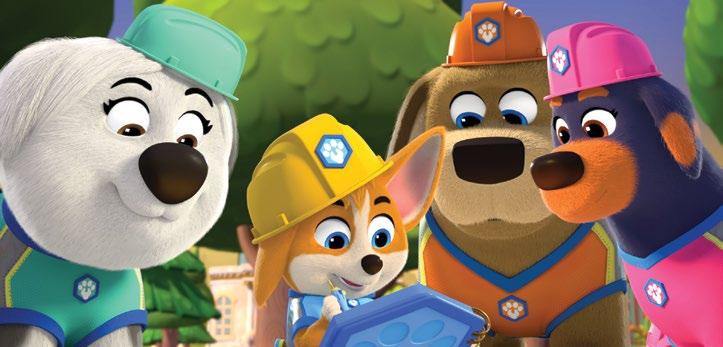
jun|jul 23 45 www.animationmagazine.net TV/STREAMING
“I’d love it if Pupstruction brings families together as they watch Phinny and his crew tackle these crazy builds.”
— Show creator Travis Braun
EVERY DOG HAS ITS DAY: Pupstruction is a new preschool show about a hard-working canine construction crew, which offers positive messages and some catchy tunes.
Comedy Is King
Cyber Group Studios introduces two colorful new toons at Annecy.


We had the chance to catch up with Dominique Bourse, Chairman and CEO of Paris- and L.A.based Cyber Group Studios to find out what the animation powerhouse is bringing to Annecy this year:
Can you tell us what’s on Cyber Group Studios’ agenda at Annecy this year?
Dominique Bourse: Cyber Group Studios is bringing to Annecy two newly developed comedy shows. First one is Erica & Trevor vs. the Spooky Monsters. It is an original, one-of-a kind comedy series for kids and we believe that it will appeal to their parents as well. The second one is Yum Yum & Chew Chew, a comedy series for preschoolers.
We are eager to develop for all targets and whenever possible to create shows with co-viewing content that the whole family will enjoy together. In addition, comedy is a genre we particularly love at Cyber Group Studios. We always try to find a new approach to it. We started with Taffy, our very first cartoon that is now a global success with a third season commissioned by Gulli and directed by the talented Ahmed Guerrouache.
We recently completed the production of 50/50 Heroes. The series was launched last year here at MIFA and so far that has been sold to Warner Bros. Discovery in Latin America, Italy and Southeast Asia, to Disney in Germany and Eastern Europe and to ITV in the U.K., RTVE Clan in Spain and France TV in France (original commissioner).
We are also launching the production of the fourth season of our flagship series Gigantosaurus and we’re delighted by its success, which continues to expand into more and more territories. Additionally, we will attend Annecy with the first images of Alex Player and new elements on Press Start! that we’re producing for Peacock in the U.S.
www.animationmagazine.net 46 jun|jul 23 TV/STREAMING
Yum Yum & Chew Chew
Alex Player
What makes these shows stand out in the competitive animation landscape?
We aim to bring great shows, driven by strong creative teams that appeal to the widest audience possible. We are IP creators at heart, whether the IPs are purely original such as Erica and Trevor vs. the Spooky Monsters, Alex Player or Yum Yum & Chew Chew, or adaptations from great books such as Gigantosaurus or Press Start! Our ambition is to develop and propose to our clients and partners all around the world best-in-class content for kids of all ages, and in many different genres.
What are you most pleased about your current slate?
At Annecy, we’re excited to introduce Yum Yum & Chew Chew, a new preschool series from the creative minds of Dave Coulier (Full House) and Bob Harper (veteran animator) and developed by Rachel Ruderman. The show follows the life of a family with an appetite for adventure. They live on the floating island of Munchamuncha and travel around the world celebrating food and family!
Alex Player is one of the first e-sport series in the world and the opportunity of a great multilateral partnership among France, Italy
GIGGLES AND THRILLS: Cyber Group Studios brings a full animated slate to MIFA this month: Among the family entertainment studio’s new shows are comedies such as Press Play! , Erica and Trevor vs. the Spooky Monsters , Alex Player and Yum Yum & Chew Chew .
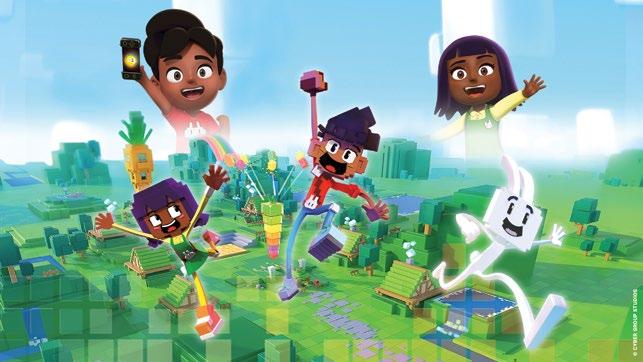
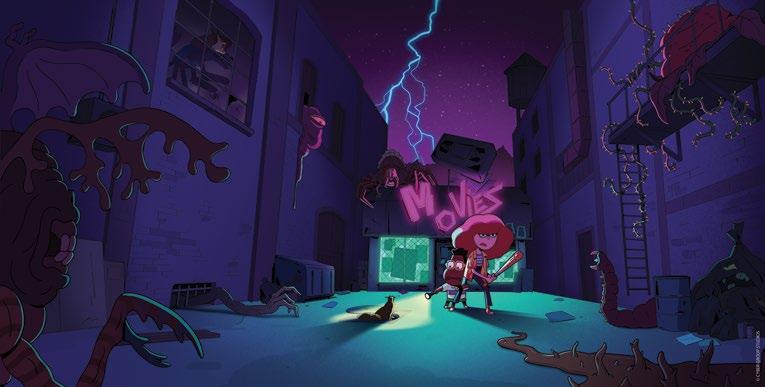
and Singapore. In this show, our amazing director, Arnaud Bouron, is magnificently pushing the boundaries of real-time animation technology applied to linear animation. Press Start! is our very first show with Peacock, executive produced by Scott Kraft (PAW Patrol) and directed by Éric Cazes (Vic The Viking). The series is based on the Scholastic best seller that has sold more than 3.9 million copies (across the U.S., Canada, China, Korea and in most European and Latin American countries).
What are some of the goals of the studio in 2023 and beyond?
We will continue developing great content and try to push the boundaries of quality and originality whenever possible. We have a few sneak previews of our shows in development for the people we will meet at MIFA, including brand-new series.
What would you say are the biggest challenges faced by indie studios this year?
The current market situation is challenging as our industry’s old paradigm is rapidly changing. Among the changes: content consumption tends to shift from linear broadcasters to streaming platforms, SVOD players must now become prof-

itable, and audience fragmentation reduces the awareness of new IPs and increases the hurdle to build them into global franchises. In such a market environment, agility is a key success factor. The good news is that this skill resides more on the indie side than on the majors.
What would you like our readers to know about Cyber Group Studios?
Our passion is to tell great stories that will entertain and move children and families around the world. Our track record in building global IPs with a large diversity of animation types and genres (2D/3D/cartoon/comedy/ preschool/bridge/kids/tweens, etc.), helps us attract the best talent and we are always on the lookout for top artists, writers, show runners, engineers and other key professionals.
We have a strong culture of innovation and are thrilled with the opportunity to reengineer the way we produce series, thanks to real-time animation, AI, and machine learning that help us create new entertainment experiences. Besides producing our own shows, we also love working on production services for other producers in various parts of the world. ◆
For more info, visit cybergroupstudios.com.
jun|jul 23 47 www.animationmagazine.net TV/STREAMING
Dominique Bourse
Erica and Trevor vs. the Spooky Monsters
Press Start!
Secrets of the Festival’s Artistic Director!
Annecy Festival’s artistic director Marcel Jean has been curating exquisite collections of animated fare from all over the world for the past 10 years. We caught up with the Canadian producer, director and writer to find out more about this year’s program and how he juggles the many different demands of the job.

Congrats on putting together another edition of the festival! How long did you work on the selection and organization this year?
Marcel Jean: The selection is a long-term job that is built throughout the year, even from one year to the next. This is particularly the case for the Mexican programming that we have been thinking about since we had in mind to put this animation in the spotlight this year.
What is the number of festival staff and volunteers this year?
More than 125 people are mobilized to organize the festival and the MIFA, to which are added around 500 volunteers.
What are some of the highlights that we cannot miss this year?
You ask me to pick my favorite among my children! It’s Sophie’s Choice! It depends on every festivalgoer. However, I would say that the real “can’t misses” are in the Screening Events or in the WIP category, simply because it’s exclusive content. I mean, it will be possible to see the films in selection after the festival. You can’t say that about a WIP session or a Making of session, or a Masterclass. Personally, I would not miss Barry Purves’ and Eric Goldberg’s masterclasses, or the WIP session with Chris Lavis and Maciek Szczerbowski about their short film The Girl Who Cried Pearls. I have already mentioned the Mexican selection, but I encourage all festivalgoers to discover, through five dedicated programs in particular, these singular
works that are still too little known. Also recommended, a healthy ascent after the fondues to go to the Museum-Château to discover the exhibition devoted to the talented director of Blind Vaysha and The Physics of Sorrow, Theodore Ushev.
Which restaurants or bars are absolute musts for first-time visitors in Annecy?
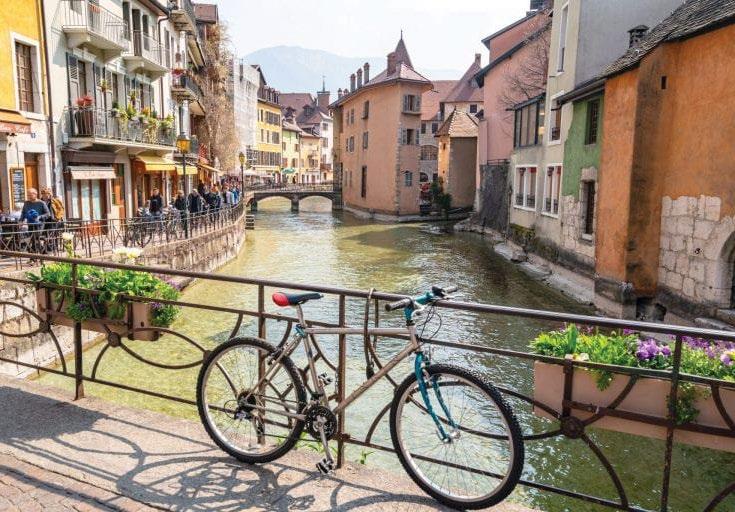
A visit to Chez Ingalls for lunch or dinner in the interior garden, in the Cour du Pré Carré after the last screening, at Los Primos to find Mexican artists, or Café des Arts, where you will find many students. In the morning, I take my coffee at Regann or La Belle Époque.
What gives you the biggest headaches?
My main problem is a first-world problem: the quantity and the quality of the feature films received, which forced us to make a drastic selection. Given the richness in all the categories presented, we have also taken the decision to extend the festival by one day.
www.animationmagazine.net 48 jun|jul 23 EVENTS
Marcel Jean
What is your take on the state of animation in 2023?

The industry is still in development. Every year we receive films from more and more countries. This diversity is remarkable. Five or six years ago, it was possible to notice this diversity in the short films submissions. Now, you can see good features from a lot of different countries. For example, this year we have a Jordanian feature, Saleem, and one from Cameroon, The Sacred Cave. Adult entertainment is also gaining ground, which is excellent news.
What kind of advice do you give young animators who dream of making something to be spotlighted at the festival?


Do not restrict the field of their inspirations,
THIS YEAR’S COLLECTION: Among the 2023 edition’s highlights (clockwise from top left): A masterclass taught by stop-motion legend Barry Purves, an exhibit devoted to the works of Theodore Ushev (pictured: Blind Vaysha), a Disney spotlight featuring the new movie Wish, John Musker’s new short I’m Hip and a WIP session on Chris Lavis and Maciek Szczerbowski’s The Girl Who Cried Pearls
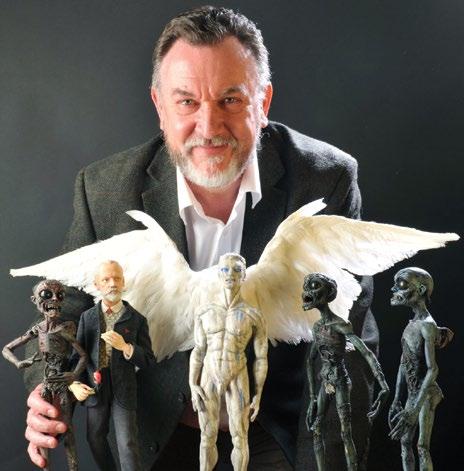
do not hesitate to approach all topics and play with techniques to put them at the service of their stories. And while waiting to be ready, take advantage of the numerous and fantastic sources of inspiration available to them in Annecy, among others by participating in the MIFA Campus, dedicated to young talents. Attend film lessons, go see films in theaters!
Do you ever miss the smaller, quieter editions of the festival?
I don’t really have this nostalgia … The main difference between then and now is that in the past there was only one way to pass through the festival and, now, you have to find your own trail. You can come with a friend and the two of you will live a completely
different experience. It says the variety and the complexity of our community now.
What is Annecy’s best-kept secret?
La Turbine and Le Mikado! These two facilities are not so far from the center and sometimes it’s much easier to have a ticket to a film that is sold out at Bonlieu or at the Pathé. It’s easy to go there by bus, or even to walk.
What will you do when the festival is over?
Two weeks ago I bought a house in the countryside in Canada, a few minutes from the Vermont border … You will find me there this summer! ◆
For more info about the Annecy Festival (June 11-17) and MIFA market (June 13-16), visit annecyfestival.com.

jun/jul 23 49 www.animationmagazine.net EVENTS
An Abundance of Eclectic Movies at Annecy
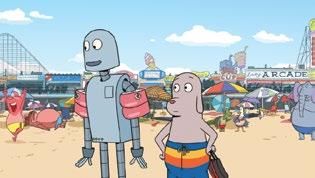
It’s no secret that you can get a pretty comprehensive look at what the animation feature world has in store for the next couple of years by attending the Annecy Festival in June. This year is no exception, as audiences are invited to enjoy 20 amazing animated pics ready for release around the world. We have written about some of them in these pages before, and we’ll promise to cover them in future editions of the magazine in the upcoming months!





Official Competition Titles
• Art College 1994 (directed by Liu Jian, China)
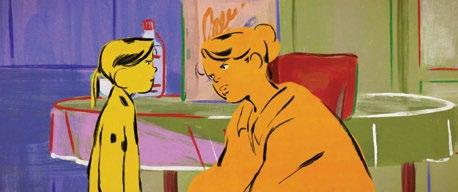
• Chicken for Linda! (Chiara Malta & Sébastien Laudenbach, France/Italy)
• Detective Conan: Black Iron Submarine (Yuzuru Tachikawa, Japan)

• Four Souls of Coyote (Áron Gauder, Hungary)
• The Inseparables (Jérémie Degruson, Belgium/Spain/France)
• The Inventor (Jim Capobianco & Pierre-Luc Granjon, U.S./France/Ireland)
• Kensuke’s Kingdom (Neil Boyle & Kirk Hendry, U.K./Luxembourg)
• Lonely Castle in the Mirror (Keiichi Hara, Japan)
• Mars Express (Jérémie Périn, France)
• The Siren (Sepideh Farsi, Germany/Belgium/France/Luxembourg)
• Sirocco and the Kingdom of the Winds (Benoît Chieux, Belgium/France)
• The Tunnel to Summer, the Exit of Goodbyes (Tomohisa Taguchi, Japan)
www.animationmagazine.net 50 jun|jul 23 EVENTS
Art College 1994
Robot Dreams
Chicken for Linda!
The Inventor
The Tunnel to Summer, the Exit of Goodbyes
Slide
Tony, Shelley and the Magic Light
Kensuke’s Kingdom
Contrechamp Sidebar
Running for the sixth year, the Contrechamp Competition will also offer up 12 eclectic animated features:
• When Adam Changes (Joël Vaudreuil, Canada)
• Tender Metalheads (Carlos Perez-Reche & Joan Tomas, Spain)
• Johnny & Me – A Journey through Time with John Heartfield (Katrin Rothe, Germany/Austria/Switzerland)
• Komada – A Whisky Family (Masayuki Yoshihara, Japan)
• The Sacred Cave ( Daniel Minlo & Cyrille Masso, Cameroon)
• Robot Dreams (Pablo Berger, Spain/France)
• Rosa and the Stone Troll (Karla Nor Holmbäck, Denmark)
• Saleem (Cynthia Madanat Sharaiha, Jordan)
• Slide (Bill Plympton, U.S.)
• Toldi (Marcell Jankovics & Csakovics Lajos, Hungary)
• Tony, Shelly and the Magic Light (Filip Pošivač, Hungary/Czech Rep./Slovakia)
• White Plastic Sky (Tibor Banoczki & Sarolta Szabo, Hungary/Slovakia)
Special Screenings and Works in Progress
• Walt Disney Animation Studios continues its 100th birthday bash with several celebratory events. In addition to the TBA short opening the fest, CCO Jennifer Lee will be in attendance to share more details of Wish, which she helped write and exec produce. The studio will also present a screening of Fantasia 2000 with director Eric Goldberg
• Pixar Animation Studios will present never-before-seen materials from its first original series Win or Lose (Disney+) and will be screening Elemental, following the film’s Cannes premiere.
• Disney+ projects are in the mix with a first look at the new anthology Kizazi Moto: Generation Fire with three directors presenting, and a behind-the-scenes session on Star Wars: Visions Vol. 2 shorts Screecher’s Reach (Cartoon Saloon), In the Stars (PunkRobot) and The Spy Dancer (Studio La Cachette).
• Sony Pictures Animation will screen the short film The Spider Within: A Spider-Verse Story, the first project from the studio’s new shorts program elevating talents from underrepresented groups, and reveal a first look at the studio’s first-ever R-rated comedy, Fixed, from animation auteur Genndy Tartakovsky
• Warner Bros. Animation will offer glimpses at The Lord of the Rings: The War of Rohirrim by Kenji Kamiyama and Rick and Morty: 10 Years of Intergalactic Adventures
• Nickelodeon Animation Studios will bring Teenage Mutant Ninja Turtles: Mutant Mayhem (Paramount Pictures/Nickelodeon Movies) out of the sewers for a Work-in-Progress sneak peek.
• Illumination will present its original high-flying comedy-adventure Migration (Universal Pictures), directed by Benjamin Renner
• DreamWorks Animation will premiere Ruby Gillman, Teenage Kraken (Universal Pictures) at the event, attended by director Kirk DeMicco, producer Kelly Cooney Cilella and co-director Faryn Pearl, as well as presenting a WIP session on Trolls: Band Together and a special outdoor screening of its hit sequel Puss in Boots: The Last Wish
• Netflix is planning a jam-packed program, including a special screening and “Making of” for Nimona, panels with the creative teams behind Aardman’s Chicken Run: Dawn of the Nugget and upcoming series Blue Eye Samurai, a major “What’s Next” panel and more.
• Audiences will also be treated to screenings of Kaina of the Great Snow Sea: Star Sage directed by Hiroaki Ando, Ozi, Voice of the Forest by Tim Harper, The Forest of Miss Tang by Denis Do, Garden of Remembrance by Naoko Yamada, Nina et le Secret du hérisson (Nina and Hedgehog’s Secret) by Alain Gagnol and Jean-Loup Felicioli and The Canterville Ghost by Kim Burdon.
The Work in Progress (WIP) sessions will introduce 17 projects in production: 12 feature films, one series, three VR experiences and one short film. Among these are buzzy titles like Roy and Arturo Ambriz’s Frankelda and the Prince of Spooks and the Warner Bros. Animation/Anima Estudios movie Aztec Batman: Clash of Empires, both part of this year’s Mexican Animation Spotlight; Apple/ Skydance feature Spellbound directed by Vicky Jenson; and new projects from hot international talents like Jean-François Laguionie (Slocum), Gints Zilbalodis (Flow) and Bobbypills (Captain Laserhawk: A Blood Dragon Remix by Mehdi Leffad).
For more info, visit annecyfestival.com.
jun/jul 23 51 www.animationmagazine.net EVENTS
Shorts That Leave Long-Lasting Impressions
We take a look at eight of the wonderful new animated shorts curated for Annecy’s Official Selection this year.
Sweet Like Lemons
Directed by Jenny Jokela (Finland, U.K.)
Sometimes animation can help you work out unresolved feelings left over from a bad relationship. That’s what happened to Finnish director Jenny Jokela as she set out to make her stylish new short, Sweet Like Lemons. “Although the film doesn’t directly depict me or the other person involved, the inspiration of the film was to create a therapeutic process for myself so I could work through the emotions and struggles of a bad relationship,” she admits.
The director, who won a Cristal award at Annecy for her 2018 student short Barbecue, began working on her new short at the Fontevraud residency (NEF Animation) in France five years ago. The majority of the short was animated in 2021 and painted in 2022. She animated it digitally with TVPaint, then printed out each frame and painted it by hand on paper using acrylic paint.
“Traditional narrative does not come naturally to me, and my films therefore tend to focus more on taking the viewer on an emotional and symbolic
journey,” says Jokela. “Although I knew exactly what each color and figure symbolized, I struggled to order the sequences to create a storyboard. So, I sent all my imagery, animated bits and rambling explanations to writer Celia Hillo. I explained to her that the film is about needing to accept closure without actually feeling you have the answers that you need. In her text, she got this exact sentiment articulated by writing it in email format, which is something I incorporated in the final movie.”
Although she studied animation at Royal College of Art, Jokela points out that she was originally self-taught. “I was studying fashion branding and had no idea about the world of independent animation until I came across the work of Swedish animation artist Nathalie Djurberg,” says the director. “She was one of the main inspirations for me when starting to learn how to animate and, to this day, I’m influenced by her work. Another current inspiration to me is Dash Shaw, I really like both his comics and films.”
The talented filmmaker is optimistic about the state of indie animation. “Although funding for animation keeps getting cut and harder to come by, somehow people still keep managing to make really inspirational and creative work,” says Jokela. “With so many apps and AI auto-generated animation I have found that on the counter side, there is also a growing appreciation for traditional animation that is harder to recreate automatically. That’s very nice for someone like me who likes to spend my time painting!”
La Perra (The Bitch) Directed by Carla Melo Gampert (Colombia, France)
In Carla Melo Gampert’s powerful short La Perra (The Bitch), a young girl leaves her domineering mom and the family dog to explore her sexuality. The Colombian director explains that several events in her own life inspired her work. “My mother gave me my puppy, Conga, when I was 11, after my parents separated,” she notes. “Conga died when I was 25 years old, and I still feel guilty that I missed the last months of her life as I was staying at my boyfriend’s house at the time. My dog’s death made me reflect a lot on the passage of time and what it means to be a mother and a bitch: the animal and the woman.”
Melo Gampert began the production of the film in June of 2011, and it took her and her team about two years and eight months to complete the project. The animation was provided by Evidencia Films in Colombia and June Films in France, coproduced by ARTE France.
“Everything was done by hand, 12 frames per second,” she recalls. “We would capture the line
drawings with a camera to see if they worked — if they lacked fluidity or if the movement needed a pause. Once the drawings were approved, we moved on to color with inks and watercolors. I was looking for mistakes, accidents and stains. I felt that there was something interesting in dirtying the traces — to feel the human touch behind the brush. I think that ‘not knowing how to do it’ was very positive for the special qualities of the short film, because we let ourselves be led by an intuition that allows you see the humanity in the images.”
Mentioning Florence Miailhe, Marta Pajek and Elizabeth Hobbs as animation artists who have been
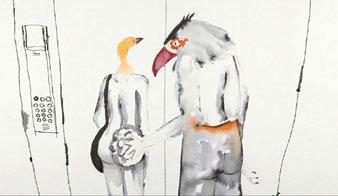

sources of inspiration, Malo Gampert says she loved the way the characters in her short began to have a life of their own and came from the unconscious of everyone who worked on the crew. “There are also parts that make me laugh a lot, and others that connect me with the child I was and the sadness I carried. The animation has the ability to surprise its creator and reveal the unknown.”
The director believes something very powerful is happening in animation globally. “I feel that the world is becoming more interested in animation and it’s not only for children or commercial purposes,” she says. “Latin American animation is also becoming more visible. It’s used as a tool to think about the body, the image, cinema, whatever comes to mind. There are more and more short films that explore intimacy and femininity. With my colleagues in Colombia, we are curating Latin American shorts that reveal not only the inner lives of people, but also touch on political and historical issues to reveal new layers without falling into stereotypes.”
www.animationmagazine.net 52 jun|jul 23 EVENTS
British director Stephen Irwin has impressed animation festival audiences in years past with award-winning shorts such as Moxie, The Obvious Child and Wood Child and Hidden Forest Mother. This year, he’s back at Annecy with a stylish and haunting new short, titled World to Roam Watching his son grow up gave him the idea for the short. “It’s a horrible cliché, but they really do grow up so fast!” says Irwin. “He’s eight now and looking at videos of him as a toddler always makes me slightly mournful. There are versions of him I’ll never meet again. You don’t notice it at the time, but they’re suddenly gone, replaced by a new version, who in turn will also disappear one day. And it just keeps happening!”
Irwin used After Effects, Photoshop, Premiere, Audition, “all the usual Adobe suspects” to produce the animation. “I did everything myself, apart from narrate it,” he says. “Animation, sound design, editing, casting, sorting music rights, making cups of tea — you have to take
World to Roam
Directed by Stephen Irwin (U.K.)
on many roles with a zero budget!”
He says he can’t exactly say when he started working on it since there were so many false starts. “I applied for funding a couple of years ago but wasn’t successful,” he recalls “Without any money I had to change how the film would be made. The story didn’t change much, but the technique I’d hoped
using works well. It actually pushed elements of the story in new directions, too.”
to use wasn’t possible without a team. It had to be something I could do alone, without any assistance (which is how most of my other films have been made). Ultimately though, I’m pleased with the way it went. Having some money would have been nice of course, but I think the style/technique I ended up
Maurice’s Bar
Not surprisingly, he says auteurs like Yuri Norstein, Suzan Pitt, Don Hertzfeldt, Amanda Forbis & Wendy Tilby, Pendleton Ward and Kōji Yamamura are a few of his animation heroes. He also says he misses the online community Vimeo built about 10 years ago. “I still watch a lot of stuff on there, but not nearly as much,” says Irwin. “Instagram is great for seeing what other animators are working on, but I wouldn’t watch an entire short on there. There’s still loads of fantastic work being made each year. Trends come and go. Festival curation is just as varied and strong. What’s interesting to me now is seeing the different paths other animators have taken, and how their work has evolved over the years.”
“I’m always surprised and delighted by the different ways in which people interpret my films, be it positive or negative,” he concludes. “I consider anything other than complete boredom a win!”
Directed by Tom Prezman & Tzor Edery (France)
Tom Prezman and Tzor Edery’s Maurice’s Bar dovetails perfectly with Annecy’s spotlight on LGBTQ+ content and filmmakers this year. The short tells the story of one of Paris’s first gay bars as seen through the eyes of a former drag queen.

“We learned about this place through our friend Noam Sienna, a researcher of North African Jewish history, who together with Leslie Choquette had done a thorough investigation on the life of Moïse Zekri, a.k.a. Maurice l’Algerien,” says Prezman. “We used this research as inspiration for our interpretation of what the bar might have been like. Our film takes some liberties with the facts and creates a subjective view of Maurice and his bar, told through rumors and gossip by clients and filtered through our modern queer lens.”
The filmmakers began working on their labor of love in early 2020 and finished it in March of this year. “We used Toon Boom Harmony for animation,” says Prezman. “While the film is mostly made digitally, we worked with handmade textures and elements using aquatint and etching printing technique to make the final look. Our crew consisted of four animators,
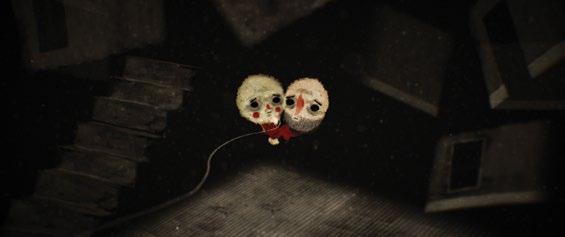
including Tzor and I, and three more artists working on clean-up and color.”
One of the biggest challenges for the directors was casting 11 queer actors in the main roles, since the main cast had to be trans or non-binary actresses like the characters themselves, and some needed to speak Arabic. “It was really important for us to be authentic when portraying a queer bar in 1906 Paris,” says the director. “Another challenge was making a film in a language we didn’t speak
According to Prezman, the style influences were films that use flat, graphic designs with a big focus on silhouette, that still convey sensuality and a sense of physicality. “Queer animation is still developing, and we take a lot of our influence from live-action films in the genre. We love the films of Pedro Almodóvar, his portrayal of sexuality and gender was one of our biggest inspirations,” he adds.
The filmmaker says animated shorts are a great way to be as uncompromising as possible. “It’s a big commitment to make a film of any length, but in a short, you can take on a lot of different roles and still see your handprint in every aspect of the film,” he says. “It’s also a very free medium in terms of expression and narrative.”
in the beginning. We learned French from scratch in order to correctly write the dialogues and to work with the actors. We also had two animators that only spoke French, so we improved in the process of making the film.”
“We hope that people who see themselves belonging in the bar will be able to connect with the themes, the campy vibes and humor,” he concludes. “We also hope that it will give people a glimpse into a hidden part of queer history and the social issues the film addresses. We wanted to make a film that’s very political, but also doesn’t take itself too seriously. The characters are all persecuted, but through it they carry themselves with strength, selfconfidence, and a sense of humor.”
jun/jul 23 53 www.animationmagazine.net EVENTS
The Miracle Directed by Nienke Deutz (Belgium, France, The Netherlands)
An all-inclusive tourist resort is the setting for Nienke Deutz’s insightful new short, The Miracle. “The portrayal of pregnancy and motherhood in pop culture ignited my idea for the project,” she says. “Both are passionately celebrated, but at the same time the emotions of women who — for whatever reason — do not conceive, often seem to be hushed up and ignored.”

The Dutch filmmaker first came into prominence with her previous short Bloomstreet 11 in 2018. She began working on her short in 2019 and took two years to produce the project. “The film is a combination of 2D animation and stop motion,” she explains. “First, the characters are animated in 2D, these drawings are printed on transparent sheets, then cut out and hand painted. We built physical sets and reanimated the characters frame by frame in those sets.”
So, what was the biggest challenge? “To keep my cool during the intense period of production,” she admits. “It was a lot to juggle — thousands of frames and a giant set! I’ve learned so many lessons, especially in the field of time management. It is so important it is to have good planning and always be a few steps
ahead of the process.”
Deutz says she loves the work of Allison Schulnik. “They feel like such a pure form of animation, and I can look at it forever. In terms of storytelling, one of the best shorts I have seen in a while is It’s Nice in Here by Robert-Jonathan Koeyers.”
She also points out that she loves working in the animated short world. “It’s a great format to use bold styles and because of the limited time available, it drives me to the core of the narrative,” says Deutz. “In The Miracle, I wanted to show a woman who has struggles and doubts around pregnancy and motherhood, but who
Catisfaction
finds humor and strength in her situation. I would love for the film to inspire and open up a conversation around this topic.”
Directed by André Almeida (Portgual)
We’ve seen an abundance of wonderful animated shorts created by Portuguese artists in recent years. The latest example is André Almeida’s imaginative film involving a man, his cat and a surreal dream.
“I was driving my own Vespa, and imagined myself standing up and opening my arms while trying to control the bike at full speed,” remembers Almeida. “At this moment, a cat crossed my path and I almost fell off the bike. As I was creating the story, I realized that the scenes in the short were connected to my life in one way or another.”
Almeida made the Catisfaction all by himself, with the exception of the audio and the music, which were created by André Freitas and Gonçalo Abrantes, respectively. He used the 3D software Cinema 4D; Arnold renderer, Marvelous Designer, After

Effects and ZBrush to produce the animation. It took him about two years to complete the production. “This was my first short film, so the main challenge for me was finding a narrative for a series of creative moments,” he recalls. “I knew what kind of story I wanted to tell, and that I didn’t want it to be an obvious or very clear one.”
The director mentions that he loves to watch the movies of Hayao Miyazaki and Satoshi Kon. “I
also find inspiration in the work of David Lynch, Christopher Nolan and Akira Kurosawa,” he says. “More recently, the work of Alberto Mielgo got me excited to work on animated short films. As a video artist working with 3D animation for the last 13 years in advertising, I’m familiar with the process of telling a story in a short format. I also love to work in animation because it allows me to combine video, photography, drawing, motion graphics and storytelling.”
Almeida says he hopes audiences find Catisfaction bold and different from what they are used to watching. “I never wanted to do something that was obvious. I would like them to think about how a single relationship can shape our life forever either with a human or an animal. It’s important to reflect on the meaning of our relationships — even if it’s between a man and a cat.”
www.animationmagazine.net 54 jun|jul 23 EVENTS
La Grande Arche (The Great Arc) Directed by Camille Authouart (France)
Camille Authouart pays homage to an oftenignored neighborhood in her hand-crafted new short La Grande Arche (The Great Arc). She began writing the short in 2017, but the production actually began in 2021, and wrapped up a year later.

“At the origin of the project, there is a heart attack and then a move,” she tells us. “A few months later, I had the desire to come back and walk around the neighborhood with a sketchbook, just to draw the skyscrapers. For more than a month, I filled the pages daily with notes and drawings made in the unpopular district of La Défense in Paris. This is the business district where my grandmother had lived in the same apartment for almost 60 years. Everyone hates this neighborhood, but she taught me to love it.”
The backgrounds for the short are drawn by hand on paper and all the animation was done using TVPaint and then embedded in the backgrounds during compositing. “I did all the backgrounds and part of the layout and worked with a wonderful team of five animators for about five months.”
Authouart says it was quite stressful but very constructive to manage a team. “As I’m not an animator myself, I tried to make sure to guide them while leaving them a space of freedom and proposal,” she recalls. “It was also a way for me to take a step back from the film by letting them put
The director says she was recently moved by two animated films: Flee by Jonas Poher Rasmussen and Nayola by José Miguel Ribeiro. “I believe that there are stories, emotions, that can only be told through the filter of drawing,” she says. “Flee and Nayola are great examples of that and are one of those movies that make me want to continue directing.”
something of themselves into it. After four years of working on it alone, the film started to take shape during the animation stage. It allowed me to detach myself from it a little and thus better accept it — with its positive qualities and its faults.”
Salvation Has No Name
The message she strives to relate with the short is, that it’s all a matter of perspective. “I rely on this idea to highlight the poetry that I found in the heart of this unpopular district of Paris,” notes the director. “In the collective imagination, it’s often reduced to a capitalistic, concrete district, with gigantic office towers, invaded by employees and executives. But it’s actually a place of great social and cultural diversity. This constantly changing neighborhood belongs to everyone and to no one. In The Great Arc, we follow two residents of the district, two forgotten people able to grasp the astonishing contrasts of this place, sometimes finding something marvelous, and sometimes tragic in the infinite reflections of the skyscrapers.”
Directed by Joseph Wallace (U.K., France, Czech Republic)
Bristol-born director Joseph Wallace has worked on Salvation Has No Name, his powerful stop-motion short about the global refugee crisis, for almost a decade. “It has been a passion project of mine for several years and I began working on the development of the film around 2014, but support for adult, independent animation in the U.K. has been mostly non-existent for the past couple of decades. It took a long time to find partners and raise finance for the film.”
The short evolved from Wallace’s own personal fears of the rise of rightwing nationalism across Europe and lack of sympathy for asylum seekers. “This thematic exploration, along with wanting to tell a story in a theatrical manner, whilst exploring the downfall of a priest, all came together to make Salvation Has No Name,” he notes.
Wallace used textural black-and-white puppet animation to tell his story. The puppets were made from wood, metal, paper and fabric, and have a sculptural feel to them. The 15-minute

tight budget,” says the director. “Throughout my career I’ve always tried to make epic, cinematic imagery on screen using humble, often recycled materials. For this film, all of that was amplified. I also learned a lot about letting go and delegating; learning to trust the team, trust the process, focus on the vision and remember that tiny details aren’t everything as the film is a sum of many parts.”
short was shot digitally on Canon cameras with Dragonframe. The film also employs cut-out animation using imagery from Victorian etchings.
“The biggest challenge was probably making such a grand and ambitious story on a very
“This film is a particularly political story, dealing with the kind of themes that we don’t often see in animation but especially not in puppet animation,” Wallace points out. “I hope that the aesthetic and the storytelling style are unique. And while the film deals with these challenging topics, I hope there is also a sense of hope from the film and that the short acts as a catalyst for conversation and contemplation.” ◆
jun/jul 23 55 www.animationmagazine.net EVENTS
First Look:
Netflix Animation offers a sneak peek at its 2023 slate at Annecy!
Netflix is among the many studios gathering in France this month to showcase their hot new animated offerings at the Annecy Festival. Here are some exclusive first-look images and quotes from the creative teams behind the features and series:
Director Sam Fell
Chicken Run: Dawn of the Nugget
Premieres Dec. 22, 2023
“Like the first Chicken Run movie, Dawn of the Nugget is a major milestone for Aardman. We’ve thrown everything we’ve got at this one — it’s a one of a kind, lovingly handcrafted stop-motion marvel — the culmination of 40 years of Aardman’s technical and creative development. We didn’t just make it to stand out this year, but for decades to come. We want the audience to walk away having been totally entertained — to have had a laugh, shed a tear and been on the edge of their seats to the final frame. If they think a bit more like chickens as the credits roll then that’s no bad thing, either! “
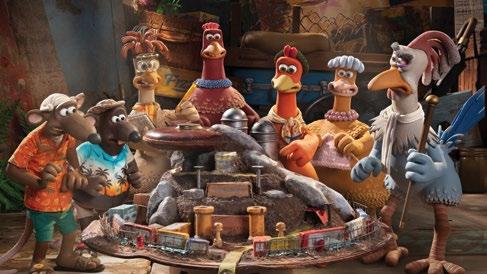
Director Anthony Stacchi
The Monkey King
Premieres Aug. 2023
“We hope that our Monkey King origin story will introduce the Journey to the parts of the world that have never heard of it before and give a fresh, fun take on the story for folks who have grown up with this wonderful tale. One thing that makes our movie special is our cast — Jimmy O. Yang, Jolie-Hoang Rappaport and Bowen Yang show levels of emotional acting, singing and fun that we’ve never seen from them before, and they are just the top of our all Asian cast of gods and demons.”
Producer Peilin Chou
The Monkey King
“I’m so excited for audiences to discover The Monkey King! It’s such a beloved and iconic tale that I grew up with, so it’s particularly exciting to share it in a global animated film for the very first time. I also really love the themes in our film, particularly the notion of writing your own scroll, and the belief that we all have the ability to do great things if we believe in ourselves and are true to who we are.
“We have some of the most authentic and dynamic kung fu action fighting sequences I have ever seen in animation. We had a truly fantastic fight choreographer based out of Beijing (named Siwei) who designed each fight to be complex and totally unique. Also, our cast is truly amazing, particularly Bowen Yang and Jimmy O. Yang in such memorable roles that really land the irreverent Stephen Chow-esque comedic tone throughout our film in the most satisfying way. We also have fantastic songs written by Toby Marlow and Lucy Moss (Tony Award winners for Broadway’s Six). Though our film is not a musical, there are some really exciting and hilarious musical moments that kind of steal the show throughout the film. Fair warning: Once you hear the Monkey King theme song, it will not leave your head!”
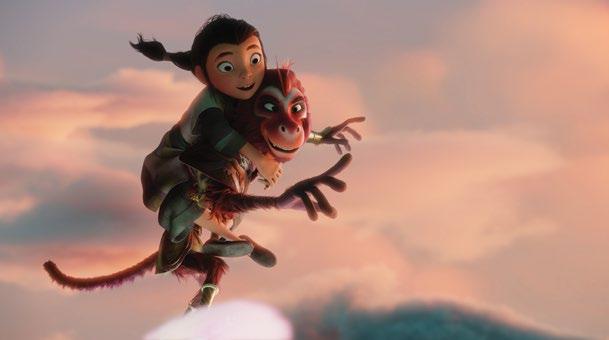
www.animationmagazine.net 56 jun|jul 23 EVENTS
Directors Robert Marianetti, Robert Smigel & David Wachtenheim
Leo
Premieres Nov. 2023
“A comedy about talking class pets will, of course, have plenty of goofy moments, and a lot of humor that resonates with both kids and parents. But we hope people are touched by what the characters learn over the course of the movie … the importance of finding someone to share your concerns and anxieties with, and the incredible inherent rewards in being a good teacher, mentor or friend.
“With Adam Sandler, Bill Burr, Cecily Strong, a great script and silly songs, we hope people will find it one of the funniest animated films of the year. But, while we›ve collaborated on many crazy projects, going back to our SNL TV Funhouse cartoons, Leo is a little different. Aside from the central character being a very old class pet, our story is also about honest emotions and situations that every kid (and parent) experiences in elementary school. People of all ages will relate to it. And so will talking lizards!”
Creator/Writer/Executive Producer
Amber Noizumi
Blue Eye Samurai
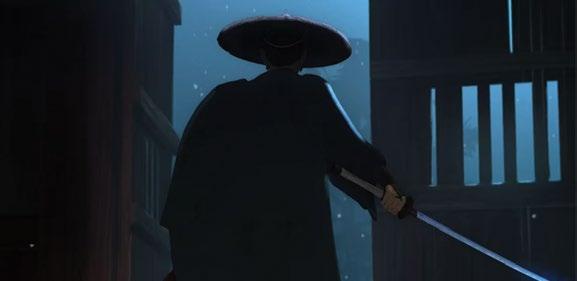
Premieres Late 2023
“We hope the mature themes and content, produced like in live action — complete with a world-class stunt coordinator, costume designer, previs artists and historians — elevate our show into animation no one has ever seen. We want the audience to feel an attachment to our mixed-race hero — feeling her pain, her rage — as if she were played by a live-action actor, and a story they can’t put down.”

Directors Nick Bruno & Troy Quane
Nimona
Premieres June 30, 2023
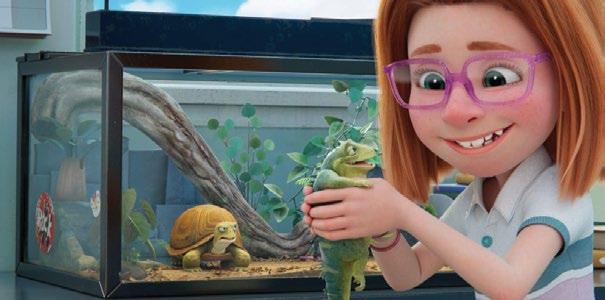
“With so many animated films to be excited for this year, only one … is punk! Set in a techno-medieval future, Nimona is a spiky, spunky, shapeshifting ball of limitless capability and chaos who is sure to help us all realize that what makes us awesome is worth fighting for. This movie is a love letter to all those who have ever felt different, or misunderstood.
“As directors, we believe it is our responsibility to think about what kind of conversation viewers will have after watching our film. For Nimona, the message is simple: Get to know people! Look beyond the labels and opinions others have created. By forming our own opinions and questioning the opinions that came before, we can see others for their authentic selves. That’s all any of us could ever want.” ◆
jun/jul 23 57 www.animationmagazine.net EVENTS
Imagination Immersion

The innovative VR projects featured at this year’s Annecy program invite audiences to participate in emotional experiences.
- By Ellen Wolff -
The Annecy Festival has long been a mecca for animation lovers of all kinds, who travel to the picturesque French city every spring for a deep dive into the animation arts. This year, the festival organizers are again ensuring that virtual reality aficionados can experience the latest offerings of this emerging medium. Annecy’s VR category will present seven works in competition, representing productions from Taiwan, Germany, France, Canada, Denmark, the U.K. and the U.S. The subject matter of these works couldn’t be more diverse — in one, we experience the breakdown of a society over time in a handdrawn, mythical town; in another, we experience a high-flying encounter between an eagle and the pilot of a military drone.
At Annecy, the VR selections will be presented in a headset-equipped space in Bonlieu, the festival’s main venue. And organizers are planning ad-
Red Tail
Directed
by Fish Wang
The prospect of using virtual reality to evoke feelings of empathy is what inspired Taiwanese animator/director Fish Wang to create Red Tail. The 20-minute project follows a boy’s encounters with strange characters in fantastical places, including a train station floating amidst clouds.
Intrigued by the sight of a mysterious red tail, the boy chases it into a realm of illusion. “I used to believe that images have a deep immersion effect,” says Wang. “But VR expands this illusion even more. It’s like a waking dream. When memories are lost day after day, recollections become fragmented or flat, but with VR machines, they are comprehensive, continuous and inescapable.”
ditional presentations in the XR area at the MIFA marketplace, which runs concurrently.
One Annecy attendee who’s excited about being immersed in such different worlds is The Book of Life and Maya and the Three director/creator Jorge Gutierrez, who’ll be co-judging the virtual reality competition alongside Canadian filmmaker Chris Lavis and Swiss indie artist Manu Weiss. Gutierrez, who’s currently developing the Netflix animated feature I, Chihuahua, knows first-hand the challenges of creating VR. Way back in 2016, (a lifetime ago in VR years) Gutierrez broke new ground by directing the Emmy-nominated VR piece Son of Jaguar for Google Spotlight Stories. “Even then, the pieces that worked best were the emotional ones — the ones that let you walk in another’s shoes,” he recalls. “If something can make you laugh or cry, it’s a triumph. And after you watch it, you think — which to me is the Holy Grail.”
“Although the VR medium is more or less compulsive, the subject of Red Tail is not too much about stimulating or assaulting the audience to gain a sense of fun,” adds Wang. “It’s more about allowing the audience to watch the boy’s encounter from a safe distance, and slowly evoke their own empathy.”


Wang’s 10-person team spent two years developing and animating the project, which has the look of clay figures brought to life. Wang, who began working in VR only in the past two years, describes how he achieved this look: “After the physical models were made, we used photogrammetry to scan them into 3D models. The subsequent process was like the operation of all 3D animation. When we finished the animation, we then used the Unreal
game engine to do the integration.”
“One of the most difficult parts was the funding, which I believe most independents have encountered,” observes Wang. “We received funding from the government and semi-governmental organizations, as well as technical investment from technology companies.”
Wang’s experience reminds Gutierrez of what he calls “the chicken-and-egg question” facing VR creators today: “How can people justify the expense of making these? That’s the real conundrum.” (Even Gutierrez’s Son of Jaguar backers at Google retired the Spotlight Stories program years ago.) Without deep-pocketed patrons, Gutierrez likens VR creators to “an indie band that’s trying to survive!”

www.animationmagazine.net 58 jun|jul 23
“Typically, if you’re lucky, maybe 50 people per day will get to experience your piece. But students are going to do it. Their inventive, rebellious, punk rock spirit can lead to interesting things.”
—
Director Jorge R. Gutierrez, Annecy Festival 2023 VR juror
SPOTLIGHT VR
From the Main Square Sol-Air Red Tail
Sol-Air
Directed by Mihai Grecu
Funding VR productions remains challenging even for those who’ve been at it for a while, which is probably not surprising, given the evolving nature of the technologies being used. That’s been the experience of producer François Martin Saint Léon of Barberousse Films, the French company behind the 15-minute VR piece Sol-Air
“Since 2017, Barberousse Films has been producing virtual reality experiences in addition to its film and audiovisual activities,” he explains. “Sol-Air was initiated in 2018, but the search for funding and production were slowed down by COVID.”
Even without that unpredictable obstacle, a particular challenge of making Sol-Air was bud-
geting the visual effects work that would be needed to realize the script. Romanian writer/ director Mihai Grecu wanted to film a living eagle for his story about the creature’s interaction with a military drone soaring above a desert landscape.
“We did that in a studio on a greenscreen with powerful fans,” explains Saint Léon. “It was difficult to film, but it was important not to give in completely to full 3D. This is an experience that mixes all possible VR techniques: pre-calculated 3D, interactive real-time 3D and 360-degree imagery. There’s a variety of techniques that make the experience undoubtedly strange.”
Saint Léon notes that his project an experience that is easy to access with a simple installation designed for Meta Quest 2, and the producer plans to accompany the director for
the piece’s world premiere at Annecy. “I have never presented a film at this festival before, so I’m looking forward to discussing it with the audience,” he says.
The logistical challenges of showing VR pieces to as large an audience as possible is also a factor that Gutierrez worries will keep limiting the prospects for artists who want to work in this medium. “Typically, if you’re lucky, maybe 50 people per day will get to experience your piece,” he notes.


That’s not a drawback which is likely to deter student creators, however, who Gutierrez expects will be primary drivers in VR production going forward. “Students are going to do it. Their inventive, rebellious, punk rock spirit can lead to interesting things.”
From the Main Square
Directed by Pedro Harres
Annecy’s VR competition does include a high-profile student project created at Konrad Wolf Film University of Babelsberg called From the Main Square. The 19-minute piece, which was funded by Medienboard Berlin-Brandenburg, is the Animation MA thesis film of Brazilian-born writer-director Pedro Harres. He led a team of students and freelancers from 14 countries over four years.
“From the Main Square was my first VR piece and also my first contact with a game engine,” says Harres. “This was also the case for 70 percent of the crew, since we come from a film school. There was a lot of trial and error and a long ‘dark tunnel’ before the experience finally worked narratively.”
The story that unfolds in From the Main Square chronicles the broad sweep of a society’s turmoil. As Harres explains, “It puts you in the middle of a city that transforms around you.
As time progresses, everyday scenes start to become more and more hostile. This is not about the destiny of a character, but about something more general unfolding in that space. The amalgamation of places that constitute our VR city surely reflects the diversity of our team.”
From the Main Square also reflects Harres’ background as a 2D animation director, as well as the distinctive hand-drawn style of layout chief Dani Eizirik. “There were so many challenges,” the director admits. “We wanted to tell the story in a way that we hadn’t seen in VR, but that we assumed to be possible. All the steps of 2D animation had to be adapted to some extent. There is no established canon, nor was there a model to mirror our project to. In the beginning, we honestly didn’t know how to structure the experience, both in technical and narrative terms. And to be honest, none of our teachers had much experience on how to do this — at least not at the scale we envisioned. Since VR is so new, we made many
mistakes until we could get it right.”
The students’ ambitious theme is evocative of the ways in which VR draws upon traditions from movies, video games and even theater. “You can see VR pieces as virtual plays,” observes Gutierrez. “Audiences watching a play can look anywhere they want to!”
While many conventional animation fans might see VR as a private experience that’s more akin to playing videogames than the collective experience of being in a movie theater, Gutierrez hopes that Annecy’s VR jury will be able to witness how these nominated pieces affect his fellow festivalgoers. He says, “I’d rather see the nominees surrounded by the audience and experience the reaction that they have. Going to a festival and getting in line with other people is all part of it!”
For more information about the VR projects showcased at Annecy this year, visit annecyfestival.com.
jun|jul 23 59 www.animationmagazine.net
◆
“When memories are lost day after day, recollections become fragmented or flat, but with VR machines, they are comprehensive, continuous and inescapable.”
— Red Tail director Fish Wang
“There was a lot of trial and error and a long ‘dark tunnel’ before the experience finally worked narratively.”
SPOTLIGHT VR
— From the Main Square director Pedro Harres
A Gentle Farewell
Pixar’s beautiful new short Carl’s Date offers one final look at the bond between Up’s beloved characters.
- By Karen Idelson -
Carl Fredricksen and Dug the dog are ready to tug at your heartstrings again. And all we can say is, good luck keeping your eyes dry through their new journey, Carl’s Date, which follows this pair of opposites as the lovable aging grouch tries to imagine the next phase of his life.

The memorable short will premiere in front of the upcoming Pixar feature Elemental this month. Written and directed by longtime Pixar contributor Bob Peterson and produced by Kim Collins, the short is based on beloved characters established in the studio’s Oscar-winning 2009 pic, Up, and then further explored in the popular Dug Days shorts that appeared on Disney+ in 2021. Of course, the two creatives were already very familiar with the characters and their story. Collins produced and Peterson wrote and directed that series. Peterson also co-wrote and co-directed Up
In a kind of life imitating art moment, Peterson and Collins see Carl’s Date as the story that ties up all the loose ends and “puts a bow” on the series. This is due, in no small part, to the death of Ed Asner, whose vocal performances delighted and surprised Peterson with the subtleties the actor was able to deliver in his portrayal of Carl. Asner recorded dialog for the short in the spring of 2021, only months before he passed away in August of that year.
Homage to Asner
“After grieving his loss, I felt a wave of thankfulness that we actually recorded him for this extra Dug Days short,” says Peterson. “We only had one session with him, so we tailormade [the short] around the session we had, and I was amazed at the nuances he got just from reading through the script and performing it for the first time. We really
looked for takes that would honor him as best we could and would tell the story with Ed Asner’s humor and heart and gruffness. It was all in there and it was fun finding the best of it.”
Collins found that when animation began after Asner’s death, they knew they wanted it to be filled with the same humor and charm that existed in the previous short films and movie. They wanted another signature performance.
“I think to the that idea of honoring [Ed Asner] carried forward when we went into animation, and you want the team with all the different animators to be able to balance honoring him because he’s gone at that point, but at the same time not wanting to bring that sort of sorrow and to just really have it truly be Carl,” says Colins. “That is how people will always think of Carl Fredricksen, and I think that’s what I remember, just in the animation, as well.”

www.animationmagazine.net 60 jun|jul 23
Ed Asner and Carl at the Up premiere in 2009.
SHORTS
[Photo: Frazer Harrison / Getty Images]
The animation on Carl’s Date took place during the pandemic from about 2021 into 2022 with a small crew of 30 to 35 people on the project. There were about 10 animators on the short. The

crew would meet on Zoom to discuss what they were doing, and the story stayed mostly true to Peterson’s original draft.
Between the time the characters were introduced in Up and the production of this last short, enormous technological leaps were made throughout animation and at Pixar specifically. Collins and Peterson worked to ensure they updated the short to take advantage of what’s
possible, while also remaining true to the Carl and Dug everyone knows and loves.
“One of the big surprises and things that came out of the technological redo was just how fluffy Dug’s fur was,” says Peterson. “I wanted [Dug] to just come alive so I could pet him and hug him. In the Dug Days series, we were also really happy with a blue jay and a squirrel that were in there. The fluffiness of the tail and the feathers were just amazing. We were also very happy with the advances in lighting. You have a character in a room, and you want it to glow. You want the light to bounce all through the room the way it would if you were in that room. Fortunately, we were able to make that happen. You get this stylized yet sort of lush look to things that I hadn’t played with before.”
While this looks to be the final installment of Carl’s journey, we asked if this meant Dug’s story would end here too. Peterson instantly slipped into Dug’s voice: “I do not know this. I do not know these words. I do not know this.”

For now, at least, audiences will be able to simply savor the beautiful friendship of Carl and Dug onscreen together for one last time.
Carl’s Date premieres in theaters with Elemental on June 16.

jun|jul 23 61 www.animationmagazine.net
GOODBYE, OLD FRIEND: Carl’s Date features the late actor Ed Asner in his final screen performance.
Bob Peterson
SHORTS
A Tiger’s Tale
Disney Legend Andreas Deja discusses his directorial debut, the 2D-animated fable Mushka.
- By Jeff Spry -
Humans interacting with nature’s animals has been a mainstay in the history of animation.
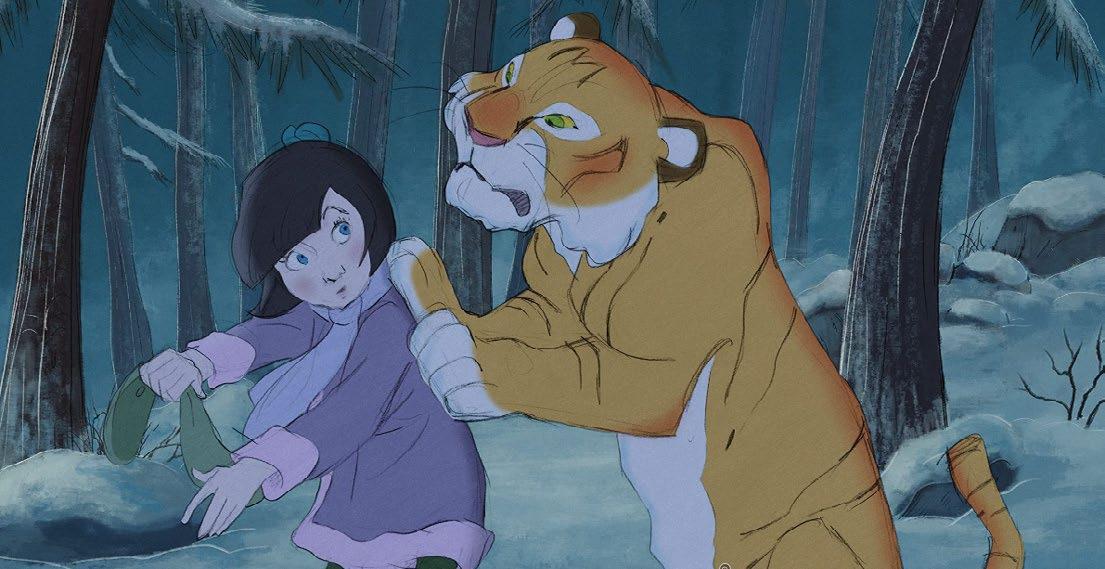
Now, Disney Legend and animation master Andreas Deja has drawn and directed his first animated short infused with those bonding themes in Mushka. Nearly a decade in development, Mushka arrives as a rare gem currently clawing at the film festival scene, brimming with a gentle purity absent from most mainstream animated features delivered in the digital age.
Mushka is set in the Soviet Union during the mid-1970s, and tells the heart-tugging tale of a Kyiv girl named Sarah who leaves her grandmother’s home to live with her estranged father in Siberia. While trying to adapt in this bleak environment, she rescues an orphaned tiger cub and raises him to maturity. As threatening forces try to hunt the big cat for profit, and she must finally return him to the forest.
Sketchbook Appeal
Deja is the award-winning talent behind numerous Disney blockbusters and was the
guiding hand behind characters like The Little Mermaid’s King Triton, Beauty and the Beast’s Gaston, Aladdin’s Jafar and The Lion King’s Scar. Here he returns to top form by using a rough, colored pencil sketchbook tone to Mushka’s drawings and colors that provide a throwback appeal.
To top off this personal project, Mushka also benefits from a melancholy theme song written by the great Richard Sherman, a sweeping musical score courtesy of Fabrizio Mancinelli and atmospheric background paintings from Natalie Franscioni-Karp.
Mushka premiered at the Stuttgart International Festival of Animated Film (ITFS) and also screened at Animayo in Spain’s Canary Islands in early May. That’s where we caught up with Deja. “The origin for the story came up about 10 years ago when I started thinking about a project that I could get my teeth into and would be fun to do,” he tells Animation Magazine.
“Then we started on production about eight years ago. I always liked stories with animal-human relationships. Maybe because I had some experience with big cats from The
Lion King, having done the research there. I thought I could translate that into a big tiger and introduce a girl and make it about the two of them.”
Placing the film in Russia’s Cold War period allowed for certain thematic choices that provide Mushka with a distinctive vintage quality. “I thought it might not be linked to a specific time,” says the director. “But because of the ending we had where Alex has gotten into the business of rescuing tigers, I wondered — when did the Soviet Union start realizing that they’re having a tiger problem and start trying to do something about it? As it turns out, it happened sometime around the mid-’70s. So, we started there because it makes the ending credible. At that time, Russia was finding out that big cats were disappearing.”
To flesh out the story beyond the simple concept, Dejas reached out to his friend Michael McKinney, a freelance author, painter, poet and storyteller. “He came up with a screenplay which really read like a novel,” Deja adds. “All of a sudden, I had a grandmother, there was a flashback in time and a father that the girl never knew.”
www.animationmagazine.net 62 jun|jul 23
SHORTS
Music was also a crucial component for Deja and Oscarwinning Disney songwriter Richard Sherman graciously came aboard with an original theme. “Richard asked me what I was doing these days and I told him the story of Mushka and where it was at that point,” he recalls. “He liked it and got inspired and said that maybe somebody at this lunch table could write some music for your film. He came up with this beautiful lullaby which plays twice in the film, once during a montage sequence then the full song over ending credits. He set the tone musically and gave us the emotional musical core.”
Composer Fabrizio Mancinelli took cues from Sherman and conceived the elegant score. “It’s a big score,” notes Deja. “It’s really emotional
In
SHORTS
DRAWN TO THE CAT

FAMILY: Andreas Deja used his experience animating big cats on The Lion King to create his new short, Mushka
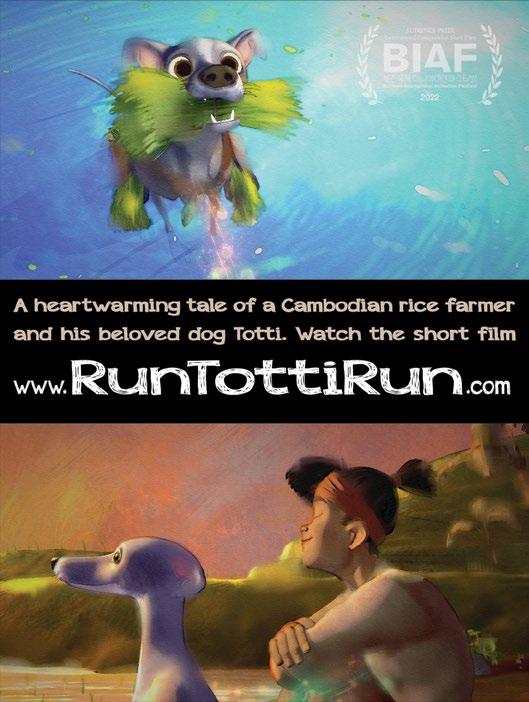

and we have a 60-piece orchestra that played. I think it’s some of his best work. I couldn’t be happier. We showed it to Richard late last year and he was thrilled with it. And that’s something to hold dear to your heart when the old maestro gives his stamp of approval.”
Mushka’s credits feature a dedication to Deja’s mentor Eric Larson, one of Disney’s Nine Old Men who worked on classics like Pinocchio, Fantasia, Bambi, Peter Pan and Sleeping Beauty. “He was basically the one who hired me to what was then called Walt Disney Productions. I got in touch with Eric as an art student from Germany. If Eric hadn’t seen the potential in what I had sent him, my career wouldn’t have existed. He thought that for an audience to believe in your characters you have to be sincere in your work and your animation. He was a big help — not just to myself, but to many of us learning under him.”◆
For more info, visit mushkathemovie.com.
• Paramount’s Teenage Mutant Ninja Turtles: Mutant Mayhem


Netflix’s new Miraculous: Ladybug and Cat

Noir, The Movie
• Director Anthony
Stacchi’s The Monkey King
• Warner Bros.’ Justice League: Warworld
• Hulu’s reincarnation of Futurama
• The Best of Comic-Con and SIGGRAPH ’23
jun|jul 23 63 www.animationmagazine.net
“If Eric [Larson] hadn’t seen the potential in what I had sent him, my career wouldn’t have existed. He thought that for an audience to believe in your characters you have to be sincere in your work and your animation.”
— Director Andreas Deja
the Next Issue of
Saying Goodbye to Papa
A young boy copes with his father’s passing in Janice Nadeau’s lovely short, Harvey.
 - By Ramin Zahed -
- By Ramin Zahed -
An imaginative boy comes to terms with the loss of a parent in Harvey, the beautifully animated NFB (National Film Board of Canada) and Folimage short directed by Janice Nadeau. The project, which is one of the eight titles selected for the Young Audiences Competition at Annecy, is based on the graphic novel by Hervé Bouchard and illustrated by the director herself.
“The story was so rich that I wanted to expand it into an animated film,” says Nadeau. “The image I often use to describe my relationship to Hervé’s original story is a house with many windows: whichever one I open, there’s always something to inspire me.
Nadeau worked in two techniques: traditional 2D hand-drawn animation, with the characters drawn in pencil on paper, augmented with charcoal and colored digitally in TVPaint, and paper cut-outs on a multiplane animation stand. She drew all the backgrounds on Arches paper, augmented with charcoal and colored in Photoshop.
A Different Third Act
The director points out that she wanted to stay true to what she felt about the main character’s story, rather than be completely faithful to the original work. “The book has an open and ultimately quite violent ending: the child disappears because his father can no longer see him,” she notes. “It’s a kind of symbolic death. Before I illustrated his book, I had asked Hervé Bouchard about the meaning of the ending. He replied, ‘It’s up to you to choose your interpretation.’ So I took that liberty, not with the book but with the film, and came up with an epilogue.”

Springtime in Quebec was another source of inspiration. “It’s not a green spring, with buds flowering and clothes that smell like sunshine after drying on the clothesline,” explains Nadeau. “It’s a gray spring, ‘because there is still snow on the ground and the trees are still naked,’ as Harvey’s dad explains. So I infused the film with that particular grain, with light dustings of charcoal, the sidewalks covered in
bits of gravel, the snow melting and forming streams in the gutters, and everything lit by this gray light. The colors are weathered and faded. The rooftops on the houses are topsyturvy, made of repeating geometric shapes and patterns, and I sometimes removed parts of their structure as a kind of graphical echo of the father’s absence.”
Another reference point was the film within the film: The Incredible Shrinking Man, and its protagonist Scott Carey, informed the aesthetic choice of black-and-white with cutout shapes, sponged with ink and surrounded by darkened halos.
The director says her own childhood also played a part in the creative process. “I remember that as a child, I had this feeling that adults lived in a space that was above mine, so I used that in the film, for example when Harvey imagines his dad driving his car in the sky, or when the lozenges fly off his sweater. I also looked through family photo albums and I chose the color palette for the film based on the somewhat faded colors of those photographs. And finally, for all the characters’ costumes, I was inspired by the pages of the mail-order catalogs that every Quebec family had when I was growing up.”
Nadeau says one of her favorite parts of the experience was working with her talented team. “In the first few years I was
pretty much alone in developing the project, until some people very carefully chosen by my two producers, Marc Bertrand and Corinne Destombes, came on board,” she notes. “They included lead animator Claude Cloutier in Montreal and Marc Robinet, who played a similar role in Valence.”
She also mentions that she actually loves the time that animation requires. “There is a whole set of activities to be performed (researching, sketching, writing, drawing, animating, flipping pages, coloring, etc.) and it all takes shape in a very-large-scale project that you then get to share with others, whether it’s your collaborators (for example, sound designer Olivier Calvert, our composer Martin Léon, editor Oana Suteu and Ryan Hill and Laurent Lemaire, our voice talents) or members of the audience at a screening.”
The filmmaker hopes Harvey will have a positive impact on the audience. “The message is that you should trust your own image of your loved one,” she explains. “Harvey’s dilemma is that after his dad is gone, everyone tells him what his dad was like, but when he puts all those descriptions together, they don’t make sense to him. So Harvey must listen to his own voice to keep a distinctive image of his father inside him.” ◆
For more info, visit nfb.ca/film/Harvey_eng.
www.animationmagazine.net 64 jun|jul 23
SHORTS
Janice Nadeau
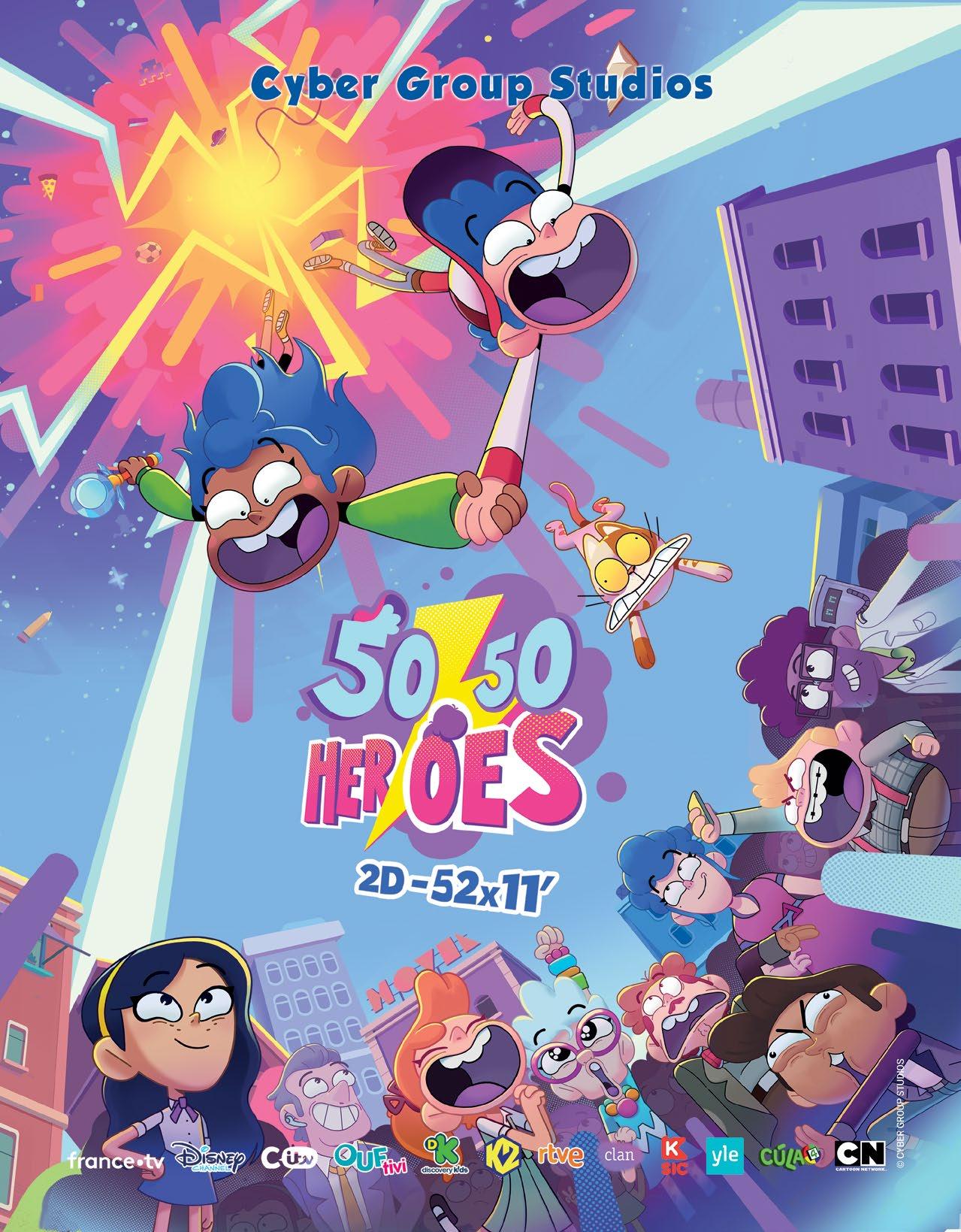
Mainframe at 30
Canada’s pioneering CG animation studio is ready for the future with a healthy slate of innovative shows for young viewers.

If you are a fan of CG animation, you probably know that ReBoot was one of the first CG-animated TV series ever made. The show ran from 1994 to 2001 and was produced by the Vancouver-based studio Mainframe Entertainment, which was founded 30 years ago by Christopher Brough, Ian Pearson, Phil Mitchell, Gavin Blair and John Grace. Mainframe quickly established itself as a leading producer of CG-animated content. Another big milestone was the production of Spider-Man: The New Animated Series for MTV, the first large-scale, toon-shaded CG series.
Through the years, the studio grew and evolved, was sold to Rainmaker, changed its name to Rainmaker Animation in 2007 and produced its first theatrical feature, Escape from Planet Earth, in 2013. In 2020, the studio, which is now owned by WOW! Unlimited Media, reverted to its old name and became Mainframe Studios.
Over the past few years, Mainframe has been co-producing a wide-range of animated series such as Madagascar: A Little Wild and Team Zenko Go (DreamWorks Animation TV), The Guava Juice Show (Studio71/YouTube), Barbie: Big City, Big Dreams and Barbie: It Takes Two (Mattel TV/Netflix). As Mainframe celebrates its 30th anniversary this year, we thought it would be a great time to catch up with its president and CCO Michael Hefferon to learn more about the studio’s plans for 2023 and beyond:

Animation Magazine: First of all, congratulations on the big anniversary of Mainframe. Can you tell us a bit about your history with the studio?
Michael Hefferon: I’ve been with the studio for over 10 years now. As you know, the bulk of the studio is in Vancouver. We also branched out in Ontario and Toronto about two years ago, and we have had a strong team out in Nova Scotia as well. We have our global studio pipeline partnership with Infinite Frameworks in Singapore and Indonesia. When I
started with the company, it was still Rainmaker. Back then, we weren’t doing TV animation. We changed that in 2013 when we made Bob the Builder with HIT. Fast forward to 2022, and we’ve had over 16 projects in production, with a studio of over 750 people, and all of it has been TV animation. So, this decade been a tremendous growth period for us.
What are some of the big priorities for the studio right now?
Game engine is a big focus for us. Coming out
of the pandemic and having a 13-year-old son, I have seen how online platforms became an aspect of social connectivity for kids. In fact, Greg Little, who is our SVP of Content in Los Angeles, his son and my son became online friends. They have never meet in person, but they spend the day together interacting in gaming. We see the power of that connectivity. We recently announced our partnership with Nick Eh 30 for the new series Endurathon, which is produced in Unreal Engine 5. We’re looking at how we take someone like Nick Eh
30, who is one of the top Fortnite celebrities and is tremendously approachable and is admired by kids, and bring him to linear storytelling.
Certainly, the growth in our partnerships that we’ve had: We’ve been working with Mattel for 23 years: We’ve done 60-plus projects together over the years. We announced our partnership with Spin Master, we’re producing Unicorn Academy for Netflix, along with our partnership with Silvergate — now Sony Kids — on all the Octonauts content, most recently on Octonauts: Above & Beyond Those are all exciting for us! At the end of the day, it’s about producing great content that resonates with kid audiences. I’d like to think that we were able to put a lot of more smiles on kids’ faces during a tough period that everyone was going through during the pandemic.
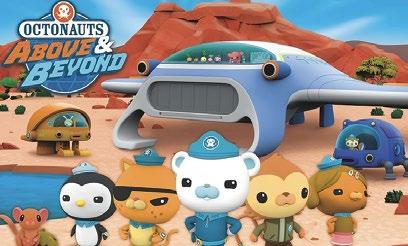
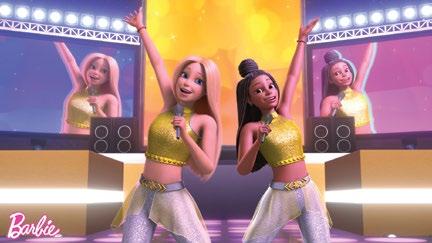
How would you define a perfect Mainframe project?
You know, I think sometimes it’s what we like versus what we think our buyers and partners are going to like. One strength Mainframe has had over all the years is that we’re agnostic to having a style. Our diversity in the type of content and the different looks they have is what makes us interesting to our partners. For example, Guava Juice is our first 2D animated series where we utilize technology as a brush tool that an artist would use to create something. We have the younger preschool space (three
to five, as well as a four to seven bridge preschool), which is led by Tanya Green. Certainly, kids are watching older these days — what used to be a show for three-year olds is now watched by younger kids. Greg Little is our senior VP of content, and he looks for shows targeting eight-year olds and up. We’re always looking for strong comedies. As you know, funny is money. Beyond that, we’re always looking to partner more with great creative talents to help realize their vision. We’re not a committee when we develop, and we really look for a strong creative point of view. We really look to support in executing that vision for that show.
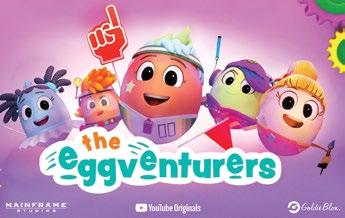
Can you tell us about some of the new shows we can expect to see from the studio in the near future?
The newest one that’s coming is Unicorn Academy (Spin Master and Netflix, based on the book series by Julie Sykes). We will have more Barbie content coming out, and we have a number of shows with YouTube Kids. We’re producing Coyote & The WildAways with Coyote Peterson (whose Brave Wilderness YouTube channel has over 20 million subscribers). We’re also in partnership with GoldieBlox for YouTube as well, for a phenomenal property called The EggVenturers, which has tremendous viewer engagement.
Since Mainframe was one of the pioneers in CG technology in TV animation, what is your take on the growth of AI and its impact on the industry?

Of course it’s a controversial topic, but I think AI can be a great tool to assist animators. When we did ReBoot: The Guardian Code (live-action/CG hybrid) back in 2017, all the little Binome characters that you would see in some of the shots were all created by AI. They moved independently. We hero animated some of them. Back then, we used it just as a tool. It continues to be a great tool to assist in these types of shows. We do not see AI as replacing talent. We see it as another way to enhance our shows and be a tool set to assist our talent.

What would you say is the secret to running a successful animation studio?

I like to say that our company is a start-up with a track record. We continue to look at things in a fresh way, evolve and pivot when we need to pivot, and not get caught in legacy. It’s like when you come out of school, and you have this bright-eyed approach and believe that anything is possible. Just because we did something a certain way on a particular show doesn’t mean that’s the way we need to do it on the next one. Another key thing for us is that we’re talent focused. Our hardware and software help us achieve our successes, but it’s the talent —the people — who help us create and produce the shows. We always put talent as a premium. Mainframe is about our people, and that’s what we like to celebrate and what excites us about the future. ◆

For more info, visit www.mainframe.ca.
 Michael Hefferon
Michael Hefferon
A Silver Anniversary for Northern Stars
Ottawa-based studio Mercury Filmworks celebrates 25 years of beautifully crafted animated shows.

It’s been 25 years since veteran animation producer Clint Eland founded the acclaimed studio Mercury Filmworks in Canada. The studio, which was born during the early days of TV’s digital ink and paint revolution, has become one of the leading forces in the industry. The Ottawa-based company was the first studio to use Harmony software to produce an animated series in house (Mischief City) back in 2005, and it also was the first studio outside of the Disney family ever to animate Mickey Mouse. In recent years, it collaborated with Netflix to produce Craig McCracken’s acclaimed show Kid Cosmic, and was the first studio to produce an animated series for Amazon (If You Give a Mouse a Cookie). The studio was also the driving force behind the popular, Emmy-winning Netflix series Hilda (2018-2020).
On the occasion of the studio’s big birthday, we caught up with the studio’s Chief Content Officer Heath Kenny to find out more about Mercury Filmworks’ up and coming slate and plan for Annecy.

Animation Magazine: Big congrats are in order on your studio’s silver anniversary! What are your thoughts on this big benchmark?
Heath Kenny: We are celebrating 25 years since Clint established Mercury Filmworks with ‘a scribble, and a simple ambition: to become the best digital animation studio in the world!’ It is incredible what he, along with a team of passionate creative individuals, has accomplished over the past quarter of a century. The work done by our Ottawa-based company and our local community of artists has been a beacon to artists all over the world. When working in London
or Paris I, myself, would see a show from Mercury Filmworks and say to our teams, let’s aim for something like Wander Over Yonder or Jimmy Two-Shoes or the Mickey shorts. To be part of this team and looking ahead to the next 15 years is a truly a dream come true.
What’s on your slate at Annecy this year?
We’ll be focused on showcasing three original children’s series this year at Annecy:
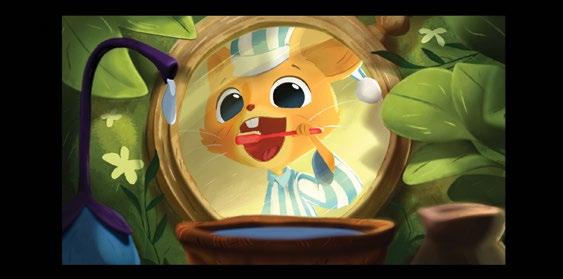
• Octicorn (52 x 11’): We recently partnered with French Canadian animation house Stim Studio to co-produce this animated preschool series

 Heath Kenny
Octicorn
A Mouse Called Julian
Tales of the Underwear Dragon
Heath Kenny
Octicorn
A Mouse Called Julian
Tales of the Underwear Dragon
based on an Amazon Book of the Year Hello, My Name Is Octicorn from debut authors Justin Lowe and Kevin Diller. Octicorn is on a journey to figure out all the feelings he has and what to do when they don’t feel so good. This CG-animated series is for anyone who has ever felt a little different.

• Tales of the Underwear Dragon: This show is based on Scott Rothman’s popular children’s picture book Attack of the Underwear Dragon illustrated by New York Times best-selling illustrator and Annie Award-nominated animator, Pete Oswald. Medieval stories about valiant knights and dastardly dragons are infused with a fresh new spin in this 2D-animated comedy series (52 x 11’) for kids ages six to 11. Every episode will feature an original song, written by Tony, Emmy and Grammy Award-winning composer, producer, arranger and orchestrator Bill Sherman (Sesame Street, In the Heights, Hamilton).
• A Mouse Called Julian is based on Joe ToddStanton’s eponymous award-winning children’s book, which brings a unique, modern illustration style to an inversion of the classic Aesop Fable of The Lion and the Mouse. Our mouse learns that sometimes, having a friend over for dinner can be just the right amount of variety in your day.
Annecy is an industry event that holds a special place in my heart. It is unique in the way it combines creative energy and business opportunities in a beautiful and inspirational setting. So much creative international talent congregates annually to share and premiere their latest projects and the process they went through to make them a reality. We are excited to see what our peers have been cooking up and to introduce these three projects, all based on acclaimed children’s literary works, to our community.
What do you think makes the studio unique in the competitive animation landscape?

Our team has always sought to take something and push it beyond what is expected. Our peo-
ple genuinely care about the characters and shows we get to work on. That’s what sets the great studios apart — the willingness to go that step further and the desire to keep innovating. We’re constantly reinventing ourselves to remain ahead of the curve so that we can deliver more than what others think possible, and we have earned the reputation of being a very collaborative studio that strives to bring the vision of the creators we work with to life, while all the while protecting our partners from collaboration chaos. It was absolutely essential to Clint and our entire leadership team that we create a team and environment that is diversified and dynamic, and that we foster the growth of our community of creators, dreamers and unconventional thinkers.
Can you tell us what other new projects you’re currently working on?
Mercury is also in development on two new originals created by in-house talent: BloopyMerps (8 x 11’), a sci-fi adventure comedy series for kids created by three longtime Mercury Filmworks employees, Shane Plante, Ross Love and David Laliberte; and Pangors of Puddle Peak (52 x 11’) [created by Heath Kenny himself]. BloopyMerps follows a rules-loving robot and a soft-hearted alien on a mission to terraform, a lifeless planet that’s not as lifeless as they thought. Pangors of Puddle Peak features eight-year-old best friends who discover fantastical creatures
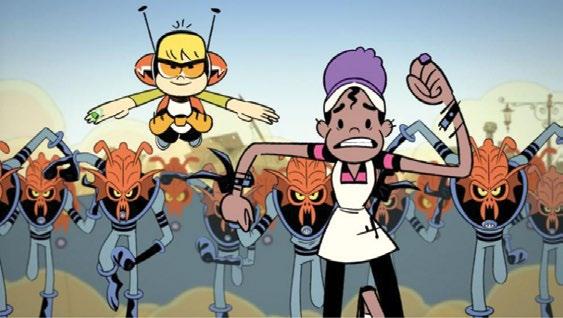

hidden in plain sight. Additionally, set in 1830s Europe, Once Our Land (90 mins.) is a fantasy/ sci-fi animated family feature based on the graphic novel by Peter Ricq. It tells the story of Fritz and Ingrid, who embark on a journey to rid the city they love of cruel beasts and learn to trust those around them again.
How would you describe the studio culture at Mercury Filmworks?
Inclusivity and a commitment to fostering the creativity of our talent in-house is hugely important to Mercury Filmworks. We celebrate our team’s diversity in a variety of ways, including internal events like ‘Lunch & Learns’ that explore, discuss and celebrate the places we come from and the things we believe in. Given our massive pool of diversified talent, we also often look internally for the next big idea, which is how one of our original projects BloopyMerps came to be.
What are your plans for the near future?
We will continue our 25th anniversary celebration through this year and continue to build our development and production pipeline with original new series. It has definitely been a challenging few years in the industry that supports each other and firmly believes that high-quality projects with compelling storylines and characters will always find a home and audience. We will continue to evolve and explore how we can utilize new technologies, just as Clint did 25 years ago, to further enhance our creative freedom. Technology is a tool, and we are more than the tools we use. We truly are living in the Golden Age of Animation and couldn’t be more excited to see what the future holds. ◆
For more info, visit mercuryfilmworks.com.
Hilda
Kid Cosmic
Mickey Mouse
A Bright Light in the Animation Landscape


Magic Light Pictures founders Michael Rose and Martin Pope discuss the 20th anniversary of their acclaimed production company.
Connoisseurs of quality, meticulously crafted animation are familiar with the wonderful, award-wining specials produced by U.K.-based Magic Light Pictures. Beginning with The Gruffalo in 2009, the boutique production company has been delivering top-quality animated productions for the small screen with astonishing frequency.
Chico and Rita (2010), The Gruffalo’s Child (2011), Room on the Broom (2012), Stick Man (2015), Revolting Rhymes (2016), The Highway Rat (2017), Zog (2018), The Snail and the Whale (2019), Superworm (2021), Pip and Posy (2021) and The Smeds and the Smoos (2022) are among Magic Light’s charming projects. We had the chance to chat with the company’s talented founders and managing directors Martin Pope and Michael Rose about the work of their Oscar-nominated and BAFTA-winning company:
Animation Magazine: Can you tell us about the history of Magic Light Pictures?
Martin: Michael and I became friends in the early 1990s when I was producing my first feature film and Michael was a program buyer at Channel 4.


While I continued running my own business making feature films and TV dramas, including the BIFA and Evening Standard award-winning Lawless Heart and the Sundance hit Touch of Pink, Michael joined Aardman in Bristol as Head of Development before becoming joint producer of the third Wallace & Gromit short film, A Close Shave, and setting up Aardman’s feature film arm, executive producing Chicken Run and Wallace & Gromit: Curse of the Were-Rabbit
In 2002, Michael moved back to London and saw my film The Heart of Me at the Closing Gala of the London Film Festival. We got back together over coffee, and realized the possibilities of working together.
Michael: We talked a lot about what we wanted to do. We realized that we had very different skill-sets and experiences, but by joining forces we could build something really special. We were sufficiently different that we’d complement each other. And we shared the belief that what matters is not the technique you use, whether animation, live action or any kind of hybrid, but the stories you tell and the passion they’re told with.
Martin: I think we were standing on Wardour Street
when we came up with three ideas which formed the bedrock of our business plan: make live-action films first, develop animation and if we could find the right property, build that into a lasting brand. So even at the beginning and even though we didn’t know our exact next steps (or even sometimes where the rent was coming from) we already had the idea of a trajectory and where we wanted to go.”
Take us through the process of finding The Gruffalo and securing the rights for it please. Michael: Night after night, at home I was reading The Gruffalo to my daughter, and it was brilliant. Martin was feeling it as well. Martin: I remember when Michael first came in and said, have you been reading this? We’d both been reading it to our children, and we were
Martin Pope
Michael Rose
The Snail and the Whale
able to think about how absolutely loved it was.
Michael: We were sure it was the ‘one’ and that we could create a classic special. We also felt that the story and character had sufficient richness and depth to launch a wider brand, but inevitably it took a long time to get the rights — four years in all from 2003 to 2007. The Gruffalo was already a huge publishing success and we had to convince Julia Donaldson, Axel Scheffler and publisher Macmillan that we were the best partners to bring it to screen.”




Martin: Many companies wanted it, some as a series, others as a feature film, but we wanted to stay true to the book and determined that it was perfect as a half-hour Christmas special. There are various moments where I can remember Michael saying confidently, “We’re going to produce it for BBC One on Christmas Day,” and my heart was pounding, thinking, how on Earth are we going to pull that off? Happily, from my time working at the BBC we managed to find the right way to reach that vital Christmas Day slot.
Looking back, what might you have done differently?
Michael: I often wonder if there were opportunities when we could have gone a bit faster, whether it’s in developing a project or a series. But we’ve always been focused on doing the right thing and staying true to our values. We
want The Gruffalo to be seen in half a century’s time as a classic brand, like Beatrix Potter or Paddington. So, everything we’ve done has always been with the long-term interests in mind. The Gruffalo occupies such a special pace in the hearts and minds of our young audience; if we are sometimes cautious, it’s because we needed to get it right.
Martin: Maybe sometimes we were a bit cautious. Maybe we could have managed the risks and the worry about those risks differently. But actually it all paid off — as we’re still here, celebrating our 20th anniversary and growing the company with a wonderful team and hopefully still delighting our audiences.
What is the best advice you can offer for people starting out in animation?
Michael: Think about the audience. If you want to make something, who are you making it for? Who’s going to watch it and where are they going to be watching? It can be something commercial, it can be something avant-garde, but you have to set off knowing your audience.
Martin: Yes, and it’s such a long process and so complicated, you have to think about why you’re doing it. What is the thing that gets you up every morning? Will making this animation reach the people you want and make them feel and understand what you’re expressing?

When you look back on the past 20 years, what are you most proud of?
Michael: I’m proud that we’ve built a business that is known for wonderful films, which have an incredibly high quality threshold. Some of them are enduring classics, viewed again and again, which deliver an incredible pleasure to our family audiences. But above all, I’m proud that we’ve built a company with wonderful values underpinned by integrity and quality and desire to delight audiences. I feel those values cascade through our work and through all the people who work with Magic Light.
Martin: I’m very proud of our team. I think there are people here who are doing great work. Also, of course it makes me proud when we get comments from parents who are happily amazed their kids have watched one of our films every day for two months, or where a film has really helped and connected with a child. It’s just amazing to be making things which families really embrace. Even just this weekend I was looking at my local cinema, thinking, what shall I go and see? And there is The Gruffalo and Zog playing as a double-bill in my local cinema, every day of the weekend. How great is that? ◆
For more info, visit magiclightpictures.com.
The Gruffalo Pip and Posy
Zog
The Smeds and the Smoos
Mexican animation is getting a nice shoutout this year at Annecy Festival as the country of honor, and this well-deserved spotlight is happening at the right time in history. In the past 10 years alone, Mexico has produced the same number of animated feature films and TV shows as the total of all the previous 50 years put together. Today, Mexico experiences a healthy combination of original intellectual property, work-for-hire studios, schools and festivals that foster collaboration.
“The goal of the Mexican delegation at Annecy is to display the artistry and capabilities of the Mexican animation industry, to find new co-production partners for the studios and showcase our heritage,” says Jordi Iñesta, co-founder of Guadalajara-based Latin American animation festival Pixelatl.
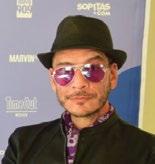
Among the many examples of the past decade’s exponential growth are studios such as Mighty Animation, which started out as a small venture between six friends and currently employs over 400 artists across multiple projects. Before 2014, only one Mexican short, Hasta los huesos (Down to the Bone) directed by René Castillo, was part of the official selection at Annecy Festival. Since then, dozens of films and projects are featured at the event each year.
Trailblazing Collaborations
This year’s Annecy Festival includes a spotlight on Aztec Batman: Clash of Empires, an original animated feature-length film that places the DC superhero against the backdrop of the history of Mexico and immerses fans around the world in the exciting culture of

¡Viva México!

Innovative animated projects that reflect the culture and heritage of Mexico put the country’s talented artists and studios in the spotlight.
- By Christian Bermejo -
Mesoamerica. The much-anticipated project is produced entirely in Mexico by Warner Bros. Animation, Ánima and Chatrone, and features top local talent that showcases the region’s abundant art.
“As a Batman fan, the idea captivated me from the first time I heard the words ‘Aztec Batman,’” recalls the film’s director Juan Meza-Leon. “It’s a radical and totally original concept. It blends fiction and history in a unique manner that elevates Latin American animation to new heights, and it’s all beautifully crafted with the talent of Mexican artists.”
In addition to Aztec Batman, Annecy is featuring panels and screenings showcasing Mexico’s history and most promising programs, as well as the pitching of projects in development. They’ll also be hosting the largest delegation ever to land at the festival, with an estimated number of 300 delegates including studio heads, artists and students.
A Look Back at History
The history of Mexican animation is rich and complex. The landscape of the past century had been mostly self-taught and artisanal. Up until the late 1990s, there were no college degrees specializing in animation. A few lucky artists got into international programs including the prestigious CalArts or Gobelins, and some of them would come back to Mexico to establish their courses or studios.
Small studios emerged through shorts from artists that came from a fine arts and graphic design background, or computer engineers. On the commercial side, thanks to proximity to the U.S., Mexico has always been an international hub for television networks and related services: voice acting, co-production, PR and marketing offices for Latin America. This phenomenon allowed for the birth of the first major work-for-hire studios.
Feature films were produced through public
www.animationmagazine.net 72 jun|jul 23 TERRITORY FOCUS
“As a Batman fan, the idea captivated me from the first time I heard these word ‘Aztec Batman.’ It’s a radical and totally original concept. It blends fiction and history in a unique manner that elevates Latin American animation to new heights, and it’s all beautifully crafted with the talent of Mexican artists.”
- Aztec Batman director Juan Meza-Leon
Aztec Batman: Clash of Empires
funding. Government programs allowed studios to subsidize animation short film production, script development and post-production through software development initiatives or the Mexican Film Institute. Aspiring directors would have to wait in line, year after year, in the hope of winning the grants or working outside of the industry and using their income for their films. Great projects came and went, as most efforts were disconnected from each other. Every time the industry was on pace to become a solidified structure, the lack of consistent funding, studio bankruptcy and “brain drain” phases would make all efforts almost vanish overnight. This left a wave of artists who had to start from scratch — repeatedly.
The Economy of Generosity
Although Mexico is one of the major markets in the entertainment industry (highest box office in LatAm and competing with Brazil as the largest video game market) back in 2010 there was no original intellectual property on Mexican screens. A couple of notable exceptions include Ánima Studio’s El Chavo



and the popular Huevocartoon movies. When foreign co-producers started looking for suitable partners, they noticed that the talent was there, but not the production capacity.
Mexico aspired to be a land of creators and original ideas, but the industry quickly learned that to reach that goal the production itself had to be up to international standards. They realized that no studio alone was going to be able to compete or get to work on their own IP with a major network when an opportunity came up.
There are a few key factors that explain the growth of Mexican animation. One is a strong sense of community. Studio heads started reaching out to each other rather than seeing each other as competition and opting to learn from each other and align pipelines. This kept everyone competitive on an international level and allowed studios to hire each other to take on more ambitious contracts.

“Pixelatl might be best known as a festival, but our purpose has been to bring the community together through events,” says José Iñesta, director of Pixelatl, the Mexican association founded in 2011 to promote the creation and distribution of animation, games and comic books in the region. “There are now 11 originals in production from Pixelatl alumni, 26 comic books published, 450 jobs connected and over 50 service contracts created at our networking
events. We are trying to prove, beyond a doubt, that animation is a medium that our community loves and that we want to see ourselves represented on the screen.”
According to Pixelatl, there are currently 11 features in production, seven in pre-production, three series in production and nine in development in Mexico. Studios such as Boxel, Demente Animation, Mighty, Cinema Fantasma, Aska Animation, Exodo, Anima, Huevocartoon, Fotosíntesis Media, Don Porfirio, Casiopea, Llamarada Animation, Mr. Machin, Gasolina Studios, Viva Calavera!, Banzai, Metacube, AI Animation Studios and Brinca Taller are all creating innovative and original work in conjunction with international partners.
An Era of Auteurs and Opportunities
One of the examples of this new wave of Mexican animation is Cinema Fantasma from Mexico City, founded by Arturo and Roy Ambriz. They started working on their first stop-motion short while in college, setting up a couple of cameras in their childhood home staffed by schoolmates and family. They gained popularity through the years and got to make short format collaborations for popular shows like Rick and Morty and Victor and Valentino. This year, they have eight animation units and have employed over 60 stop-motion specialists, as they are producing the feature film Frankelda’s Book of Spooks for Max. They have also begun production on their second movie and are working on an unannounced series for Hollywood.
“Animation in Mexico is at a decisive point,” say the Ambriz brothers. “As the new generation, we are ready to prove that our creativity
jun|jul 23 73 www.animationmagazine.net TERRITORY FOCUS
“Collective work and strategic production is the key for the Mexican animation industry, which has very limited budgets to work with. Our first feature film was possible because of the optimization of resources and pipelines of four different studios.”
- Ana Cruz, producer/co-founder, Casiopea Studio
Frankelda’s Book of Spooks
Home Is Somewhere Else
and expertise are going to make Mexico to be known as a creative and professional powerhouse. Cinema Fantasma is currently the stop-motion studio with the most hours produced in this technique from the country. Despite the obstacles ahead, we feel happy and proud about what we are achieving.”

Last year, Guadalajara’s El Taller del Chucho played an important role in the production of Guillermo del Toro’s Pinocchio for Netflix. “I thought it was really important for their artistry to be seen in a movie of this caliber,” del Toro told Variety last year. “We needed to segment a section [in the film’s production] that was important to be contained. So, we did the limbo chamber and the funeral procession of the black rabbits [at the Taller]. They created the puppets, the sets, they art-directed and did the cinematography. I also had them animate the puppets Pinocchio and Cricket in one of the longest animation sequences in the entire movie — if not the longest.”
Another studio in the wave of Mexican animation is Casiopea, a female-owned animation studio in Mexico City and co-founded by Ana Cruz, who started as an intern at Diez y Media studio and learned about the artistry and craft of animation working on short films. In 2022, Casiopea was one of four studios that worked on the production of the animated feature film Home Is Somewhere Else, an Annecy official selection that is an artistic and heartfelt film about migration, directed by Jorge Villalobos and Carlos Hagerman.
“Collective work and strategic production are the key for the Mexican animation industry, which has very limited budgets to work with,” says Cruz. “Our first feature film was possible because of the optimization of resources and pipelines of four different studios.”
Warner Bros. Discovery Latin America has been a main driving force for original ideas in the region. In 2014, Pablo Zuccarino, current General Manager of Kids, and Hernán La Greca, former Senior Director of Original Productions for Latin America, attended Pixelatl Festival and were surprised by the talent pool and met the future creators for their platforms.
Inventive Approaches
In recent years, a series of initiatives, pilots and short-format experiments with limited budgets also gained popularity on social media. A popular example is Toontorial, which averages between 1 and 12 million hits per episode on YouTube. Upcoming shows include Villainous and the new Rey Mysterio series which are set to debut on Cartoon Network soon.



As the acclaimed animator, director, writer and creator Jorge R. Gutierrez, the award-winning director of The Book of Life and Maya and the Three, points out, “Mexican animation is always special to me because animation as an art form can do so much with so little. Mexican animation can really showcase the monumental vision and epic ambitions of the brilliant artists and storytellers of our beloved country.”
As Mighty Animation’s director Luispa Salmón, whose studio produced the Annecy spotlight short Kikiriki, notes, “It’s a challenging time for the global industry as our relationship with content continues to evolve, and production companies are embracing new approaches to content creation. We are witnessing a period of mergers, the rise of artificial intelligence, and even a recent writers’ strike, which calls for a reevaluation of the rules of the game. However, despite these challenges, it also marks a new cycle filled with opportunities, particularly for emerging and dynamic industries like Mexico’s.”
The dream to make it big is alive. What the Mexican studios have learned over the years is that the key to success is embracing their unique Mexican identity. The Mexican way is artistic, inventive and collaborative. The future is full of challenges and as the industry matures new issues will have to be addressed. But now more than ever, you can believe in Mexico and their commitment to animation and the creative industries. ◆
You can follow the Mexican animation presence at Annecy with the social media hashtag #MexicoEnAnnecy.
Christian Bermejo is the program manager at Pixelatl and part of the team of curators for the Mexican animation film retrospective at Annecy. He is a producer, writer and self-described animation, comic-book and video-game industry nerd.
www.animationmagazine.net 74 jun|jul 23 TERRITORY FOCUS
“Animation in Mexico is at a decisive point. As the new generation, we are ready to prove that our creativity and expertise are going to make Mexico to be known as a creative and professional powerhouse in the near future.
- Arturo & Roy Ambriz, founders, Cinema Fantasma
Cartoon Network’s Rey Mysterio series
Ithrax Studio’s 2023 movie Uma & Haggen

The Belgian Touch
Movies such as The Inseparables and Sirocco and the Kingdom of the Winds are the latest examples of Belgium’s rich animation output.


 - By Kévin Giraud -
- By Kévin Giraud -
With a dashing line-up for this year’s Annecy Festival, Belgium remains one of the key players in European animation. Boasting three feature films in the official competition produced or co-produced by Belgian studios, including this year’s opener Sirocco and the Kingdom of the Winds and no less than a dozen short films, one must wonder: Is it just beer, waffles and a tax rebate that lure foreign studios and skilled animators into this tiny country? Or is there truly a “Belgian touch” in contemporary animation?
Delving into the rich history of Belgian animation, dating back to the 1960s, one can already see the main trends that still drive today’s productions. Strong characters, welltrained animators and innovative studios are the foundation of what is now a very active and diversified ecosystem that’s fueled by in-

stitutional funding and international investments. According to local press, animation constitutes more than 20 percent of Belgium’s whole cinema industry and each year, Belgian animation schools such as KASK, La Cambre, LUCA, RITCS or HEAJ deliver their loads of 2D or 3D animators with a wide range of content and skill. You can catch a glimpse of their talents in Annecy’s student competition, with no less than four Belgian shorts selected, before they head out to new challenges in the prosperous Belgian animation industry.
To the Moon and Back
Matthieu Zeller, CEO of nWave Studios, relies heavily on those attractive talents to secure the unique success story that has been nWave for almost 30 years. From a tech-driven company focused on 4D and IMAX films, nWave has evolved into one of the biggest animation studios in Brussels. While keeping its
one-of-a-kind model, they employ more than 100 people from 40 different nationalities, in the areas of feature film production, co-productions and corporate animation.
“It has been the same since Fly Me to the Moon, when nWave’s founders decided to fund their own production and remain totally independent from outside investors,” says Zeller. “And today, despite this adventurous if not outright mad decision, it’s the same state of mind that drives nWave and our recent films. We do most of our animation in-house, have our own render farm, do our own sales, and our films become available to international buyers late in the production process.”
He adds, “It’s a really distinct approach, but that puts us in a spot where we can produce, sell and manage our own films without any outside ties. It allows us to freely choose our schedules, polish pipelines and create specific and efficient ways of working to reach the top
www.animationmagazine.net 76 jun|jul 23 TERRITORY FOCUS
The Siren
Yuku and the Flower of the Himalayas
The Smurfs Nele De Wilde
of our game. We now aim to produce one feature film each year, while combining high-level 3D/2D animation and low production costs, and reaching out to new territories for talents and audiences.”
From its Brussels’ headquarter, nWave has expanded to two different sites in the north of France and the Wallonia Region, creating a geographic triangle of large-scale independent production. Schedules are already packed for the years to come, with follow-up films and new stories.
After successes such as The Son of Bigfoot or Chickenhare, and with this years’ selection of The Inseparables at Annecy, the studio keeps getting more and more international recognition while retaining its core values: In-house production, friendship and family-driven narratives aimed at ages seven to 77, and created by a majority of Belgian-trained talents. “Our characters may be different, but our goal remains the same: We create stories with inspiring messages for both children and adults — where adventure, comedy and heart match to provide the most thrilling experience.”

Classic Characters
Strong characters have driven The Smurfs
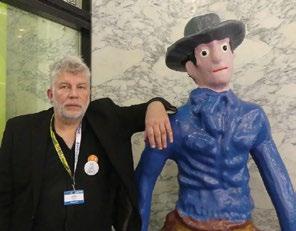
brand and its family-owned company IMPS for the last 65 years. Continuing the heritage of the beloved comicbook series by Belgian author Peyo and well-known TV show first produced in Belgium, The Smurfs came back in full force in 2021 with a brand-new TV series, co-produced by French studio Ellipse Animation and Belgium’s young but flourishing Peyo Productions.
“
Keeping such an IP alive all these years was possible essentially thanks to the intelligence of the Peyo family who, from the very first years of exploitation of the classic Hanna-Barbera series, thought of a diversification of the activities linked to the Smurfs,” says Nele De Wilde, executive producer, and François Deglain, producer. “Thanks to an international network of agents, publishing still remains at the historical department of the IMPS company (which is in charge of the brand’s licensing rights) where annual publications, merchandising and marketing ensure the majority of the activities today. Audiovisual distribution holds a powerful position in that scope, as it has continued to sell the classic series all over the world.”
“It’s this global approach that, in 2018, led to the creation of Peyo Productions, a compa-
ny dedicated to the production of audiovisual content,” adds De Wilde. “The rights holders now maintain creative control over the brand, which is a major change compared to our previous way of working, selling rights to external partners.” Peyo Productions can thus ensure the quality of the new animated series in its own production environment with top-rated partners, creating one of the top European animated series.
Memorable characters created by dedicated artists were also what put Panique! Productions on the map in the early 2000s. With the international success of A Town Called Panic, stop-motion artists Vincent Patar and Stéphane Aubier brought this production company to new heights, with the help of their producer Vincent Tavier. Today, producers Tavier and Hugo Deghilage carry on this vision and expand the scope of Panique! to other animated and live-action features, while still producing Patar and Aubier’s crazy duos Pic Pic & André and Cowboy & Indian in comedy-packed TV specials. “We choose our films with a real desire to get off the beaten track and want to continue to stir up the small and large screens with exciting and eccentric projects in an increasingly formatted world,” says
jun|jul 23 77 www.animationmagazine.net TERRITORY FOCUS
“nWave’s founders decided to fund their own production and remain totally independent from outside investors. We do most of our animation in house. We have our own render farm. We do our own sales, and our films become available to international buyers late in the production process.”
- Matthieu Zeller, CEO, nWave Studios
“We choose our films with a real desire to get off the beaten track and want to continue to stir up the small and large screens with exciting and eccentric projects in an increasingly formatted world,”
-
Vincent
Tavier and Hugo Deghilage, Panique!
Deghilage. “Panique! has been co-producing animation with several other studios for a long time now, and we have created working families and strong ties with partners such as French companies Autour de Minuit, Folivari and Silex Films.”
Fueled by Institutional Support
It’s no secret that Belgian animation, and Belgian cinema in general, is also flourishing because of the major support from institutions. With its complex and intricate political system, Belgium can be both a nightmare and a heaven for producers who can get support from at least three different film funds: Wallimage, Screen Brussels and VAF — each linked to a specific Belgian region. In addition, Belgium offers large tax incentives for companies willing to associate with Belgian producers, technicians or studios. This incentive contributes to a large co-production ecosystem which powers a big part of the industry, animation included. Sepideh Farsi’s La Sirène (The Siren) is one of the latest examples of these European projects benefiting from this state backing. A situation that, in return, helps Belgian talents rise to new heights and international recogni-
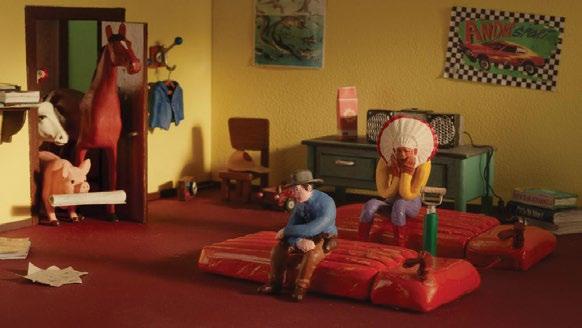
tion. Stop-motion artists Christine Polis, Emma De Swaef, Kim Keukeleire and Marijke Van Kets are now well-known figures, collaborating with Wes Anderson, animating or adding their contributions to Netflix’s The House or to Foliascope’s long-awaited The Inventor, also presented this year at Annecy.
CG animation studios such as Dreamwall or Belvision produce international content on a daily basis, while young directors and independent ateliers like Zorobabel, Graphoui or Camera-etc conquer the festivals with stunning and heartfelt short films, pushing the envelope towards more diversity and new experiences. It’s that approach that led Steven De Beul’s studio, Beast Animation, to work on the intriguing Coppelia, a live-action/ animated feature co-produced in the Netherlands, mixing ballet and animation into brandnew esthetics while continuing to welcome young stop-motion artists on new projects.
United We Stand
All together, these animation players create a vivid and thriving landscape of schools, independent studios and big production companies, where directors can express themselves in various ways through different formats, from TV to


cinemas and back again. You might not see the link between all these wonderful films presented at Annecy’s 2023 edition, but each and every one of them holds that special Belgian Touch — from innovative graffiti-animated student film Passagers by Celia Hardy to the wondrous landscapes of Benoît Chieux’s Sirocco, coproduced by Belgian company Take Five.
If you look closely, you might even spot the iconic Belgian waffle in The Inseparables, or the surrealistic touch of Magritte, or even the homage to Belgian animation figure Raoul Servais who died in March at 94 after releasing his last film Pearl. While A Town Called Panic may be the best example of what could be the Belgian style and topic, you may find it in every one of these films, from the musical delights of La Boîte Productions’ Yuku and the Flower of the Himalayas to the impressive, style-driven La Passante, by director Hannah Letaïf. They are all part of a diverse and booming animation landscape in this rainy but welcoming country.
Kévin Giraud is a veteran animation journalist and digital marketing consultant. As a true Brusseleir, he enjoys the local beer as much as he does Belgian animated shorts and features.
www.animationmagazine.net 78 jun|jul 23 TERRITORY FOCUS
◆
The Inseparables Sirocco and the Kingdom of the Winds
A Town Called Panic: The Summer Holidays
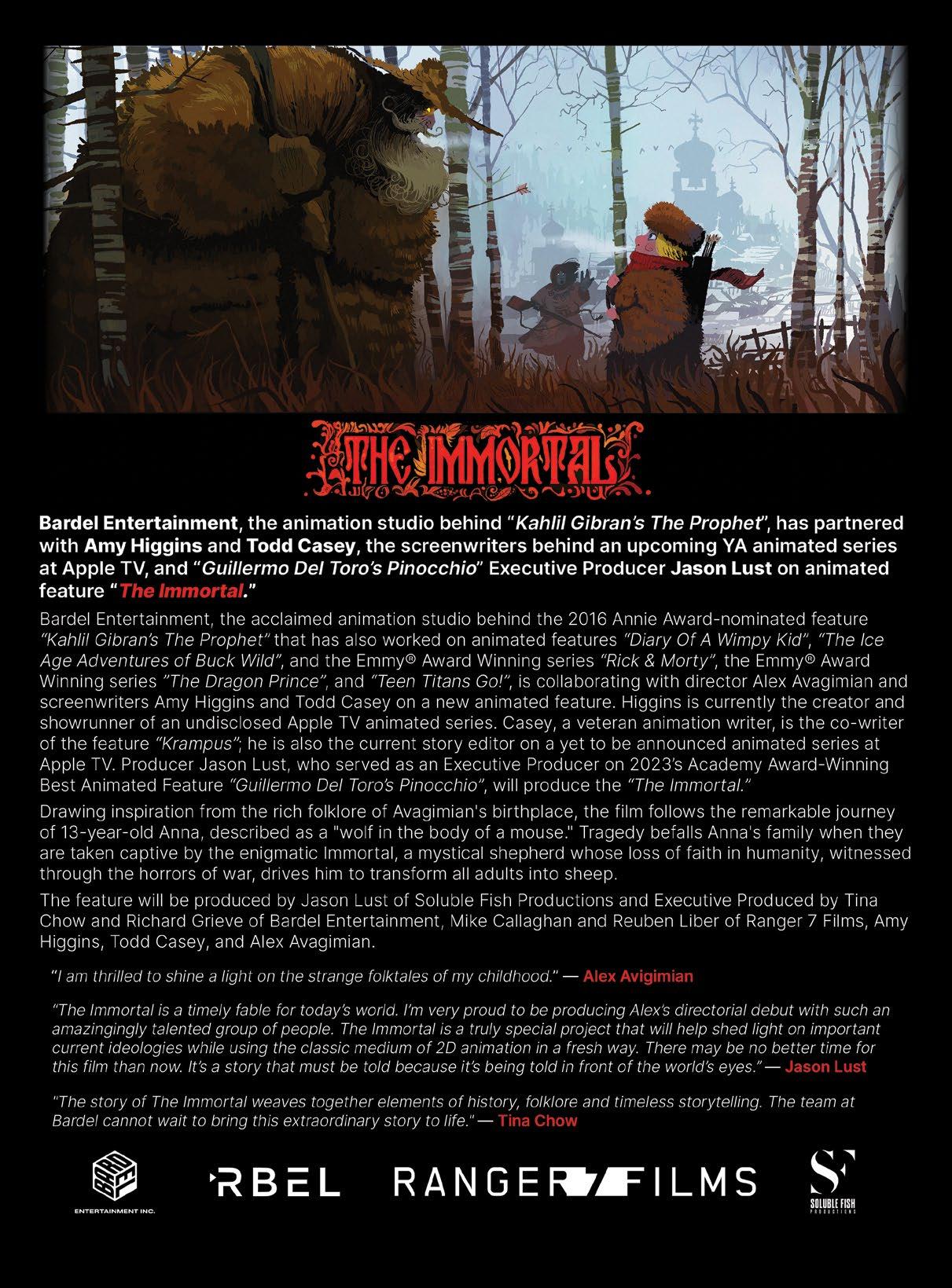
Welcome to the Entertaining World of Bimi Boo
Can you tell us a little about the popular Bimi Boo gaming and education brand?
Ani Poghosyan: Bimi Boo Kids creates educational gaming apps for children that facilitate interactive learning. Our apps cover math, literacy, and social-emotional learning, and can be downloaded on iOS and Android devices. Bimi Boo is proud to be the #1 downloaded game for children under 5 years old on iOS The brand remains committed to providing top-quality educational content and continually expands and innovates the offerings.
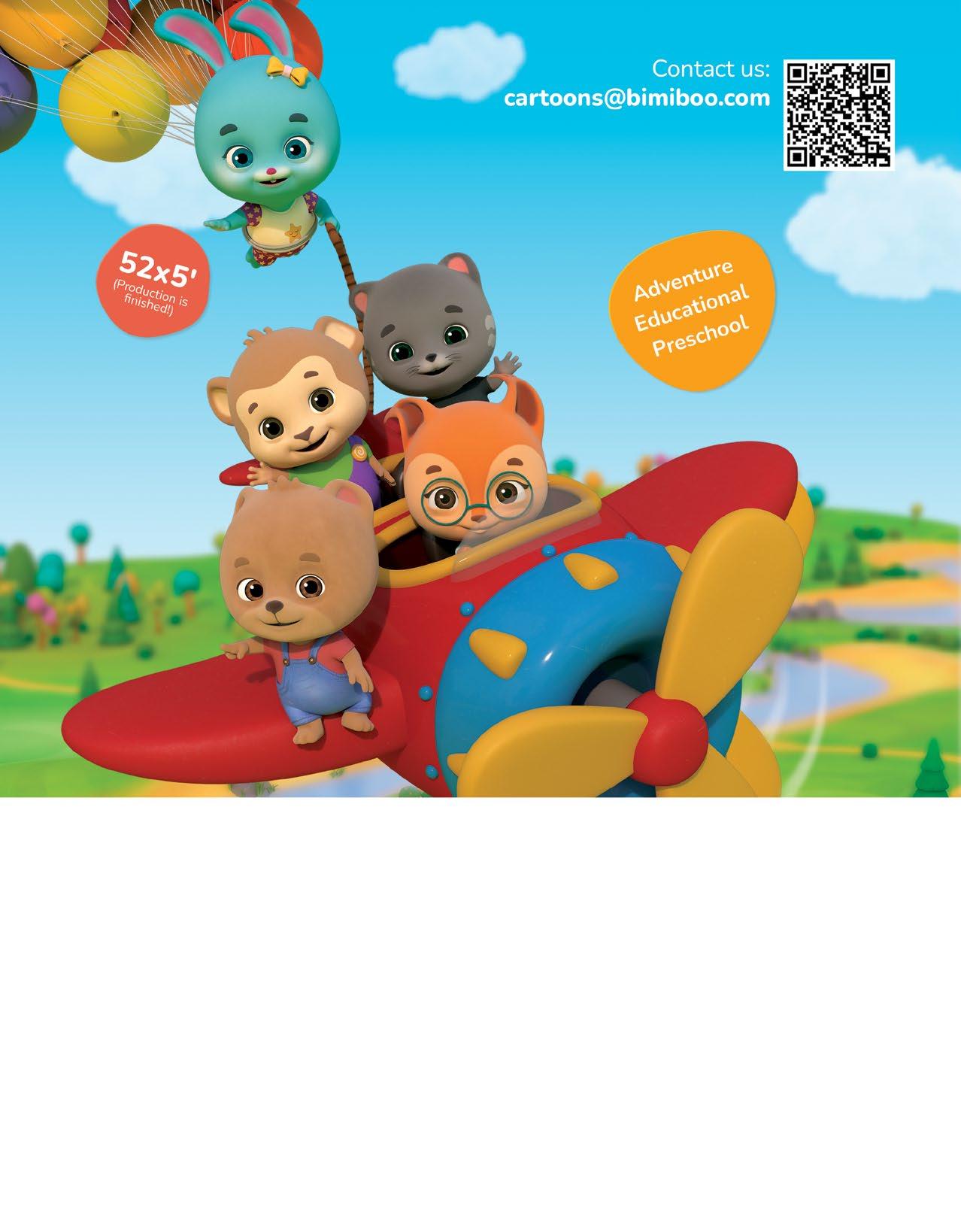
At Bimi Boo Kids, we strongly believe in harnessing the power of children’s sense of wonder and curiosity. Our ultimate goal is to inspire children to discover the joy of learning and foster a lifelong love of knowledge. Our team consists of experienced designers, graphic artists, animators, and educational experts. Together, we are dedicated to creating products that are designed to accelerate the child’s learning and development in a healthy way.
What do you think makes this brand stand out from other similar cartoons for preschoolers?
ria Montessori, John Dewey, Jean Piaget, and other pioneers to guide us in our approach. Our characters celebrate diversity and respect individual differences, fostering a strong community based on unique strengths and weaknesses. Parents can also enjoy watching the show with their children and extend the learning through activities, while also getting a better understanding of their children’s interests.
What are your goals for 2023 and beyond?
Stay tuned for the next chapter! Our team is gearing up to utilize different mediums for creating an even more exciting and engaging experience for children and their parents around the world. We have also been busy crafting new original songs that are also available on various platforms for everyone to enjoy.
Why did you decide to develop an animated series based on the property?
We want to be where kids are and to cater to their entertainment and developmental needs. Cartoons are a powerful medium for children and an opportunity for us to deliver inspiring exciting stories and characters that children can relate to. Our mission is to contribute to creating a safe and wholesome childhood for children, which we believe can lead to a brighter future. Through our content, we aim to help children become well-rounded, empathetic, and creative individuals who can make a positive impact on the world around them. The Incredible Stories of Bimi Boo and Friends promotes child agency, independent learning and encourages emotional expression. They can stimulate the imagination, develop social skills, and foster a love for exploring and creativity.
What were your original goals for this project?
With our extensive experience in playful education for children, we have a deep understanding of their needs and what parents expect for their little ones. Our characters are carefully crafted to embody the unique traits of children, making them highly relatable and recognizable to the audience. Our main character Bimi Boo, is the curious and adventurous puppy who has the unhindered excitement to explore the world alongside his friends. Charlie the cat is an avid admirer of gadgets, while Lindsay the squirrel represents a strong and fearless female character with a dream to fly. Through exciting adventures, children discover subjects like astronomy, arts, sustainability, and biology, while also learning values like kindness and friendship. We use interactive means to make complex concepts easy to understand, inspiring children’s curiosity about the natural world. We draw inspiration from the educational methodologies of renowned educators such as Ma-
What would you like the animation community to know about The Incredible Stories of Bimi Boo and Friends?




Our creative and imaginative cartoons offer a range of benefits for kids and parents, from sparking storytelling and creativity to promoting language development and emotional expression. And with lovable characters and exciting adventures, Bimi Boo is more than just education—it’s just pure joy. We believe that good cartoons can make kids want to stay home and great cartoons will inspire them to roam. We strive to create a colorful world that will enthuse kids to explore and keep coming back for more. ◆
For more info, visit bimiboo.com
www.animationmagazine.net 80 jun|jul 23
Advertorial
Ani Poghosyan, sales manager at Bimi Boo Kids, discusses the popular educational gaming app and animated preschool series.


The Purrrfect Show
KidsCave Studios’ CEO Ed Bignell on why Kitti Katz is the cat’s meow


About eight years ago, Ed Bignell set up KidsCave Studios in London to produce Robozuna, the boys action series he had created. “It was a co-commission between ITV Studios and Netflix and a pretty big order (40 x 22-minutes),” he recalls. “On the back of successfully delivering the show, we were very fortunate to have Netflix pick up our next original series, Kitti Katz. With two originals under our belts, we’re now expanding our boutique, creator-driven studio to accommodate a multi-project pipeline with a diverse slate of new projects across features, preschool and teens now that Julian Scott (Poppy Cat, The Large Family, Tiny Planets) has joined the company as COO to drive the studio’s output.”

Kitti Katz centers on the heroic adventures of three 14-year-old girls who gain the magical ability to transform between cute kittens and powerful super-cat-girls as they attempt to save the world from an evil Egyptian goddess of the underworld. “The show combines cinematic action with soapy teen storylines as they navigate the social minefield of high school, deal with romantic attentions and try to remain friends and keep the Kitti Katz together,” says Bignell, whose credits include King Arthur’s Disasters and Little Robots “Just regular teenage lives really!”
The show was created by Bignell about nine years ago. “It’s primarily targeted at girls (6 to 12 years old), but we’re hoping families and cat-crazy fans will enjoy too,” he notes. “The market was very much boys-action at the time, and I felt we needed some strong young female action heroes for a change! I like to think of the show’s visuals as vibrant ’80s neon-noir with an anime twist!”
All pre-production is handled by KidsCave Studios in London while the writers are based in Los Angeles. “We designed and managed everything up to and including the animatics and used PanelForge for our 3D storyboards,” notes Bignell. “The 3D asset creation and animation by L’Atelier Animation in Montreal using Autodesk Maya for

modeling to animation, Houdini for effects, Mercenaries Guerilla for lighting, and Nuke for compositing. Post-production was, again, handled by KidsCave in London.”
Vibrant Colors and Surprising Storylines
Bignell notes that the show has been receiving a lot of positive comments on its visual style. “As we were a relatively early adopter in our pipeline of HDR, we’ve been able to exploit that potential and really punch a vibrant color palette through in the final Dolby Vision grade,” he explains. “I also feel we have a pretty unique fantasy for our audience where our heroes can double transform between a small vulnerable kitten and a larger powerful super-cat-girl. The idea being an analogy for that point in life between remaining a child and childlike behavior and the cusp of adulthood and wanting to be a powerful, more adultlike person.”
Bignell says he hopes audiences will connect and enjoy the show’s dynamic characters and storylines. “Then perhaps, they’ll get a sense that believing in and challenging yourself
will help you overcome the obstacles life throws at you,” he adds. “Finally, if they feel as inspired by Kitti Katz as I was when I first saw Star Wars, that would be truly amazing!”
The producer would like the global animation community to know that the passion he and his team have for the work has resulted in two projects with real heart and soul. “We’re a strong creative and commercial partner with a track record of delivering globally appealing, hi-end content on time and on budget,” Bignell concludes. “We love to develop animation brands that are conceived and executed with a fully transmedia approach. We’re carving out a niche with our new development slate for older kids and with Julian on board, we’re also interested in taking on the right development and service work for legacy IP and I probably shouldn’t say this in Animation Magazine, diversifying into live-action!” ◆
For more info, visit kidscave.com and kittikatz.com
www.animationmagazine.net 82 jun|jul 23
Advertorial
Ed Bignell
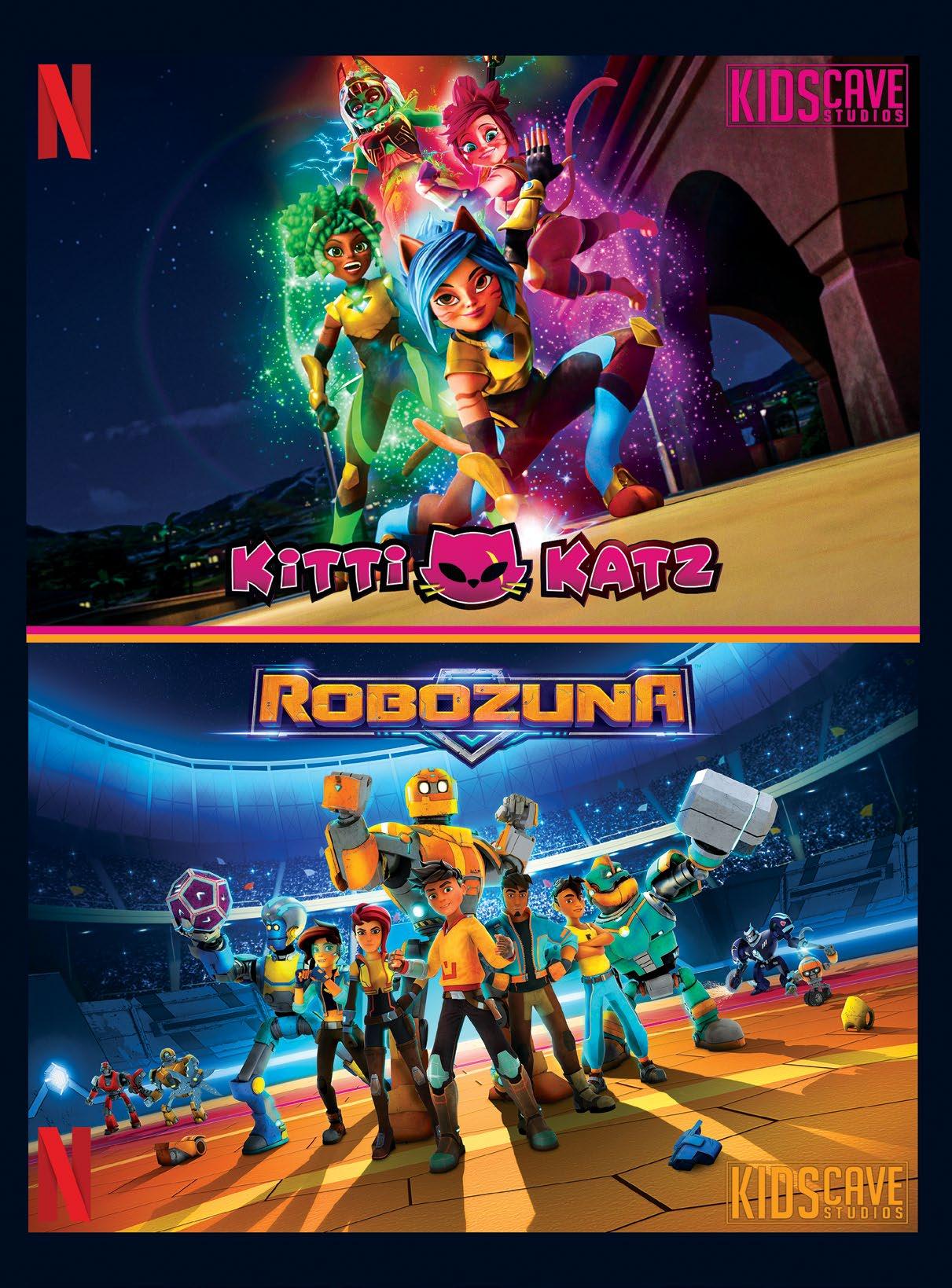
Introducing New Funding Opportunities
Ibermedia Next offers new grants to the region’s visionary animation producers.

Ibermedia Next is an initiative of the Ibermedia Program aimed at applying new technologies in the field of digital animation and audiovisual content with a high percentage of animation, financed with Next Generation Funds from the European Recovery, Transformation and Resilience Plan, through the “Spain, Audiovisual Hub of Europe” component.
For the creation of this new line of grants, Ibermedia has allied with Premios Quirino de la Animación Iberoamericana and La Liga de la Animación Iberoamericana, which includes Premios Quirino Awards (Spain) together with Animation! of Ventana Sur (Argentina) and the Pixelatl Festival (Mexico), which are the main driving forces of the sector in the region.
This pioneering line of grants from the Ibermedia Next initiative was created to promote talent and the professionalization of the sector and to encourage the incorporation of new technologies in the creation of animated content. “We introduced these grants after carefully listening to the demands of the sector, and seeking the modernization of a field that we consider strategic for the future of the Ibero-American audiovisual industry,” says Víctor Herreruela, coordinator of the Ibermedia’s Technical Unit. “Thanks to this line of funding creative talent will be promoted supporting digital animation projects or those with real images that include a high percentage of animation.”
These grants are available to Spanish, Italian or Portuguese companies dedicated to independent film or audiovisual productions and the creation of interactive and digital content co-developed with Latin American companies or creators from Ibermedia program’s member states. “Any professional or company who wants to apply must be registered prior to the registration of the project in the free online partner search platform Ibermedia Next Plaza that we have also created around this line of grants,” says Herreruela. “For the first time in the history of the Ibermedia program, support is given to formats for demonstration purposes, such as prototypes or teasers, in addition to pilots, short films or video clips that constitute digital animation projects, or live-action
projects that include a high percentage of digital animation and/ or vfx content (at least 75% of the footage).
The selected projects will receive a grant that includes a financial contribution of up to 150,000 euros, and a training, consulting, promotion and dissemination program for these audiovisual projects and the companies and professionals that lead them, valued at up to 95,000 euros. Each project will benefit from the networking, communication and promotion actions of the Ibermedia Next and Ibermedia programs, and will be able to participate in promotional actions within the events adhered to La Liga de la Animación Iberoamericana (Pixelatl, Premios Quirino, Animation! Ventana Sur), among other events of the sector.
The period for receiving applications is between May 12 (coinciding with the sixth edition of the Ibero-American Animation Quirino Awards) and August 21, 2023. The registration process will be done through the new Ibermedia Next website: ibermedianext.com
“This is a historic opportunity for the entire Ibero-American region and Italy,” says Herreruela. “Never before has such an ambitious line of grants been promoted with an eye on the future of the animation sector in the region. We are going a step further in the use of technology in digital content of all kinds. We are offering the future leaders of the sector the opportunity to develop their full potential with this program which


also includes consulting, communication and promotion. They will also have the opportunity to create their own network of contacts by attending the animation events and through the free Ibermedia Next Plaza platform”.
For more info, please visit ibermedianext.com and follow the Initiative’s socials:

Instagram: @Ibermedianext
Linkedin: @Ibermedia Next Twitter: @Ibermedia Next
www.animationmagazine.net 84 jun|jul 23
◆
Advertorial
Víctor Herreruela

Bangkok’s Best
At 16, Thailand’s Igloo Studio has become a super cool hub for international animated projects.

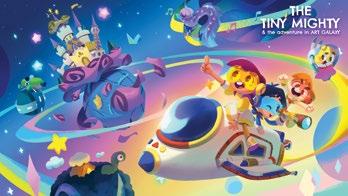
Founded in 2007, Igloo Studio was established by a group of skillful artists from different fields who are passionate storytellers and creators in Bangkok. According to studio’s CEO, Nat Yoswatananont, the studio’s mission is to grow its workmanship and bring imagination to life. “With over 200 team members, we are ready to take your project to perfection,” he says. “In addition, we have a plan to support the new generation by establishing our own Igloo Academy.”
He adds, “We are a one-stop service studio and also concentrate on our talents by creating IP. Here at Igloo, you can come in with just an idea, and we will turn your script into screen. Our creative, art and design teams handles everything from the storyline, script and concept design. The animator team is the biggest team of our company right now and the supervisor has experience working with many global companies.”
Excellent Thai Craftsmanship
Nat describes Igloo’s animation style as vibrant, fun and meticulously crafted. “Our mission is to ensure that the audience can enjoy the work that we do, and can relate to the story,” he says.
Among the big projects Igloo is working on is My Daemon, an original anime series from Netflix Japan. The show, which is set on Earth after a nuclear explosion, centers on a young boy named Kento who finds a demon named Anna in the forest and the two embark on a trip to save Kento’s mother. Written by


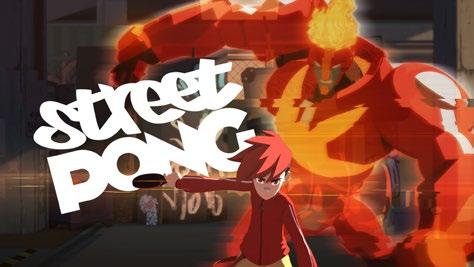
The talented CEO points out that one of the key challenges for the studio has been finding opportunities for its original IP content. “We have a full catalog of various styles of content which are all in the development stage,” he notes. “‘We are looking forward to getting to know distributors, publishers, SVOD platforms, or anyone who has new animated projects this year. We are focusing on Street Pong, an animated series for 12+ years old (26 x 22-minutes) and also The Tiny Mighty, an animated show 4-6 years old (26 x 11-minutes) which will be one of the projects featured at MIFA’s pitch event at Annecy this year.”
“Another challenge is to be a home for Thai artists,” says the CEO. “We don’t want to be just an animation studio, but we also want to create a home, a safe space for Thai artists to be able to express themselves and show their styles. We want to help them and train them to be the best version of themselves.”
Igloo Studio also aimes to be a one-stop shop for its clients. “We also have sister companies which are Nanuq (developing video games with the best quality), Qlay Station (Toys design), and Toonbuns (Character, concept art design & 2D comics),” says Nat.
“We constantly seek business partners, regionally and internationally, who share our passion and common goals. Bringing our respective expertise to the table, our team and our collaborations will be unstoppable.”
A World of Possibilities
“During Covid, we found that there is more demand for animation,” he adds. “People are starting to realize that animation can also tell the stories, and the medium can be used for commercial, advertising and other works as well. I think the animation industry is growing every day, because it allows people to share ideas and express themselves through art, so in our opinion, the animation industry is having a bright future. However, we also need to encourage the younger generation to explore careers in this industry.”
Hidetaka Adachi (Otsuichi),
the series is directed by Nat. “We’re responsible for all aspects of the show from pre-production until post.

Nat wants the global animation community to know that Igloo is quite a unique, boutique studio. “We strive to develop our artists and our contents to become a world-leading studio,” he concludes. “We are ready to create original content full of delicate arts and inspiring stories for the audience.” ◆
For more info, visit igloocg.com
www.animationmagazine.net 86 jun|jul 23
Advertorial
Nat Yoswatananont

Recipe for a Hit Show
DeAPlaneta Entertainment and GO-N Serve Up the Perfect Monster Shaker
Spain’s DeAPlaneta Entertainment and France’s GO-N Productions have joined forces to bring some fun monster cocktails to animated life dynamic this year. The new show, which is titled Monster Shaker, based on books by Mr. Tan and Mathilde Domecq. As legend has it, Mr. Tan came up with the concept of the show while playing with his nephew.
The 52 x 12-minute series follows the adventures of nine-year-old Justin as he discovers the magical powers of his grandfather’s cocktail shaker, which allows him to create wild and crazy monsters. It’s all fun and games until Justin and his older sister Gwen realize that the monsters have to be chased back in the shaker!

“Monsters usually come from sophisticated universes, but what if you had the power to create monsters thanks to ingredients you have in your house?” asks Carlos Biern, director of content and distribution at DeAPlaneta Kids & Family. “Mixing five very common elements in a shaker (the Monster Shaker), our hero can conjure up monsters to help him in his daily challenges. What child wouldn’t dream of that?!”
The show’s is produced by GO-N Productions in Paris and by Studio Waooh! In Liège (Belgium), both using Animate Adobe to create the 2D animation.
Monsters at Home
“Most of our partners were actively looking for a fresh and new approach to shows linked to monsters and collectibles that would work for the digital generation,” says Biern. “We believe we succeeded in creating an IP that, in addition to being funny and imaginative, will stand out in the interactive and licensing areas globally.”
Biern adds, “It comes from a fantastic idea that already succeeded in publishing and that, thanks to an amazing writing and animation Euro team led by GO-N, has been transformed into an authentic brand we believe will stand out for years! It is an exciting idea that appeals to all kids: creating powerful friends to help you out of sticky situations—though most times, the monsters create a whole new set of problems making it extra funny. The show features Imaginative stories and unbelievable situations led by an extra super layer of Monster sauce!
“Monster Shaker also offers kids an energetic and funny cocktail of adventure, comedy, and fantasy,” adds GO-N’s president Eric Garnet. “It’s the perfect recipe for children (six- to ten-year-olds)! Our favorite things about the show are multiple: It has universal appeal: Just like Aladdin, it’s the power of a very simple tool that creates creatures to help you to access everything you want. The show also depicts a realistic relationships between our two main characters: Justin, the master of the Monster Shaker, and his preteen sister Gwen, as well the kids’ relationship with their grandfather.”
Garnet says the biggest challenge for the project has involved the writing process. “We had to play with the rules of the shaker while balancing comedy, adventure, and emotional stakes for our heroes. We wanted to make every episode unique and full of surprises — and we did!”
Biern says at DeAPlaneta, he and his team are advancing and upgrading from being a leading licensing distributor in Europe to a global animation Studio. “Our recent opening of offices including the U.S., Germany, China and South Korea, has a content strategic component based on potential business opportunities.”


String of Successes
The animation industry veteran cites the acclaimed preschool series Milo as one of DeAPlaneta Entertainment’s recent successes. “The show, which comes from the U.K., is performing
amazingly well in all the territories that it is airing,” he notes. “Our reboot of the popular shows, features and books Lilly the Witch, reset to Magic Lilly, already entered full production with just a first teaser with the best partners we could dream of.”
“We are happy to integrate innovation,” he concludes. “Several IPs coming from the metaverse communities and digital space are also in production. We link and finance ideas that could come from any entertainment field or country and upgrade them onto a potentially becoming a global hit brand. Our expertise is to make all areas of the IP (design, storytelling, exposure, consumer products and interactive) work together so that audiences spend much more time (hopefully decades!) with our characters. At DeAPlaneta Kids and Family we are also proud of sponsoring great events to find and nourish amazing talent like the Quirino Awards (Tenerife) targeting Spanish and Iberoamerican studios and partners. ◆
For more info, visit deaplanetakidsandfamily.com.
www.animationmagazine.net 88 jun|jul 23
C M Y CM MY CY CMY K
Advertorial
Eric Garnet Carlos Biern






MASTER AGENT & DISTRIBUTOR Antonella Ceraso Consumer Products Director aceraso@deaplaneta.com Judit Foz Povill Head of Media Sales, Iberia France & Western countries jfoz@deaplaneta.com Lucia Vismara Head of Media Sales, Italy, CEE and Eastern Countries lvismara@it.deaplaneta.com 52x11’ In production Based on bo ok series by Mr Mathilde D om AM Monster Shaker.pdf 1 18/5/23 18:01
Music to Soothe the Preschool Set
The top-notch 2D animation studio Letko is hoping to ignite a new global interest in the music and legacy of popular 19th century Polish composer Frédéric Chopin, while also teaching kids about the magic of sounds and music around us. The Warsaw-based studio will bring its new project Freddie: The Little Chopin to the Annecy market in June.
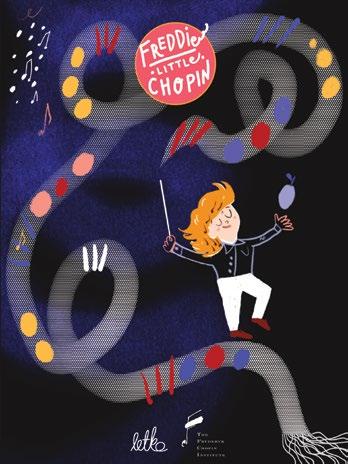
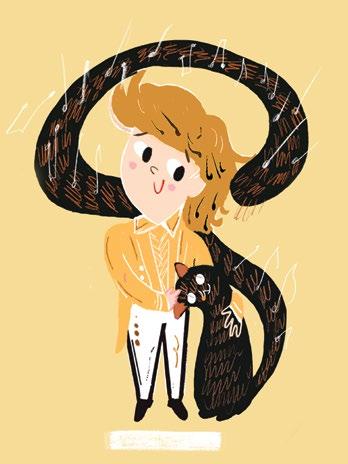

“We are very excited to reveal this new project,” says Jakub Karwowski, CEO, co-founder and exec producer at Letko Animation Studio “We are working on with our team at Letko together with great partners from The Fryderyk Chopin Institute. Living with music gives you strength and power and challenges you to be open and creative. We believe that Freddie: The Little Chopin is a perfect guide to the world of music for children.”
Karwowski, who also co-created and exec produced the popular animated preschool series Odo, which has been sold to over 160 territories, adds, “The first season of the show will have 52 seven-minute episodes. We hope to premiere our first episode during the one and only International Chopin Piano Competition in October 2025.”
Songs in the Key of 2.5-D
The show’s animation style is inspired by the illustrations of the book series of the same name by Aga Pietrzykowska. “We plan to use 2D cut-out technique and mix it with hand- drawn animation and 3D lighting,” says the producer. “We love to call it 2.5-D animation. As in our previous show, Odo, we will be offering stories aimed at three- to sixyear-old kids.”
The show’s hand-crafted animation will be done in the Letko Studios in Warsaw. As Karwowski explains, “In recent years we managed to get training and experience for a very solid group of professionals, with whom we have worked on several international projects with great results! We mastered the Toon Boom Harmony pipeline, for which we create our own tools and scripts.”
The studio aims to create two distinct animation universes for show by using different artistic approaches for each one. The first one, which is realistic and will include collage compositions and contour drawing, will be used to illustrate how music comes from
everyday situations. The second world is fantastic and depicts musical explorations. “We will go in the direction of more colorful and abstract forms where morphing and pictorial playfulness will be used as depictions of the characters’ imagination,” says the producer.
Karwowski says he and his team strongly believe in the concept, art style, sound design and unique qualities of the show’s main character. “Is it coincidence that his first and last names are the same as the famous pianist Fryderyk Chopin?” he asks. “The answer would be yes but not entirely. Freddie also lives in Warsaw and he has a great talent to delight a salon audience. His superpower is his musical imagination, which allows him to captivate others into the extremely playful world of sounds. It is not about classical music or Chopin’s music — but about the magic, spirit and energy that is alive behind all of that. Through spontaneous playfulness, he experiments with the most unique musical phe-
nomena: harmony, rhythm, dynamics, he unravels the action of sound waves, synesthesia and the therapeutic effect of music — in his everyday life. Most importantly, however, he shows the audience that music surrounds us absolutely everywhere and, if we open ourselves up to it, we will become more free, happy and powerful. We believe that is all true and we want to bring that message to kids all over the world.”
Karwowski is proud of the fact that the show’s main character has connection to the young Chopin, who is a real hero in Poland and in the world of classical music. “Adding that reference to Freddie, who’s our guide to musical imagination for kids, is a great way to introduce this important figure. We believe it has great potential for international audiences, even in places where Chopin’s music is not that well known or widely played. I, myself, have been playing the piano since I was four. I was guided through the process of music education in a traditional and pretty boring way — until I discovered jazz, improvisation and started to follow my own, relaxed and individual way. I believe every kid can find their own way in the world of music: We can make it more accessible, vivid and exciting. We certainly hope that Freddie: The Little Chopin will serve as an entertaining introduction to music for young viewers all over the world. ◆
For more info, visit letko.co


www.animationmagazine.net 90 jun|jul 23
Advertorial
Poland’s award-winning Letko animation studio hits the right notes with Freddie: The Little Chopin.


The Terrific Toon Shop Down Under
Andrew Davies, CEO and founder of Australia’s Studio Moshi, gives us an overview of his thriving company.

Founded in 2005 by Andrew Davies, Studio Moshi is a 2D animation studio based in Melbourne, Australia, that specializes in character-driven comedy both in the kids and primetime space. The studio began in short form productions and then moved into full series and features, working directly with studios and commissioners like Disney, Warner Bros., Netflix, and Sony Animation to name a few.
“While we’ve been across prestigious dramatic animation projects, comedy remains at the cultural center of our company,” says Davies in a recent interview. “We’re currently producing a super-exciting primetime comedy series with a US streamer and some of television’s most celebrated producers, and Moshi’s in-house work spans pre-production through all aspects of animation production. More recently, we’ve animated Solar Opposites on Hulu, and Ari Folman’s award-winning feature Where is Anne Frank, which was a traditionally hand-drawn production that premiered at the Cannes Festival. We also have a kids’ character-driven animated comedy series currently in development with the BBC and NZOA, which we’ll be sharing with potential partners at Annecy this year.”
Studio Moshi is also the animation studio behind Sony Pictures Television and Netflix’s Good Times, the new animated series from Norman Lear, Steph Curry and Seth MacFarlane.
Visual Storytellers
Davies says the studio is bringing its A-game when it comes to primetime animation with a full mix of pre-production, 2D hand-drawn hybrid Harmony animation and weaving in CGI for memorable action moments. “We’re always innovating and pushing ourselves to find new approaches to delivering dynamic visual storytelling,” he says. “We’re a very skilled and eclectic animation studio and we pride ourselves on finding a workflow that not only serves the individual creative needs of the project, but a creative workflow which sits on our solid technical pipeline. We’ve learned how to support the
vision of US-based live action showrunners producing their first animated series, and we can take creative risks because we’re nimble and adaptive to the changing marketplace and needs of multiple partners.”
“It’s all about investing in tech innovations that serve production and a creative team who are multi-skilled and diverse in their approach and backgrounds,” says Davies. “This is the bedrock to any studio being asked to rise to the creative expectations of a U.S.-style streaming production and why we’ve been able to meet that demand.”
Aside from an experienced production team and rock-solid technical pipeline, Studio Moshi’s best investments are also in comedy-based creatives; stand-up comedians, improv artists etc. who help inform the work they do and deliver a creative and competitive edge. “We’re able to respond to creative challenges with real comedic solutions – AND - we think we’ve cracked the secret sauce to a comedic workflow which elevates the production,” says Davies. “This
is what people come to us for.”
So, what is an ideal Studio Moshi project? Davies says he and his team are largely focused on kids or adult primetime series, which are truly character-driven and where the storytelling is looking to deliver some thing unexpected. “We embrace projects that really rejoice in diversity in every sense whether that’s representation or celebrating non-conformist perspectives because they have something new to teach us about our everyday lives,” he says. “2D, CGI or hybrid – bring it on!
Well-Versed in Family and Prime-Time Toons
Davies says he’d like the animation com munity to know that Studio Moshi is well versed in fee-for-service, co-production, and independent productions. “We are a multi-series creative solutions-driven studio with a track record in delivering high-con cept, creatively ambitious content,” he adds. “And as an Australian-based studio with experience working directly with U.S. and other global commissioners, Moshi can pro vide up to 45% animation tax credit for feefor-service and original productions, from storyboards, animation through to post-pro duction.

“We’re looking for all kinds of partner ships; fee-for-service, official or un-official co-productions, for IP Design, story and an imation production services, 2D, and highend CGI character animation.”

He points out that the studio offers access to a workforce of over 250, and that they’re able to ramp up at very short notice drawing upon the talent pool nation-wide. “We also have an expanding creative footprint in Los Angeles where we’ve built relationships with leading Hollywood animation directorial tal ent who can liaise directly with our partners, concludes Davies. “But don’t be afraid of the distance! Australia overlaps with much of North American business hours so we’re easy enough to get a hold of!” ◆
For more info, visit studiomoshi.com
www.animationmagazine.net 92 jun|jul 23
Advertorial
Andrew Davies

A World of Solutions
TITRAFILM is known as one of the top providers of localization and delivery solutions in the media entertainment industry. The company, which has 150 employees in Paris, Vancouver and Brussels, specializes in post-production, global localization, accessibility (audiodescription, SDH), lab work (QC, graphics) and creation of broadcasting material (media processing) for theaters, TV and digital platforms.
“Our company serves independent producers, distributors, sales agents, festivals, broadcasters, and all Hollywood Studios and streaming platforms in post-production and localization,” says Stephane Chirol, Titrafilm’s VP of sales. “We offer the best multilingual services (dubbing, subtitling) through a network of 40 independent studios around the globe. Titrafilm is leading the industry by innovating and developing its own online platforms and tools to centralize, share and secure data.”
Decades of Animation Expertise
According to Chirol, Titrafilm has been working on animated content since 1933, beginning with the Walt Disney Company “We also signed a partnership with Annecy Film Festival in order to support the animation industry 20 years ago. We began working on animated shows and movies by providing localization services, extending afterwards to the post production process: editing, foley, color grading, mixing, mastering, multilingual localization and creation of worldwide deliveries.”
Among the company’s most recent projects are the localization of U.S. films such as The Super Mario Bros. Movie (Illumination/Nintendo/Universal Pictures) and Puss in Boots: The Last Wish (DreamWorks/Universal Pictures), as well as post-production and localization work on features such as The Inventor (Foliascope), Mars Express (Everybody On Deck), Sirocco (Sacrebleu), Chicken for Linda! (Miyu) and Robot Dreams (Noodle Dreams) — titles which are all presented at the Cannes Film Festival and the Annecy Animation Film Festival.

In addition to theatrical features, Titrafilm also works on TV and streaming shows such as The Coop Troop (Sixteen South, Tencent

Kids China, Technicolor Animation Productions/Mikros Animation, With the participation of France Télévisions), Alvinnn!!! And The Chipmunks Season 5 (Bagdasarian Productions, in collaboration with Mikros Animation (Technicolor Animation Productions), for M6 and Nickelodeon (USA), Droners (Cyber Group Studios, La Chouette Compagnie, Supamonks), PJ Masks Power Heroes (Frog Box S.A.S., Walt Disney EMEA Production Limited, Entertainment One UK Limited, France 5, Disney Junior US, Disney Television); Not Quite Narwhal, Kung Fu Panda: The Dragon Knight, Dew Drops, Gabby’s Dollhouse (Dreamworks), Eva The Owlet, My Brother the Minotaur, Sago Mini Friends, Duck & Goose, The Dragon Prince, Nimona for Netflix, Kensuke’s Kingdom for Le Pacte and Of Little Eggs of the Wishmas Tree for Alba Film.
“Titrafilm calls upon a wide variety of talented technicians and creators to post-produce and localize animation projects, by using workflows specific to each project,” says Chirol. “This expert approach allows us to take part in the most beautiful projects and that is what gets our passionate team excited. Since its creation, the company has always been the creator of its own solutions, beginning with mechanical solutions in the 1930s, followed by technical solutions later on, and software solutions today, with a solid expertise in R&D. This gives us agile
responses to project needs and allows for longevity in our relationships with creators.”
So, what are the secrets to top-notch lo calization work? “Excellence in creativity is the basis for success,” he says. “As the best director for a project is chosen for their skills, a post production and localization company has to be chosen for the same reasons. A post-production and localization process is a long journey, and this team has to be consid ered a key part of the production.”
“The world recognizes France as a coun try that excels in technological and creative matters, as is the case in post-production and localization,” Chirol concludes. “Titrafilm is the only independent company capable of offering premium post production and local ization to projects in France. We are setting up a team in North America to produce lipsync English dubbing for animation and live action and is extending its sound and image facilities in Paris. ◆
For more info, visit TITRAFILM.com
www.animationmagazine.net 94 jun|jul 23
TITRAFILM expands its slate of localization, post and delivery clients all across the world.
Advertorial
Sophie Frilley, CEO (left) and Stephane Chirol (right)


TITRAFILM-DREAMWORKS x ANIMATION MAGAZINE_V2.pdf 1 24/05/2023 09:49:03
BBC Studios Kids & Family’s Mission to Serve the Youngest
Cecilia Persson, Managing Director of BBC Studios Kids & Family Division, discusses the studio’s upcoming animated projects and plans for the future.
Can you tell us a little bit about your position and what you look for in projects at BBC Studios Kids & Family?
Cecilia Persson: I am the Managing Director of BBC Studios Kids & Family, which is the newest division of the BBC Studios content powerhouse, a global company with bold British creativity at its heart.

Our mission is to serve the very best to the very youngest by creating content that leaves a lasting impression and has the power to make a difference to the lives of kids and their families. Whether they are quietly moving or laugh out loud funny, the projects we look for must be able to move the audience and leave them hungry for more. They must be distinctive and bold with universal themes and great characters and stories at their heart.
We are also looking for projects that we can develop into global franchises which can be enjoyed by audiences all around the world and having the commercial expertise of BBC Studios at our fingertips really helps us to exploit this.
Also, due to our unique structure, we have a very flexible way of working and are able to work with partners to produce animation in different ways, whether it be through investment as a co-producer with indies, such as Hey Duggee, and Bluey or in-house produced shows like JoJo & Gran Gran and Supertato
Can you guide us through the various projects you are currently overseeing at the company?
On the animation front, our current priority is continuing to grow the world-beating brands in our existing portfolio which include the afore-mentioned Bluey, Hey Duggee, JoJo & Gran Gran and Supertato. We also have a strong development slate with a range of projects both pre-school and older that we are very excited about.


What will you be focusing on at Annecy?
I will be attending Annecy with a strong team this year including Edward Barnieh our new Head of Development. I am delighted that BBC Studios Kids & Family is hosting a Studio Focus session where Bluey creator Joe Brumm alongside, director Richard Jeffery and animator Mark Paterson to discuss the evolution of the Heelers’ joyous world, loved by adults and kids alike, from sketch to screen and beyond.

Aside from that I look forward to talking to existing and potential new partners about our animation development portfolio including pre-school series Flip, Flap and Zip Currently in development with Finnish production company Haruworks, this new preschool series, inspired by unboxing videos, taps into children’s unbridled curiosity.
Alongside our partnership with Big Deal
Films to develop an animation series based on the hilarious Little Bad Man books about a mischievous wannabe rapper and his crazy friends and family, penned by best-selling authors; YouTube sensation Humza Arshad MBE and his writing partner Henry White.
What do you think makes the BBC Kids & Family’s animated content stand out in this competitive field worldwide?
Our content has the power to connect with and move the audience. Whether that be by the quietly ground-breaking portrayal of family and community in JoJo & Gran Gran, the laugh out loud heroics of Supertato or the subtle, deadpan charm of our global cult hit Bluey.

What is your take on the global animation scene in 2023 and beyond?
As ever, funding remains an issue for the global animation community and with budgets squeezed and rates inflating it is becoming harder and harder to get projects off the ground and then find and retain the right talent to make them. One approach we have found successful is offering mentorships both internally and with our creative partners which allow us to attract more diverse and novice talent and retain them by moving them onto other productions and recommissions.
www.animationmagazine.net 96 jun|jul 23
◆
our-production-brands/kids-family
https://productions.bbcstudios.com/
Cecilia Persson
Bluey
Advertorial
Hey Duggee Supertato

Sophisticated French Fare in the Limelight
Fans of bold, innovative and well-crafted international animated features recognize Gao Shan Pictures for producing acclaimed titles such as Zombillenium (2017), Funan (2018), I Lost My Body (2019), My Sunny Maad (2021) and last year’s Annecy Cristal Prize-winning Little Nicholas. Later this year, audiences will also see Gao Shan’s They Shot the Piano Player, a musical animated feature from the Oscar-nominated team behind Chico and Rita, co-produced with Les Films d’Ici Méditerranée.

The studio, which was founded by 2014 by French industry veteran Arnauld Boulard (Despicable Me) is bringing two of its eagerly anticipated arthouse features, Jérémie Périn’s Mars Express and Benoît Chieux’s Sirocco and the Kingdom of the Winds to Annecy this year. Mars Express had its world premiere at the Cannes Film Festival in May as an official selection. Later this year,
“This forthcoming Annecy Festival is a particularly busy event for us,” says Boulard. “Two features that we worked on are in competition, Sirocco and the Kingdom of the Wind & Mars Express. These selections confirm our love affair with the Annecy Festival, where since 2017 our work has been awarded a Cristal or a Jury Prize every year — with the exception of the infamous 2020 online edition!”

In addition, The Forest of Miss Tang will also be screening at the festival as well. Directed by Denis Do (Funan), this 40-minute family chronicle takes viewers on an existential quest through several generations of a single family, all shaken by 200 years of history in China.
An Environmental Cautionary Tale
Gao Shan will present a Work in Progress session focusing on the Into the Wonderwoods (Dans la Forêt Sombre et Mystérieuse) which it is coproducing with Je Suis Bien Content. “Directed by Vincent Paronnaud (Persepolis) and Alexis Ducord (Zombillenium), this CG-animated movie really stands out thanks to its strong script and outstanding visual elements,” he notes. “It deals with serious subjects like death and the destruction of our natural environment with irresistible humor
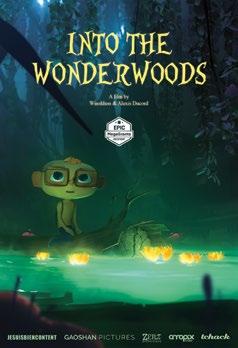
and a lot of tenderness. We have talking animals, but they’re not the cute little characters we usually see in animated films! On the technical side, it allowed us to start integrating Unreal 5 into our pipeline (thanks to an Epic MegaGrants).”
“We also have a short selected in the MIFA pitch session titled Pié dan lo, which is directed by Mauritian artist Kim Yip Tong,” he adds. “It’s a very sensitive animated documentary which looks at how people joined forces to save their environment after the

Wakashio oil spill in the Mauritian lagoon in 2020.”
At the Annecy market, Gao Shan will be looking for sales and distribution partners for two upcoming features in development.
“Based on a novel by Joseph Marshall III, Winter of the Holy Iron, is a powerful story set in the Dakotas during the mid-18th century, which provides an authentic portrayal of the Sioux and their encounters with white people,” says the producer. “We’re entering pre-production, and are experimenting with mo-cap, 3D scan of landscape and Unreal pipeline. The movie is directed by Francois de Riberolles, a successful documentary director, whose most recent project Magellan’s Incredible Journey was a bit hit in France.”
Another upcoming is The Fire Keeper, which is an adaptation of a novel by French writer and environmentalist Pierre Rabhi. “The movie was in the MIFA pitch last year,” says Boulard. “The director Jeanne Irzenski has been working with us as an animation supervisor for years, and this is her first return to directing since she left Gobelins School. We’ll be also looking for broadcasters for a 2D TV special, The Possum that Didn’t based on the book by Frank Tashlin on which we partner with Dog Ears in Northern Ireland. It is directed by Paul O’Muiris who has previously been in that role with Cartoon Saloon for Amazon Studios.”
Boulard says Gao Shan Pictures is focusing on its international development on the animation studio side, and on the development of its own IP on the production side. “Many quality and ambitious films are emerging, as you can see by the magnificent and competitive selection at the Annecy festival this year,” he notes. “Yet, we also see that financing is particularly difficult and time-consuming at the moment. Some very good films in development are having difficulty securing financing and getting into production. In addition, platforms (streamers) have particularly disengaged from independent productions in recent months. Let’s hope they will quickly come back to supporting productions that stand out from the offerings of major studios to reach a different audience worldwide.” ◆
For more info, visit www.gaoshanpictures.com

www.animationmagazine.net 98 jun|jul 23
Gao Shan founder Arnauld Boulard will take a rich animation slate to Annecy this month.
Mars Express
The Forest of Miss Tang
Advertorial

An Animation Studio Grows in Budapest
Budapest’s DIGIC moves into the animated feature space with several ambitious projects.


In 2002, Alex S. Rabb and the late Andy Vajna, known for producing blockbusters like First Blood, Total Recall, and Terminator 3, formed DIGIC in Budapest. They shared a common vision that Hungarian CG animation talent could compete on the world stage and be leaders in the arena. “After we established the studio, DIGIC’s focus quickly became fully 3D rendered content, although we occasionally engaged in visual effects work (Terminator 3),” says Alex S. Rabb, the studio’s CEO, and producer. “CG work remains our primary focus, but now it’s on a different scale: Over the past 20 years, we’ve grown to a size of nearly 400 staff.
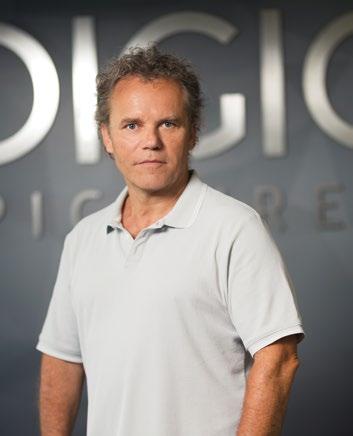
Rabb, whose many impressive credits include “The Secret War” episode of Love, Death + Robots, Titanic, and Final Fantasy: The Spirits Within, says moving into animated features has always been a primary goal from the early days. “We have always thought of ourselves as filmmakers—but making that dream a reality, and doing so responsibly, meant steady construction work spanning nearly two decades. So it wasn’t until 2019, with a staff of around 330, that we embarked on developing our own feature.”
“We currently have six IPs in our development portfolio,” shares Rabb. “Four of these target the wider 4Q family space, two are adult IPs—and all are edgy, of course! But seriously, we aim to tell wildly entertaining stories yet also have a heart and a message at their core. We don’t want to preach, we’re not hitting people over the head with it, but the message is always there for those open to it.”
All the Right Tools
The artists at DIGIC use animation tools that are pretty much standard in the animation and VFX industry. “The backbone of our pipeline is Maya, where all our scene assembly takes place,” says the CEO. “It is also where our keyframe animation is done. Modeling can be done using almost any tool the artists are comfortable with; the artistic result matters. For effects, we use Houdini; we render in Arnold and composite in Nuke.”
Rabb says the studio is currently working towards its first greenlight—which may be just a few months away. “That is the nature of the business, and we are learning a lot while we’re pushing our first IP over the line,” he notes.
“It’s important to realize that producing your own IP is more like a marathon to the starting
line than a sprint to the finish. Once everything is in place, we can produce a top-quality 90-minute feature in about 18-20 months.”
This year, Rabb and his team plan to continue strengthening their presence in animation, for example, at events like MIFA at the Annecy International Animation Film Festival. “I’ll just say that anyone interested in what IPs we’ve been developing should attend our Studio Focus event on Thursday, June 15th at 11:30 am at Annecy’s Salle de la Volière venue,” says Rabb. “Or just stop by to chat with us any time at the market. We’ll be at Booth A.24. Besides the ongoing development work on our IPs, we will continue building upon the exciting relationships and discussions we’ve already established with possible partners. With a bit of luck, we’ll have some fantastic news to share soon!”
Rabb wants the global animation community to know that DIGIC is entering the feature animation industry. “We are now big enough to keep servicing our loyal clients from the games cinematics space while expanding into this exciting and challenging area. We are open to connecting with serious partners who want to be a part of this journey with us,” he says.
“It’s a tremendously exciting time for the industry, all things considered,” he concludes. “Besides the opportunities, there are challenges too, of course. But with the growing demand for quality animated content, we feel we are in a good position to achieve our goals.” ◆
For more info, visit digicpictures.com
www.animationmagazine.net 100 jun|jul 23
Advertorial
Alex S. Rabb

Can Animation Render a More Sustainable Production Future?
- By Jessie Nagel

Animation has the ability to bridge gaps of understanding and can transport audiences to places they couldn’t otherwise go. It’s been a vehicle for empathy and for division, but much of the time animation is a place of creative delight. Behind the scenes, however, the industry has grappled with most of the same issues experienced by those in live action — including systemic inequity, lack of diversity and processes that, like all industries, have a negative impact on the environment.
Change in all areas requires collective will, understanding and resources to support transition. That perspective, seen in the work done
by a variety of other organizations from Women in Animation to Free The Work, was the inspiration behind the development of Green
The Bid. Green The Bid was launched nearly three years ago to bring together the entire advertising industry — brands, agencies, production and post studios, including VFX and animation, along with individuals and supporting organizations — to reduce the waste and shrink the carbon footprint of our industry.
Today, over 400 companies around the world of all sizes have pledged to participate and take meaningful action. The participation is unique to what each company does — or, as I like to put it, according to their superpower.
For animation company, this means adopting some key practices in office:
Going paperless, eliminating single-use plastics, getting on a green/renewable energy plan (where available), turning off climate control when not needed, eliminating red meat in catering and food orders, donating and composting leftover food, promoting carpooling or public transport commuting and minimizing the use of toxic solvents. Unlike live action, animation and VFX don’t have generators and idling trucks, numerous people flying to location, massive set builds (with

www.animationmagazine.net 102 jun|jul 23
State of the Art
-
STATE OF THE ART
‘We are expert at designing environments: It’s up to us to decide how we envision and create our future.’
CONTINUED ON PAGE 105 mage credit: Courtesy of Cotton Web

Animated Musings
Is Food in Animated Content as Simple as Green Eggs and Ham?
 - By Mary Bredin -
- By Mary Bredin -
We hear the phrase “we are what we eat” often, but is it also true that we eat what we watch? What are content producers feeding, literally, to our younger audiences these days? There are various studies on “branded food,” i.e., food sold with a character, and the findings are clear: it is appealing. Some of these studies are listed below. They are wordy but, overall, they confirm that what is displayed “on screen” is influential.
Where to start with food in children’s content? It is a part of family life — so it should be included in children’s content, but what does that look like? Is there a “healthy representation” or should there be none? There are many sublime scenes of food in animation, from Spirited Away and Ratatouille, to SpongeBob flipping burgers at the Krusty Krab, to Bob’s Burgers. We can all agree food is a huge part of animated content. But we now know childhood obesity is a major issue and food insecurity among children is, sadly, all too real. Perhaps it’s time to reflect on how food is represented in the stories we tell. Many broadcasters have rules around food, but perhaps the conversation needs to go wider. Is a rule such as, “You can show the ice cream cone, but not children licking the ice cream” really useful? It raises more issues than can even be considered here.
In North America, our children’s content has so many food options: snacks, cereal for breakfast, packed lunch for school and then
sit-down dinner as family time. Yet, there is not much variety in the food. I am happy that the Krusty Krab patty is vegetarian (Phew!). But maybe it’s time for the steak and the slurpy in the plastic cup to leave the scene as well. The food futurist in me thinks we should all be reaching for our cricket protein shakes. (You can buy cricket protein in the supermarket now.) I think more environmental food options need to be presented. But not as the butt of the joke, either!

Too Many Snacks?
Why do so many characters need to eat a midnight snack? Maybe the recurring image can be replaced with the search for a glass of water since one can have meaningful conversations over a glass of water as well. If a character is having trouble sleeping, they could actually reach for a book. Perhaps they are up late at night because they need another blanket, as the house is cold. But at least they reflect, “We are reducing our carbon footprint.” There
are alternatives to opening the fridge to deal with emotions.

I watched an episode of a preschool show where a bag of potato chips was spilt on the ground. The story point was resolved, but no one talked about the garbage or waste. Stranger still, no racoons or birds appeared to eat the discarded food! This is just one example, but the challenge is all the tiny “oh wells” make up a giant perception for children that wasting food “happens” and is okay. Do we all need to take responsibility now for the world around us as well as the imaginary worlds too? As content creators, is there a way we can make a positive impact on our future?
I love Gabby’s Dollhouse, as it was my childhood dream to play in my dollhouse. But I wonder why the best friend is “Cakey” the cupcake? Super Wish offers a world of birthday-related food fun. Miraculous’s Marinette loves her croissants, yet she is so skinny that she looks unhealthy. Big City Greens is a great show with characters that are so real, and it definitely shows good habits, but then there’s the food court, slushies, biggest sundae ever, the “pie off,” etc.
Exercising Self Control
Remember when advertising was regulated to prevent children being bombarded with “junk food” commercials? Are we now just making
www.animationmagazine.net 104 jun|jul 23 OPPORTUNITIES
Green Eggs and Ham (Netflix)
SpongeBob SquarePants (Nickelodeon)
shows with eating all the time? Is it our issue with food we are projecting into the world?
I was chatting with a Turkish producer about food, and he said the public broadcaster pushed back on showing “rich people” food and encouraged him to make it food for everyone. That also brings up the question: Who gets to eat?

CONTINUED FROM PAGE 102
rare exception) or wardrobe.
What animation and VFX do have is an ever-growing data problem. File sizes are just part of the issue. The other is the tendency for people to save everything forever just in case At the grassroots, non-profit industry organization, Green The Bid, we started looking at this issue in collaboration with the very first post house that joined us, Cosmo Street. What started as a conversation about what post could do to support environmental change, led to the realization that there was an invisible environmental hazard.
The Cloud is a buoyant and fluffy name for massive cooling facilities. According to Decarbonizing the Digital Journey by U.K.-based Filmlocker, three percent of the world’s electricity is used to power these centers, accounting for one percent of greenhouse gas emissions. Another way to think about the impact, is that 10 terabytes of storage is roughly equal to 43 flights between Atlanta and New York.
Cosmo Street’s Jaclyn Paris, who leads Green The Bid’s best practices efforts in
I think the creative community may think about food a lot because working from home means the fridge is close by, but is it worth a discussion on how we portray all this food in our stories for children? Is it an “S and P” problem, or is it a bigger discussion? We know these shows will be around for decades, so perhaps we need a little more self control
about how often we open the fridge in our imagination.
Various Studies about Food and Children:
2010 Yale study says kids preferred any food with a licensed character and strongly recommended regulating the use of licensed characters on food.
(news.yale.edu/2010/06/21/licensed-characters-food-packaging-affect-kids-taste-preferences-snack-selections)
2017 study indicates non-branded food items in the children’s programming does affect what children eat.
(pubmed.ncbi.nlm.nih.gov/31835631)
2018 study contends it’s not enough just to have a healthy snack; it’s still better than candy. (pubmed.ncbi.nlm.nih.gov/29056518)
Oat milk is the friendliest for the environment. (trvst.world/environment/environmental-impact-of-oatmilk-plant-based-milks) ◆
Mary Bredin is an acclaimed kids & family content veteran, currently the creative development producer at TeamTO. She has worked at Guru Studio, Disney, Nelvana, Viasat and Canal+ over the past two decades and her credits include Jade Armor, True and the Rainbow Kingdom and Pikwik Pack.
this area, understands and appreciates how we landed here. She also believes that the solution starts with education and coalition building around best practices. “Media is generated in unprecedented volume, created at higher resolutions than ever before, saved in limitless iterations with excessive redundancy and stored for undefined periods of time,” she explains. “Some files are so old that current software systems can’t realistically use them. A culture of anxiety around loss, mixed with the misconception of a clean and abundant cloud is the disastrous misunderstanding of our time. Yvette [Cobarrubias, Cosmo Street’s founder] and I joined forces with GTB to change that.”
As with everything Green The Bid does, these practices must be developed, pre-competitively, by those who have to tackle the issue firsthand. As we work to provide a consensus framework around best practices for data, here are some things that can be done immediately:
• Shed self-consciousness or shame around your contribution to the climate crisis: We are all contributors, and we can all make positive
change. Take an audit of your workflow and systems, and the way you/your company store media and for how long. Consolidate, consolidate, consolidate! If you haven’t already, define active, near-term and long-term, and create a plan that is clearly defined to both internal teams and clients. Will you wipe files after delivery? In six months? Know the what, where, when and how and enact the plan partnership with all stakeholders.
• In some countries, legislation is becoming a lever for change, but we cannot wait for governmental regulation to take action. There isn’t the luxury of time, and the benefit of transforming from within is we can do it in a way that supports the industry to become a better version of ourselves. After all, we are expert at designing environments: It’s up to us to decide how we envision and create our future. ◆
jun|jul 23 105 www.animationmagazine.net OPPORTUNITIES
Spirited Away (Studio Ghibli)
Jessie Nagel is the co-founder of Green The Bid and communications agency Hype. She is also honored to be an original founding member of Women in Animation.
Out of This World
The third chapter of the Guardians of the Galaxy trilogy offers a dazzling array of state-of-the-art digital effects.
 - By Trevor Hogg -
- By Trevor Hogg -
Fans of Marvel’s Guardians of the Galaxy were thrilled to discover that this summer’s third outing of their favorite band of comic-book misfits was as entertaining and engrossing as the previous chapters. In the threequel, a mad scientist wants to get back his genetically modified test subject, which leads to Rocket Racoon to be at the center of a rescue operation resulting in some danceable cosmic chaos.
Aiding director James Gunn on the visual effects front were previous collaborators Stephane Ceretti, Marvel Entertainment VFX supervisor, and Guy Williams, Wētā FX VFX supervisor, with the latter responsible for over 600 shots that feature a spaceship the size of a city and a single camera hallway fight where 18 shots had to be stitched together.
“In true Marvel fashion, they concepted everything,” says Williams. “We had a lot of good postviz to go from which had been directed by James Gunn and Stephane Ceretti. The design work that we got on the things we needed to build was spot on. There wasn’t a lot of guess-
work or ‘I changed my mind’ after the fact. James runs an efficient ship and Stephane understands to steer us in a direction but not tell us exactly what street to go down. His notes were fantastic. The other thing is that Stephane has a great eye. He has a good sense of color, contrast and composition.”
Building a Super Spaceship
One of the feature’s massive builds was the Arête Laboratories situated in the harbor of Counter Earth which appears to be a 980-foothigh skyscraper but is in fact a submerged spaceship that is about 11.5 feet wide.
“It’s like a cube [made of red glass and metal] with a cube in every corner and a belt in the middle,” explains Williams. “We knew as soon as we looked at the artwork that scale was going to be the challenge. You don’t want it to feel simple. You need to feel the enormity of it. The other thing is you need to have a lot of detail in it because there are times where we are literally five feet away from the ship, and there are times where you are seeing the whole thing.”
Even though path tracing has long since solved reflections and refractions, cheats had to be implemented for the ruby glass, which had a thin metallic coat. “Ruby has a high IOR [Index of Reflection],” observes Williams. “That means light doesn’t make it back out which meant getting a lot of black forms appearing all over the Arête.”
The procedural architectural generator CityBuilder was responsible for the layout and dressing of the 24 square miles on the structural surface. “We had different levels of geometry that we instanced. We had stuff that was almost the size of a building and others that were simple pipes or vents so that every building didn’t look the same.”
There were three different layers of instancing. “We tried to make it look as clean as possible,” says the VFX supervisor. “The logic that we always had was there were always little robots going across the surface cleaning it. We always joked that we would show one in a shot but never got around to it!”
The spaceship gets progressively destroyed
www.animationmagazine.net 106 jun|jul 23 VFX & TECH
“We were constantly proposing new re-speeds to editor Fred Raskin because he was trying to fit the action to land on the musical beats. Even in his scripts, James is calling out the songs that are playing; he’s hearing that music in his head as he’s writing the movie. It’s insane!”

upon lifting off. “You have to take this thing that is a house of cards just to get the thing built,” says Williams. “Now, you’re pulling cards away trying to make it look like it’s collapsing without the system underneath it collapsing. We had to break it into pieces and instance even more destruction behind those pieces. If you change the animation of where an explosion is then you have to re-instance the model and de-instance it in a different place. As much as any destruction is a large process this added a level of complexity.”
To create Counter Earth, which is a utilitarian version of Earth in the 1970s and 1980s which surrounds the Arête, the team used aerial-plate photography of Seattle. A large harbor, a downtown, waterfront district and an island office park surrounding the spaceship had to be constructed for this key backdrop. “We knew that we were going to go all CG anyway because we had to blow it up later, but the aerial reference gave us a great starting point,” remarks Williams. “We did a lot of like angles to make sure that our matte painting [a full 3D build] was matching up to it. James specifically wanted an almost concrete Brutalist architecture and not to have tall glass monoliths anywhere so we got rid of the more modern buildings and the Space Needle.”
The water for the harbor and the waterfront was done by the matte painting team.
However, it still had to be rendered to achieve the desired specular quality. “When the Arête goes to lift off, you find out that 90 percent of it is hidden below the surface and it digs a massive hole in the ground that then has to fill back in with water from the ocean,” explains Williams. “It was fortuitous that there were no wide establishers of the Arête lifting up. It was more about how Nebula, Mantis and Drax attempt to get onto the Arête. It was seen from the view of ground level 30 to 40 metres away from it.”
Altogether, 18 separate shots had to be stitched together to create an oner for the Arête hallway fight which lasts one and a half minutes. “We took an entire year on that shot,” reveals Williams. “All 18 shots were tracked and then gave to the animation team to try to figure out a smooth continuous move through the whole thing. We then broke back down into 18 cameras and treated them like 18 shots again.”
Modest Modifications
Williams mentions that no motion control cameras were utilized in the movie. “There were times where a character might wipe the foreground, but the camera has moved down the hallway by four feet so we had to push it back into position,” he says. “There is a stunt with Mantis jumping on a guy’s shoulders and
flipping him; he was CG the whole time as was she. We really didn’t seek to modify anybody as much as possible. We wanted to stay as faithful to the photography as possible.”
Of course, since this was a Guardians adventure, music and re-speeds needed to be accommodated. “We ramped the action up and down in speed to accentuate a moment,” remarks Williams. “This hallway fight had a ton of that. That one-and-half minutes might only be one minute with 30 seconds of it slowed down by some factor. You have to figure out how long the total action is, re-speed it to the desired length, and then every time you change the respeed in or out point, you have to steal that time from somewhere else. Also, they choreographed the gunshots, punches and flips to lineup with the beats of the music. We were constantly proposing new re-speeds to editor Fred Raskin because he was trying to fit the action to land on the musical beats. Even in his scripts, James is calling out the songs that are playing; he’s hearing that music in his head as he’s writing the movie. It’s insane!” ◆
Disney present Marvel’s Guardians of the Galaxy Vol. 3 in theaters worldwide. The movie kicked off summer movie season with $118 million at the domestic box office, the second biggest debut of the year, after The Super Mario Bros. Movie.


jun|jul 23 107 www.animationmagazine.net VFX & TECH
— Wētā FX VFX supervisor Guy Williams
ALIEN BUDDIES: Marvel Ent.’s Stephane Ceretti and Wētā FX’s Guy Williams worked together to deliver the dazzling visuals for Guardians of the Galaxy ’s third cinematic adventure.
Tech Reviews
 By Todd Sheridan Perry
By Todd Sheridan Perry
3ds Max 2024
Autodesk recently updated a couple of its flagship media & entertainment products. Both 3ds Max and Maya are sporting fancy new features along with things that seem simple on the surface, but really will make our lives a lot better. Let’s take a look at Max 2024 first. The sexiest feature in Max 2024 is the ability to take Boolean functionality from an object and moving it into the form of a modifier and bolstering the functionality. We get all the advances that have come in previous versions of Max, but with cleaner
really time-consuming in earlier versions of Max. In animation, list controllers have gotten a boost with some interface changes to make it easier to add and control additional animation curves to a base curve in weighted ways. The typical example is adding noise to a Bézier animation curve (a parametric curve used in CG and related fields.) You can tweak and adjust without destroying the original animation. Motion paths have also been updated to work with the list controllers so that you can see the end result in the viewport and manipulate those curves in space.
the input mesh, such as identifying preservation constraints. You can then unpause to see the result. This functionality speeds up the workflow so Maya isn’t constantly trying to calculate while you tweak. Autodesk has additionally added a way to retopologize symmetrical models so that the edge flows on either side are identical, and you don’t have mushy flows across the symmetry axis.
edges. All the previous maths (such as subtract, intersect, merge, etc.) are working, but we have a new one called “split” which uses the operand to cut a new element that can be manipulated within an edit poly.
One of the coolest features is that the operands get added into a list that can be procedurally changed. It comes with a “Manipulate Operands” button, which activates the operands in the viewport via clickable dots. They can then be dynamically adjusted. Furthermore, you can change your object from a mesh into an OpenVDB volume, perform the Boolean and get back a retopologized mesh.
The Array modifier adds another modeling tool to the quiver. A new Progressive transform rollout gives you quick ways of adjusting scale/ rotation/transform along your distribution methodology — grids, spline, etc., while a new distribution method called Phyllotaxis was also added, which literally means “arrangement of leaves on a plant stem.” This spirals the array objects like flower leaves, which roughly follows a Fibonacci spiral. This with the aforementioned Progressive transforms makes it possible to create organic shapes very quickly. Combine that with the Boolean modifier, and you can get some very complex geometry which would have been
The modifier stack has been advanced to work with QT for speed and a search function has also been added. QT is also being used for the Slate Material editor, again, for speed. You can also dock the editor in Max so you aren’t flipping back and forth between the editor and the viewports. In addition, the Slate Material editor has been refined for easier workflows and allowing compound nodes so you can collapse parts into subgraphs, making for a simplified view of more complex shader systems. Good stuff, Meynard!
Website: autodesk.com/products/3ds-max
Price: $1,875 (annual); $235 (monthly)
Maya 2024
We have many exciting advances in modeling and animation tools happening in the world of Maya 2024. Let’s take a gander at them.
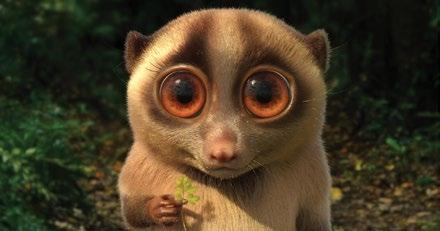
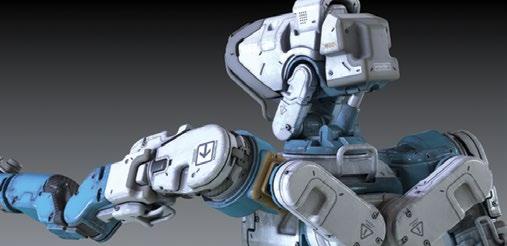
For starters, the retopology tool has been given some refinements. This has been around for a couple of versions, but you now have more control over what you want and how you want to preserve edges and features. You can either determine edges based on an angle tolerance or you can identify edges with Component Tags in the input mesh shape, and then list them in the field in the Retopology interface. (Houdini users should be very familiar with these types of tagging and manipulating data.) Further, you have access to the input mesh and the retopo’d mesh in the viewport. With this, you can pause the retopology function and make adjustments to
The Make Live function — which allows users to activate a mesh surface and have things snap to it — has been updated so you can work with multiple meshes at the same time. One, often used, method is building new quad edge flows on dense models by snapping new vertices to the surface and building a new poly. Users can now build new meshes across objects. For example, if you had a separate forearm and hand, you can now build one full arm with continuous geometry.
The Graph Editor Curve Sculpting tools are pretty sweet. When you have an animation curve with a ton of vertices, it can be a major pain to manually adjust. These Sculpting tools act like Photoshop or ZBrush tools, using a brush size and strength (with pressure), you can make soft adjustments to the curve by grabbing, smearing or smoothing out the points.
A new shader system called LookdevX has been added to this version of Maya that is specifically designed to build shaders that are compatible with USB scenes. This allows for the look dev of your models and scenes to be compatible with other programs that support the USD format. You can use the USD preview shaders or you can dev in either Arnold or MaterialX.
Other updates include: Rigging and Animation tools for easier weighting and countering double transforms with counter matrices (which I’m not even going to try and explain because I’ll probably get it wrong), additional time slide and graph advances on top of the Sculpt Tools, additions to Bifrost which deserves a review unto itself, more
www.animationmagazine.net 108 jun|jul 23 VFX & TECH
Courtesy of Fausto De Martini
Courtesy of Olga Dannik
Substance support, and more robust integration for the Apple Silicon architecture.
Website: autodesk.com/products/maya

Price: $1,875 (annual); $235 (monthly)
FumeFX 6.0
My last review for FumeFX was way back in 2019, yes, pre-COVID times. Zagrebbased Kresimir Tkalcec and his team at Sitni Sati have been hard at work revamping FumeFX 6.0 into a product that offers much more than fluid-based fire, smoke and explosions. This is a brand new world!
out the simulations and then warp them with modifiers. The sims data can be manipulated with effectors. Sims can happen across overlapping grids — so you can have an array of smaller grids for something long like a missile trail instead of one huge grid. Sims can be refined post-sim to add more detail after a base sim has been approved without changing the base sim. The display is GPU-accelerated to get as close to the final render in the viewport as possible.
Now, for a review for what it wasn’t before! FumeFX is now a node-based, multi-physics system that resembles Houdini’s Vellum or Thinking Particles or TyFlow or Bifrost – which then interacts with the FumeFX fluids. This is an ambitious step, folks!
the interoperability of the particle and dynamics systems with the fluid dynamics. Having the systems all working together elevates not only the realism of the simulations, but also the efficiency by removing steps in the process.
First up, the familiar functions: FumeFX is still a QCG fluid solver with controls for combustion, fuel, vorticity and oxygen levels. You can cache
NodeWorks is a way to create particles and physics simulations through a system of function nodes tied together into a complex script of events. Anyone who has used the tools listed above will be completely familiar with the process. There is no argument about the power and flexibility of using this workflow. There are 140 nodes as of this initial release which include particles, particle modifiers, fibers (for cloth and rope), PhysX for rigid body dynamics, math operators, caching, Fume fluids (of course), and much more.
The largest benefit of using FumeFX lies in

I’m reviewing the 3ds Max version of FumeFX 6, but there will also be builds for Maya and Cinema 4D. No one will feel excluded (Houdini users will, frankly, be doing fine without a Houdini build). Supporting each of the DCCs expands the ability for Max-centric or C4D-centric artists and houses to generate higher-end simulations. I’m not going to sugarcoat the fact that FumeFX is jumping back into a competitive race of similar tools that have gotten a toe-hold into the industry. The current promo price is less than, say, TyFlow Pro + Phoenix, and certainly less than a license of Houdini FX. But I like these guys, and I’ve been rooting for them since they created Afterburn for Max back in the day.
Website: afterworks.com/FumeFX.asp
Price: $295 (one year); $495 (two years)
Todd Sheridan Perry is an award-winning VFX supervisor and digital artist whose credits include Black Panther, Avengers: Age of Ultron, The Christmas Chronicles and For All Mankind. You can reach him at todd@teaspoonvfx.com.
jun|jul 23 109 www.animationmagazine.net
VFX & TECH
Courtesy of Iloura
Hitting the Right Notes
The popular Given anime series and movies offer a different take on high school romance.
- By Charles Solomon -
Atypical BL (“boy’s love”) romance is as predictable as your typical Hollywood rom-com. A senpai (upper classman/corporate superior) falls for a cute kohai (lower classman/ corporate junior). The kohai is awed by his senpai’s good looks and self-assurance. An overwrought confession of love by one partner causes the other to puzzle over his response to a same-sex declaration of affection. After a few misgivings and misunderstandings, everything is resolved, and they live happily ever after.

In her music-themed BL tale Given, Natsuki Kizu avoids the clichés of the genre to tell a more interesting story about believable characters. No wonder it’s remained popular in various media since the manga was first serialized in Chéri+ magazine in 2013. The first animated series was directed by Hikaru Yamaguchi, produced by studio Lerche and debuted on Fuji TV four years ago. Mina Osawa was the show’s character designer.
The 11-part series centered on high school student Uenoyama Ritsuka, a guitar prodigy. He plays in a band with two college students. But his technical skills can’t disguise that he’s losing his edge: Music no longer excites him the way it used to. School and his fellow students excite him even less.
Music of the Heart
When he sneaks out of class to his favorite spot for a covert nap, he finds Mafuyu Sato, a kid from another classroom waiting for him. Although he uses very few words, Mafuyu wants to know if his Gibson guitar can be fixed. It can: Ritsuka grumpily replaces the broken strings.

Mafuyu asks Ritsuka to teach him to play. He refuses — he’s never taught anyone, he doesn’t how to teach … but he can’t resist Mafuyu’s pleading stare.
Mafuyu progresses rapidly. The blisters and callouses on his fingers reveal how hard he’s practicing. When Mafuyu sings a melody that’s haunting him, Ritsuka is shaken by the intensity and power of his voice. He invites him to join the
band. The other band members tell Ritsuka his pupil’s style is starting to affect his own. The bond between Ritsuka and Mafuyu grows stronger but remains unspoken. While Mafuyu struggles to write lyrics to the melody, Ritsuka discovers his friend’s back story. His boyfriend in middle school was an aspiring musician who killed himself. Mafuyu comes to terms with his past in the lyrics: He mourns the partner who lives on in his memory — and acknowledges that his loneliness will end when he finds a new love. Ritsuka helps his friend off stage after his emotional performance. As Mafuyu thanks him for teaching him so much, Ritsuka’s suppressed feelings crystalize in a first kiss.
A less talented writer would overplay the scene with too much build-up leading to a too-certain conclusion. Kizu underplays. Rit-
Given (TV series, 2019)
Given (original movie, 2020)
Given: On the Other Hand (OVA, 2021)
suka realizes that he’s in love for the first time and that Mafuyu loves him. But they’re not ready to shop for rings. Their emotions are still raw and uncertain, as a 16-year old’s would be. They both recognize they’re at the beginning of a relationship: Neither one pretends to know where it will go. They’re together and they’re happy, and for now, that’s enough. Ritsuka and Mafuyu don’t conform to the senpai/kohai pattern. They’re talented young men who bond through their music. Mafuyu is less experienced as a musician, but the death of his boyfriend brought him a maturity Ritsuka lacks. Ritsuka has been struggling to find himself; music seemed unsatisfying because he was coming to terms with complex emotions.
Both the animated (2019) and live-action (2021) Given TV series adapt the first two books of the manga. The 11 episodes of the anime give Mafuyu more time to develop his chops as a musician. But he begins as such a monosyllabic, understated character, he nearly fades into the backgrounds. In the six episode live-action version, rapper Sanari may lack the pretty boy looks of Mafuyu in Kizu’s drawings, but he commands a much more powerful voice than actor Shougo Yano in the anime. When Sanari sings the notes that haunt him, the audience hears the strength and sorrow that knock Ritsuka off his perch.
The OAV, Given: On the Other Hand (2021) is a minor follow-up: It shows Ritsuka and Mafuyu beginning to date, stealing a smooch in a deserted classroom during summer school. The Given movie (2020) focuses on the other two band members, drummer Akihiko Kaji and bass player Haruki Nakayama. Akihiko, who’s apparently been in more beds than a motel sheet, keeps trying to break up with his first lover, an obnoxious violin prodigy, while Haruki pines for him. After a lot of melodrama, they end up together — to no one’s surprise.

Given TV (live-action miniseries, 2021)
[All stream on Crunchyroll]
Given by Natsuki Kizu (Sublime Manga: six volumes, $17.99 each)
In early spring, plans for a new Given feature were announced with a teaser trailer. With any luck, the new film will shift the focus back to the more likable Ritsuka and Mafuyu. ◆
www.animationmagazine.net 110 jun|jul 23 HOME ENTERTAINMENT
The musicthemed Given franchise first premiered in 2019 based on a manga by Natsuki Kizu.
WWW.CARTOON-MEDIA.EU


EUROPEAN CO-PRODUCTION FORUM
FOR ANIMATION TV SERIES
A DAY IN THE LIFE
This month, we catch up with popular Toon Town mover and shaker Cort Lane, who is eOne’s development VP and exec producer on the show My Little Pony: Make Your Mark. The pics depict a big crunch day as the team puts the finishing touches on the 40th anniversary special, Bridlewoodstock, with teams in four cities across three countries. The special launches June 6 on Netflix.
6:45 a.m. It’s time to make breakfast with my three tiny tyrants supervising.
10 a.m. Weekly creative review with our brilliant Atomic Cartoons partners in Vancouver. Loving the final VFX renders from our director, Will Lau.

7:30 a.m. Working with our brand team in London means early morning Teams updates from home. Swooning over promo art of our Bridlewoodstock celebrity guest, Sofia Wylie, who voices Ruby Jubilee.

11:30a.m. Co-exec producer Tristan Homer updates me on Bridlewoodstock QC fixes from our Toronto office.
9 a.m. Arrive! My team (Alex and Erin) and I work out of Hasbro’s epic Burbank, Calif. office.



8
2:30 p.m. A threehour time difference means files come in for afternoon review. Final premix of the Bridlewoodstock special means the last review for this exec!
6:30 p.m. Playtime at home! My three pups attack daddy to get their energy out at the end of a long day for all of us.


12 p.m. Playtime at work! Alex and I ran upstairs for an update from the toy team on pony toys inspired by the special.
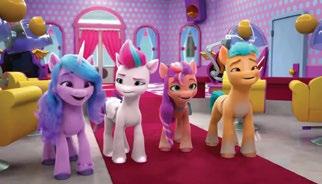

www.animationmagazine.net 112 jun|jul 23
2
1 4
3
5 6
7










































































































































































































































































 - By Devin Nealy -
- By Devin Nealy -


































 - By Tom McLean -
- By Tom McLean -










 - By Charles Solomon -
- By Charles Solomon -




















 - By Karen Idelson -
- By Karen Idelson -



 - By Ramin Zahed -
- By Ramin Zahed -






























































 - By Ramin Zahed -
- By Ramin Zahed -











 Michael Hefferon
Michael Hefferon




 Heath Kenny
Octicorn
A Mouse Called Julian
Tales of the Underwear Dragon
Heath Kenny
Octicorn
A Mouse Called Julian
Tales of the Underwear Dragon



























 - By Kévin Giraud -
- By Kévin Giraud -































































 - By Mary Bredin -
- By Mary Bredin -



 - By Trevor Hogg -
- By Trevor Hogg -



 By Todd Sheridan Perry
By Todd Sheridan Perry





























































